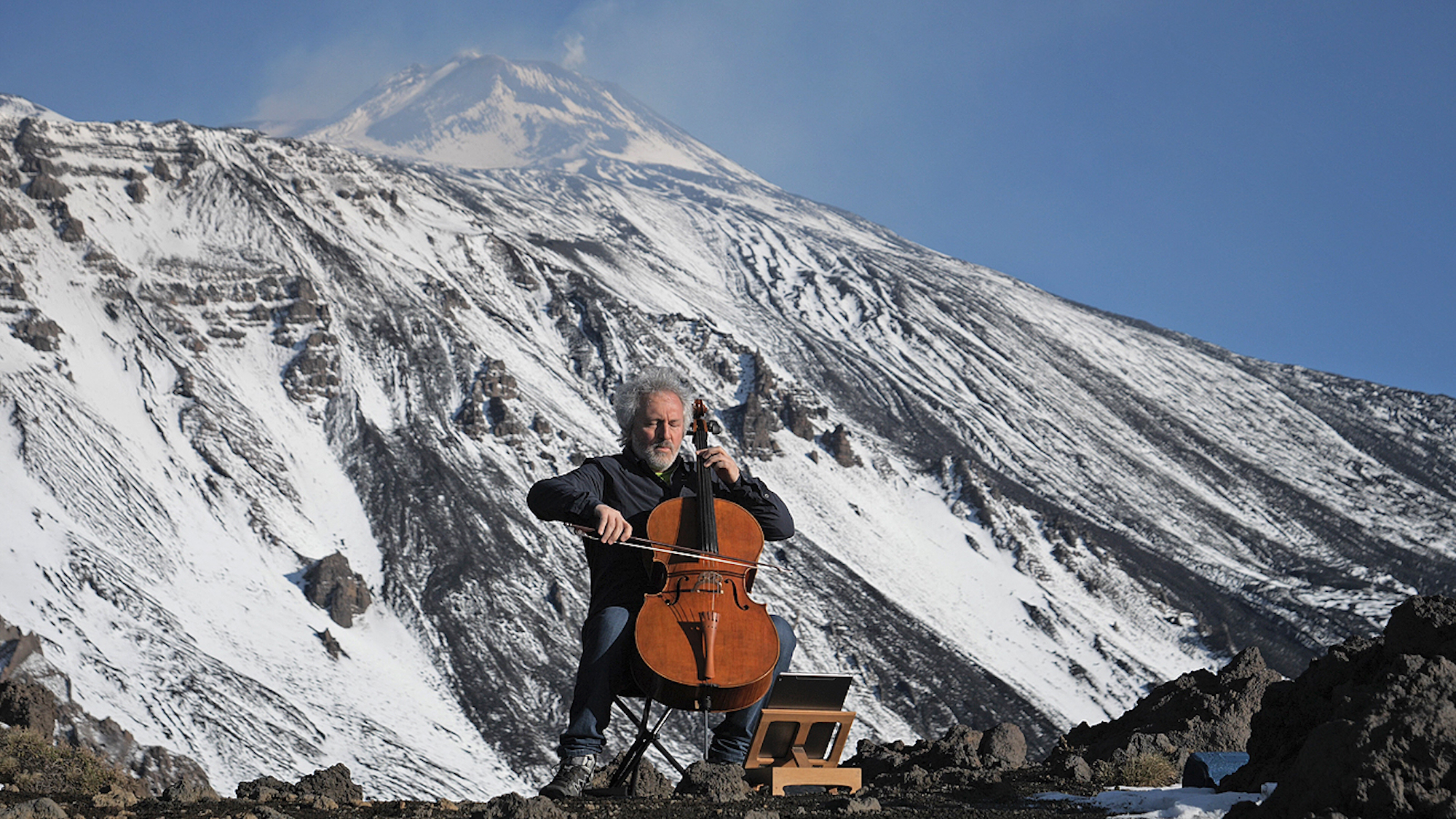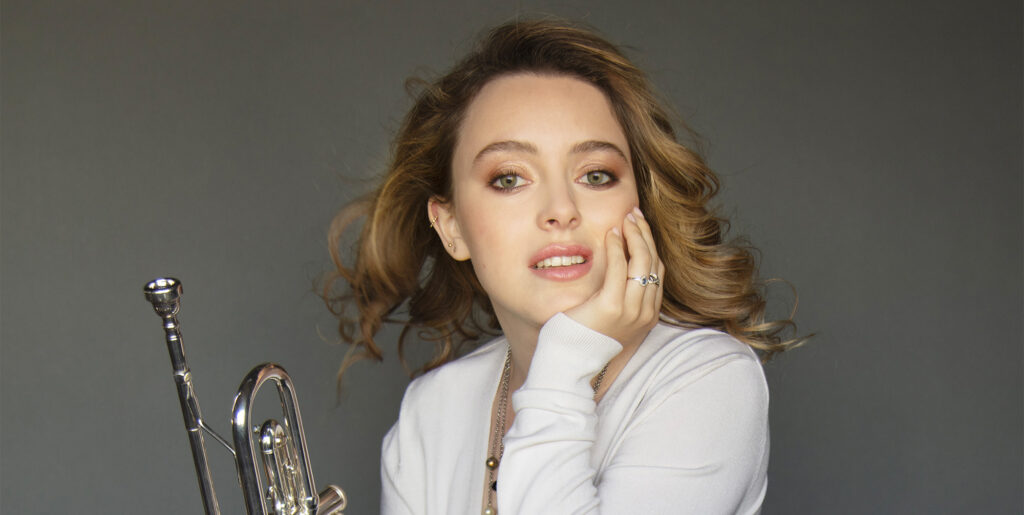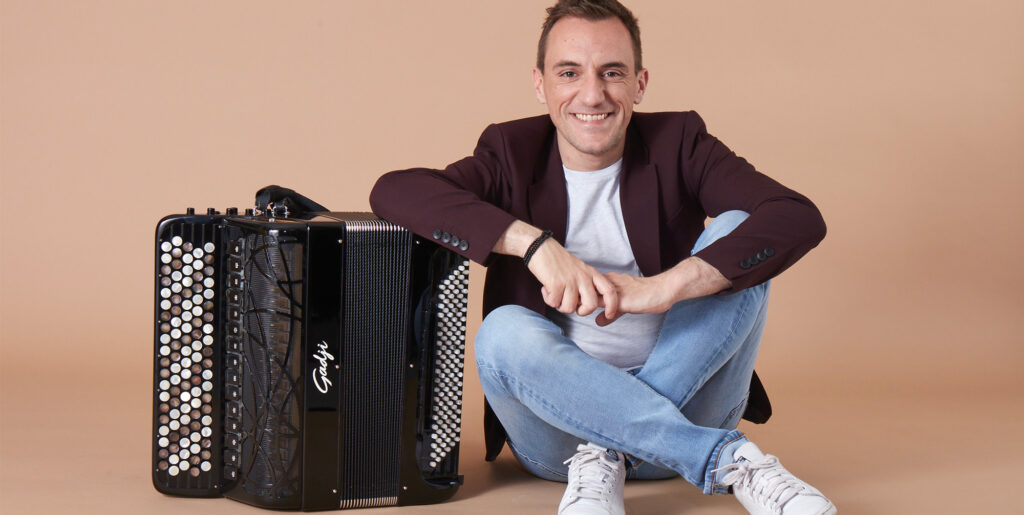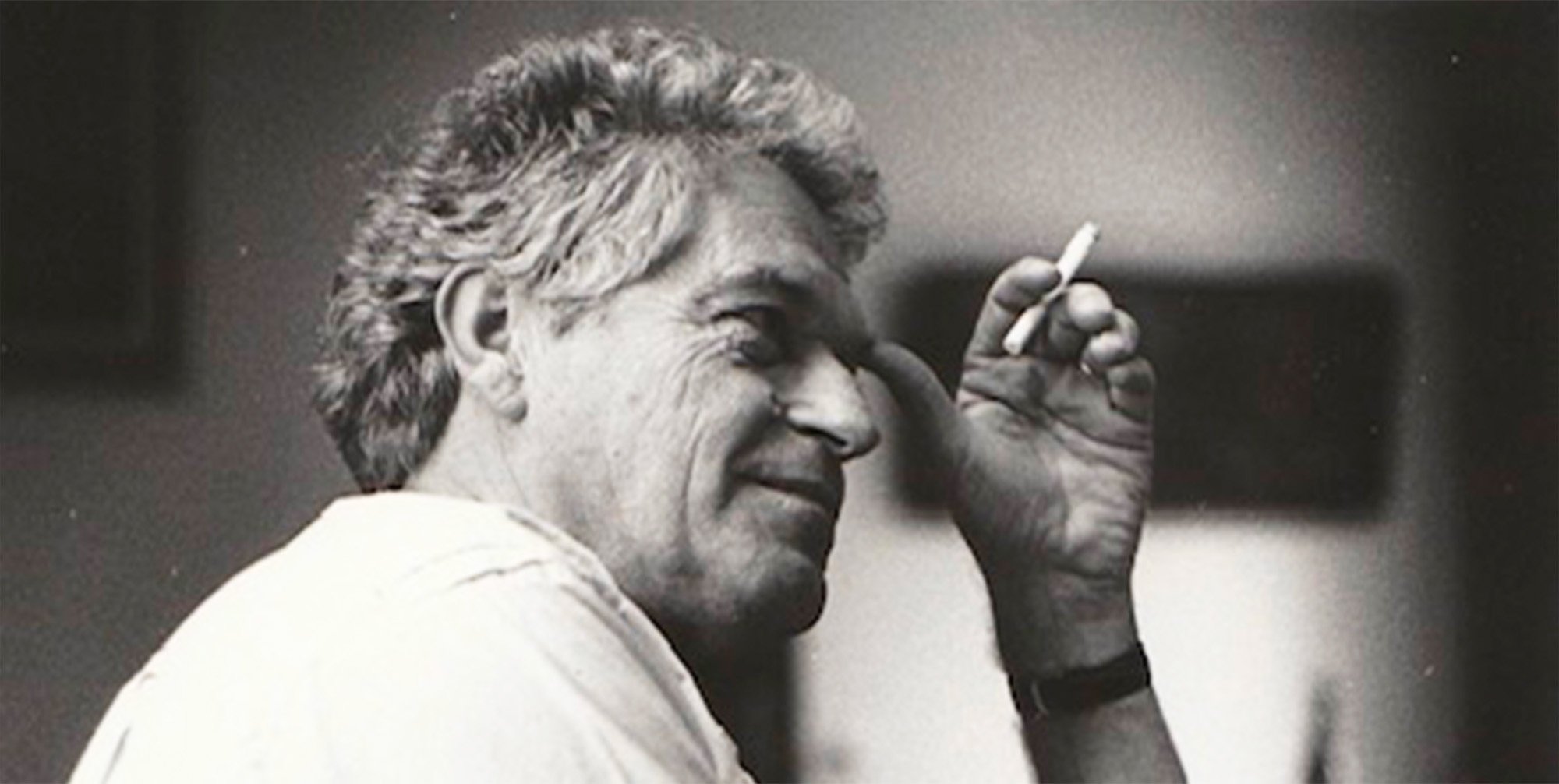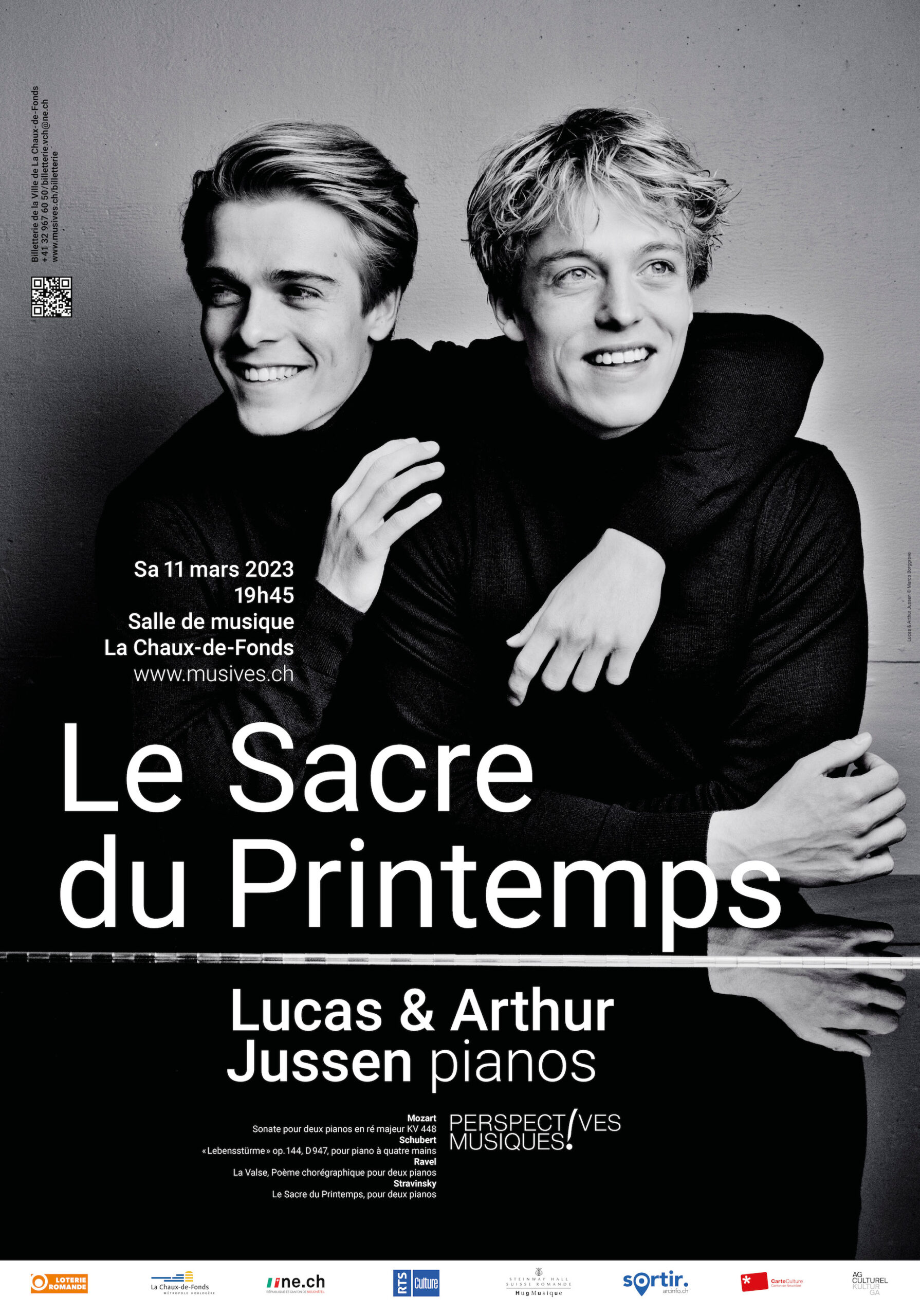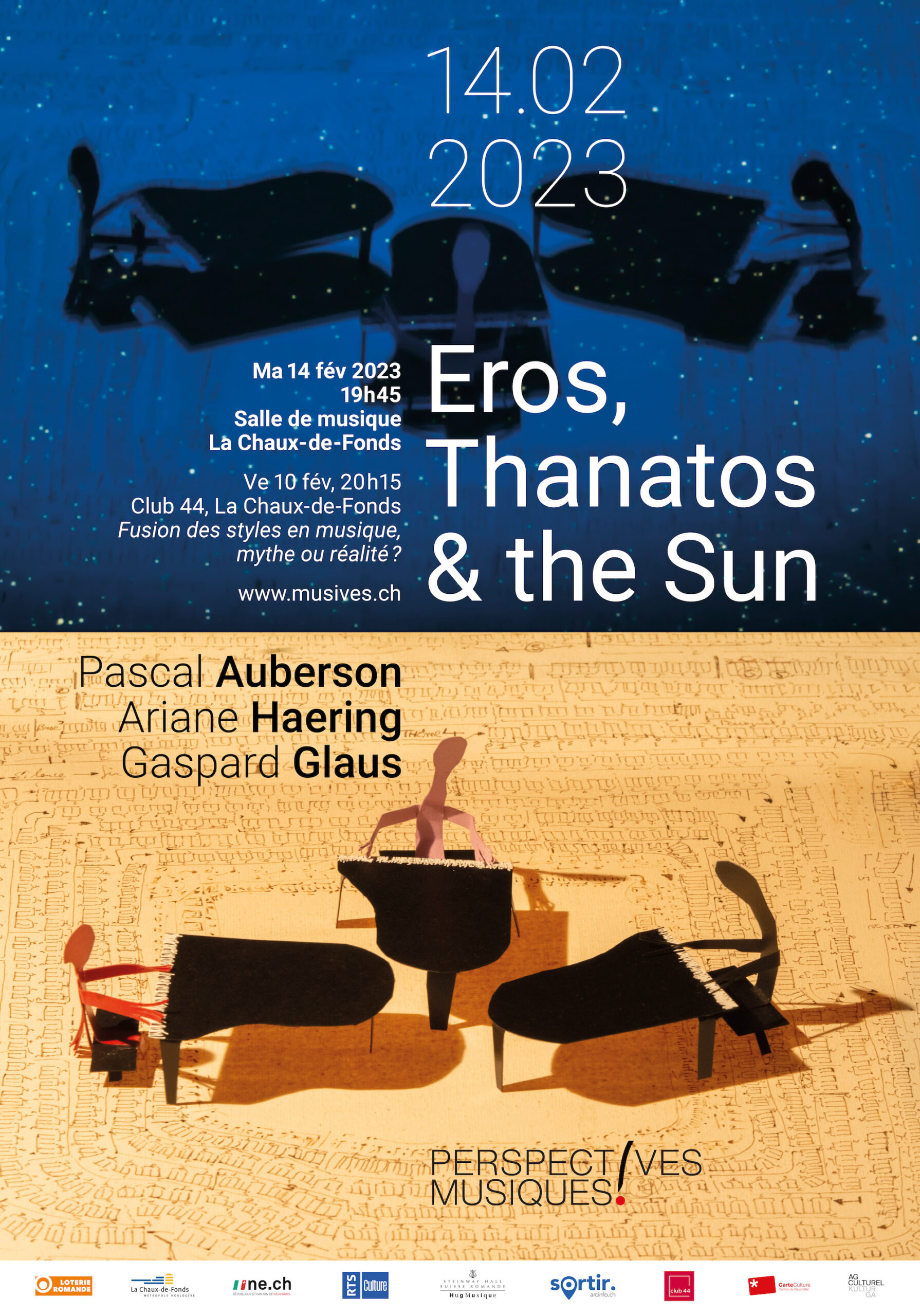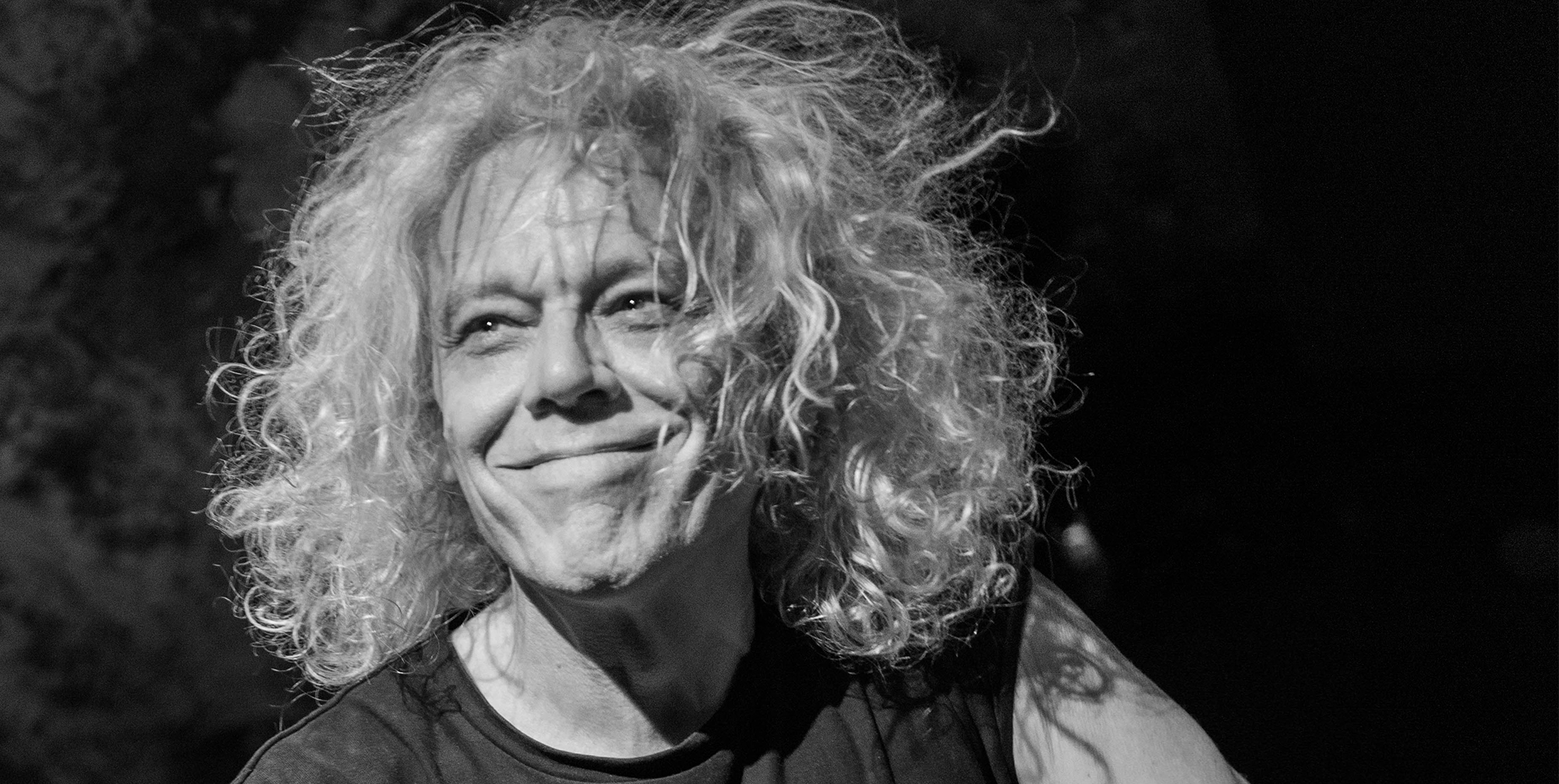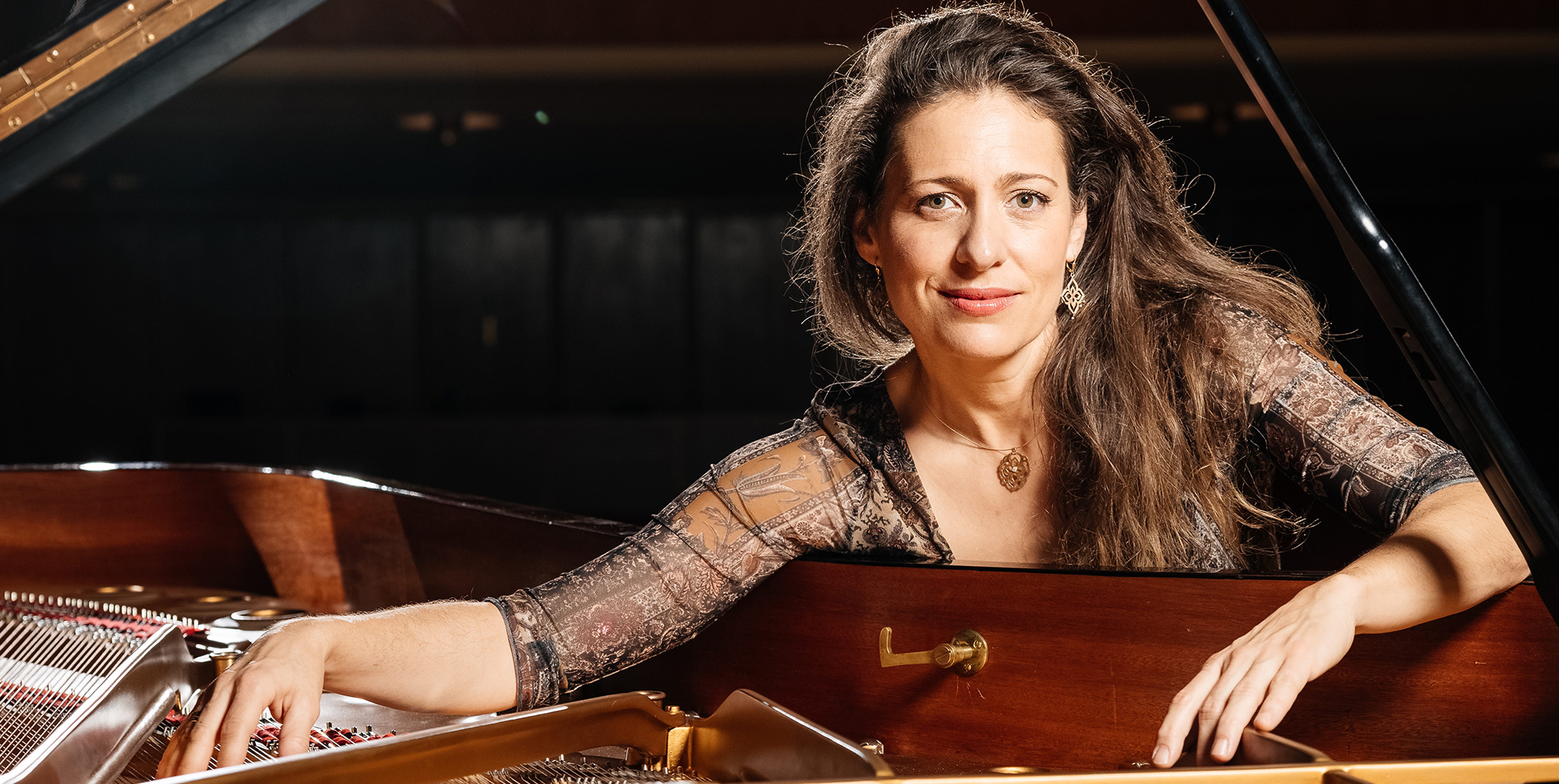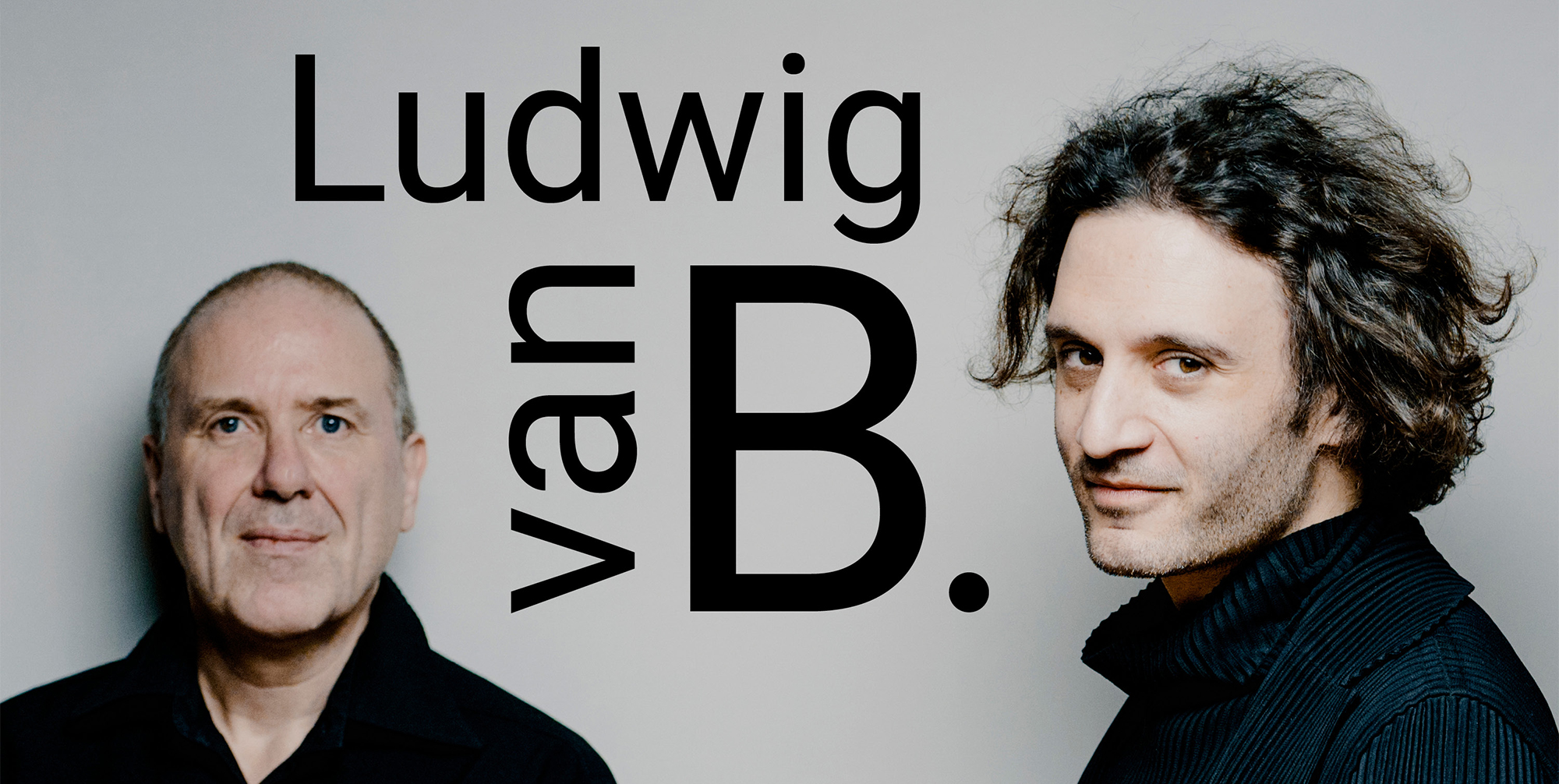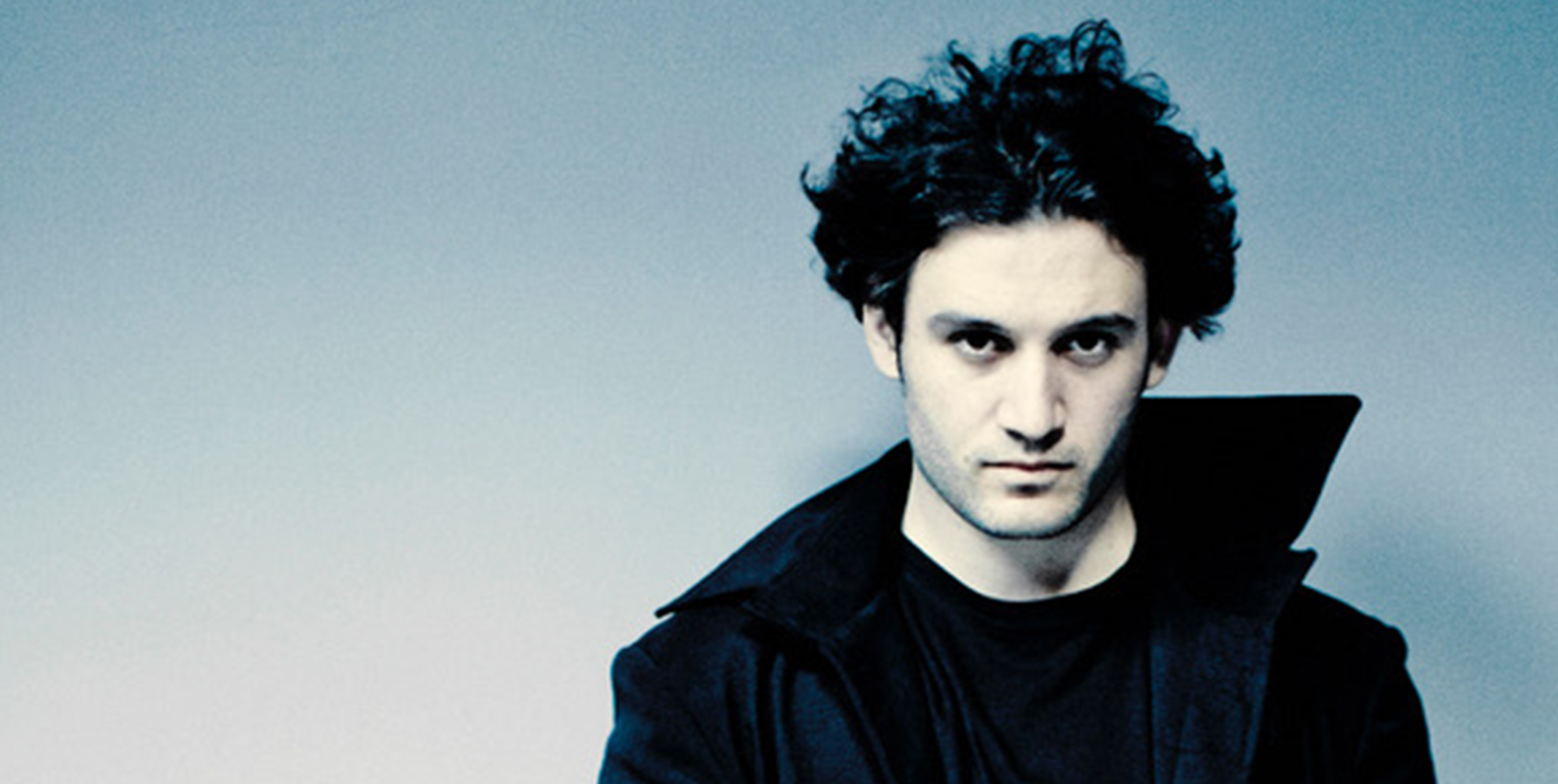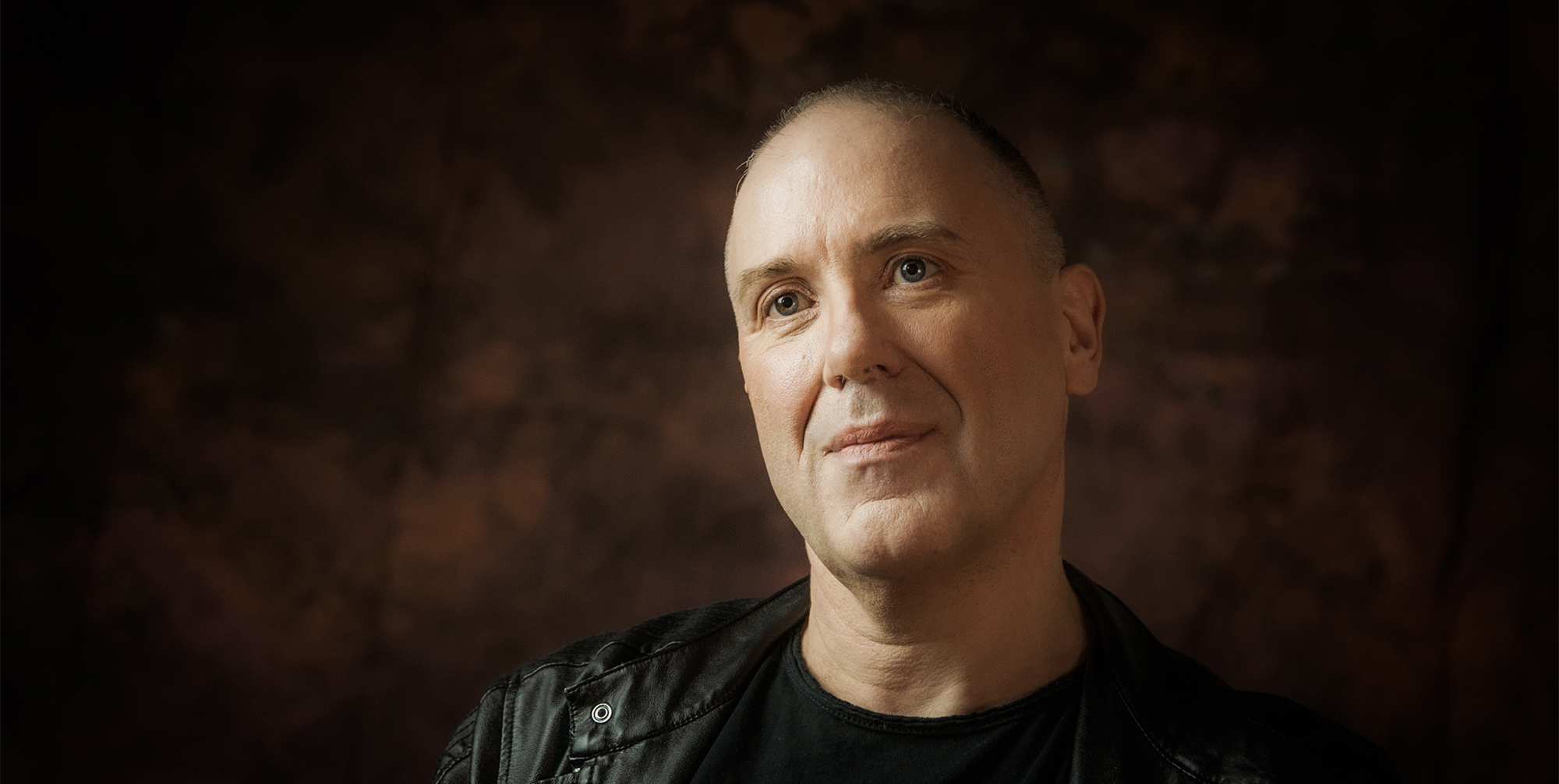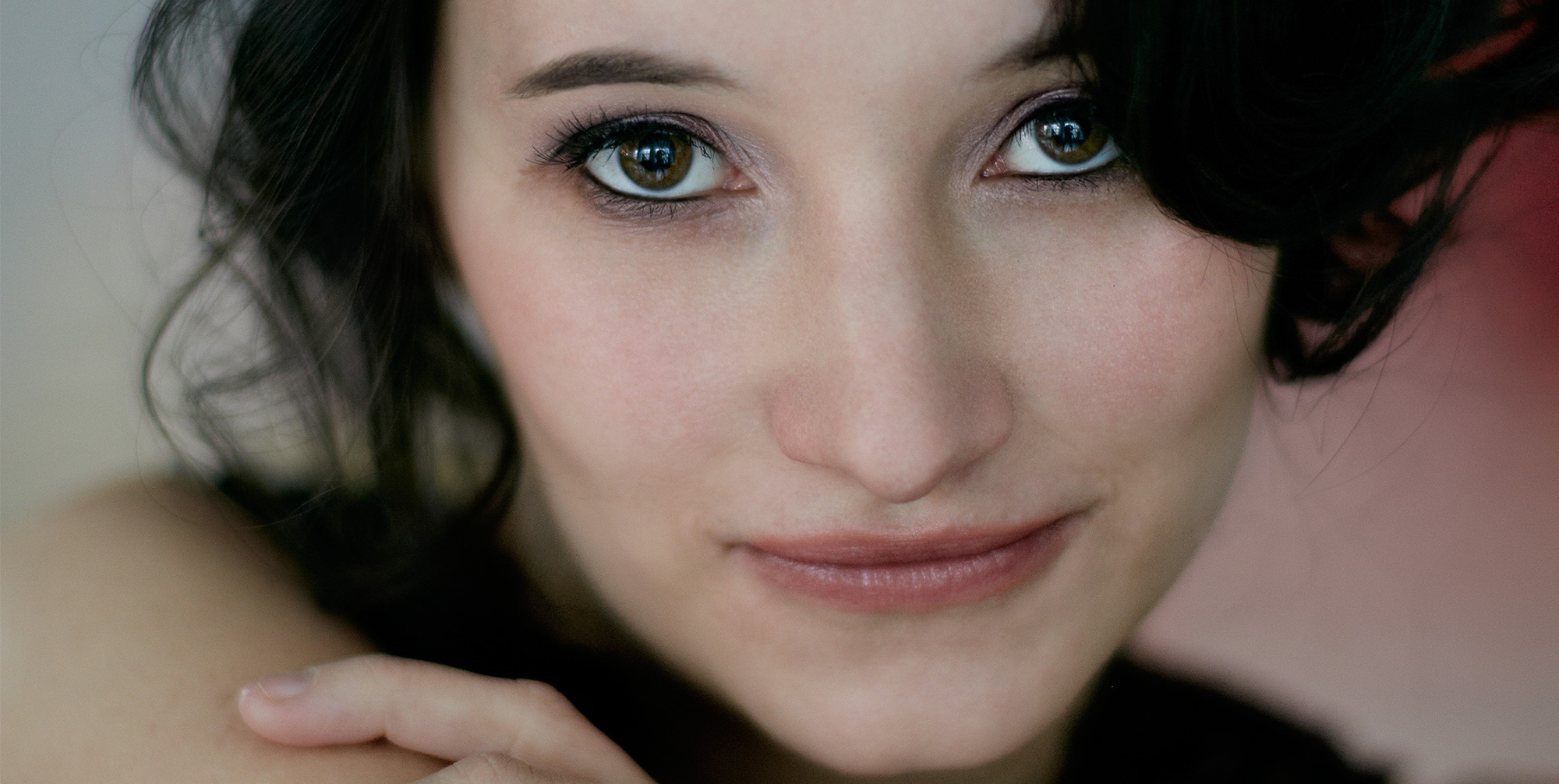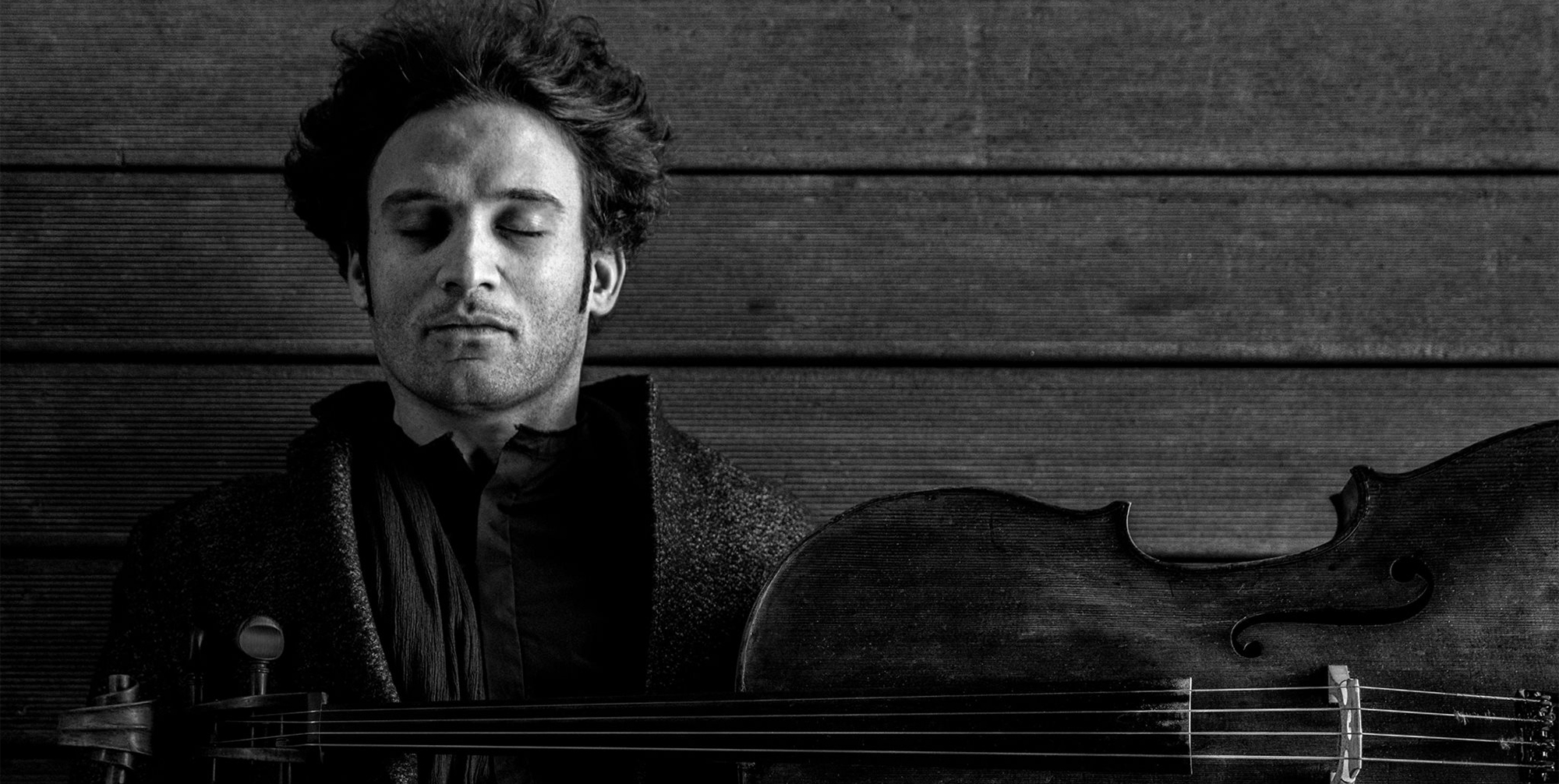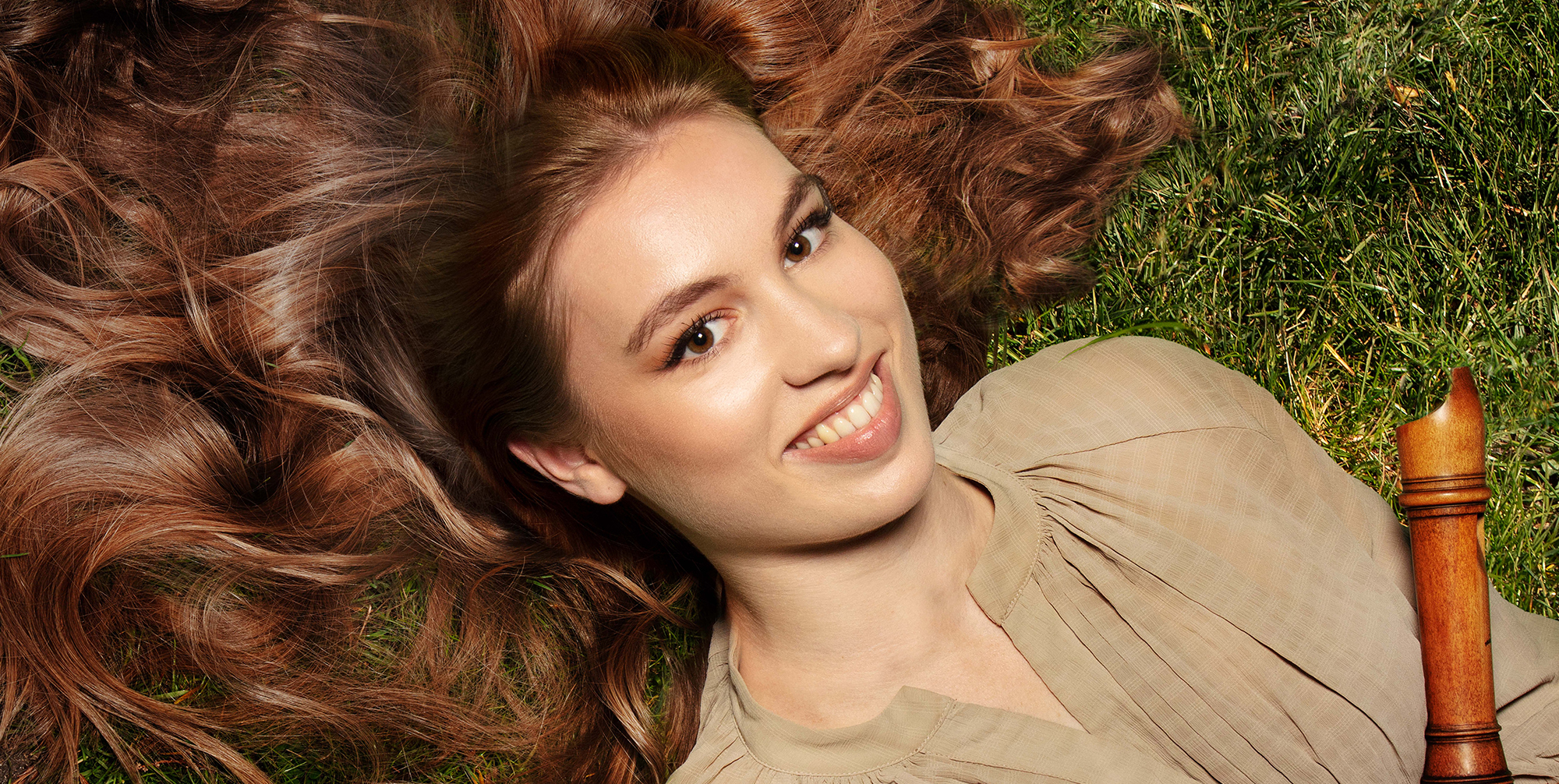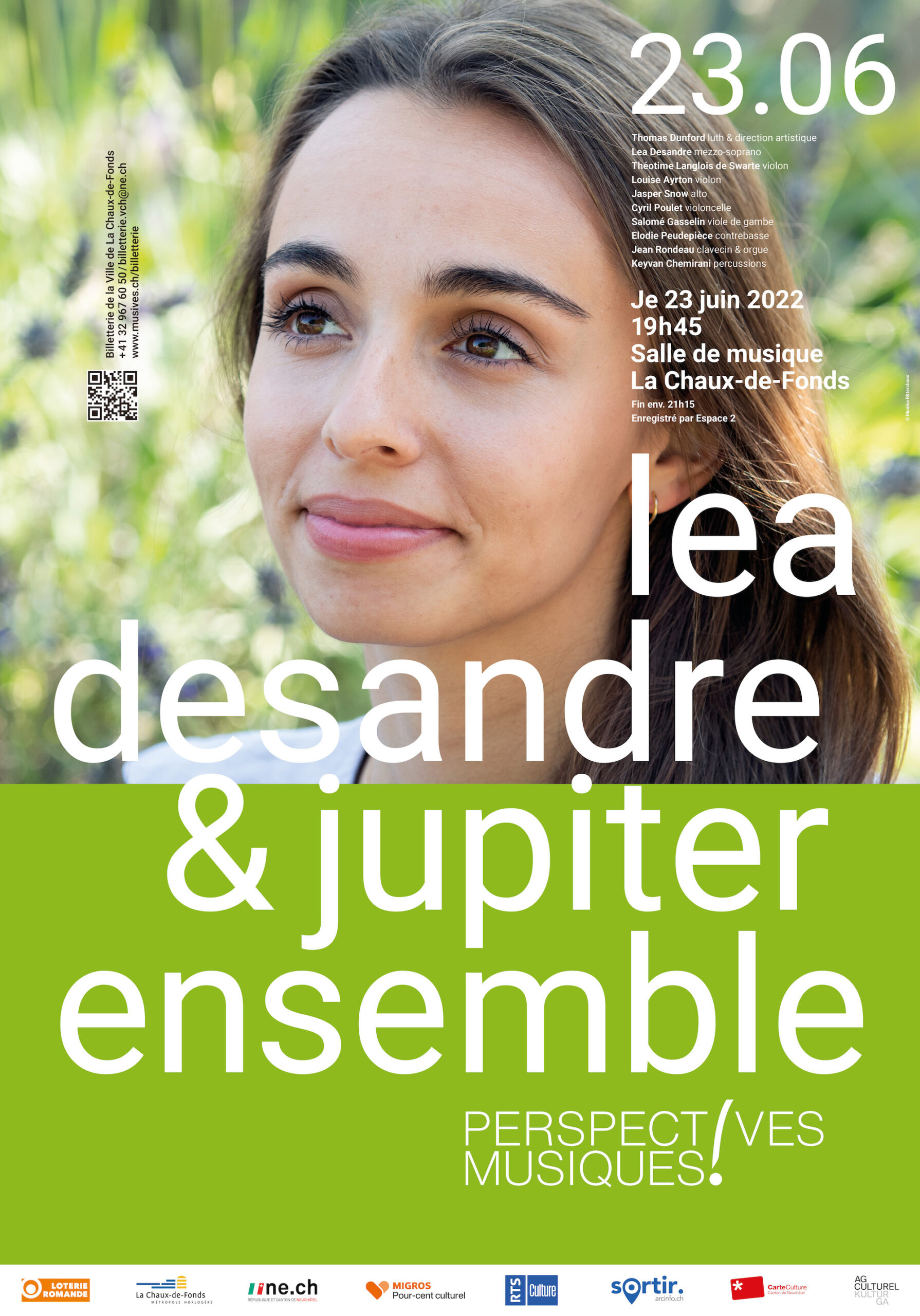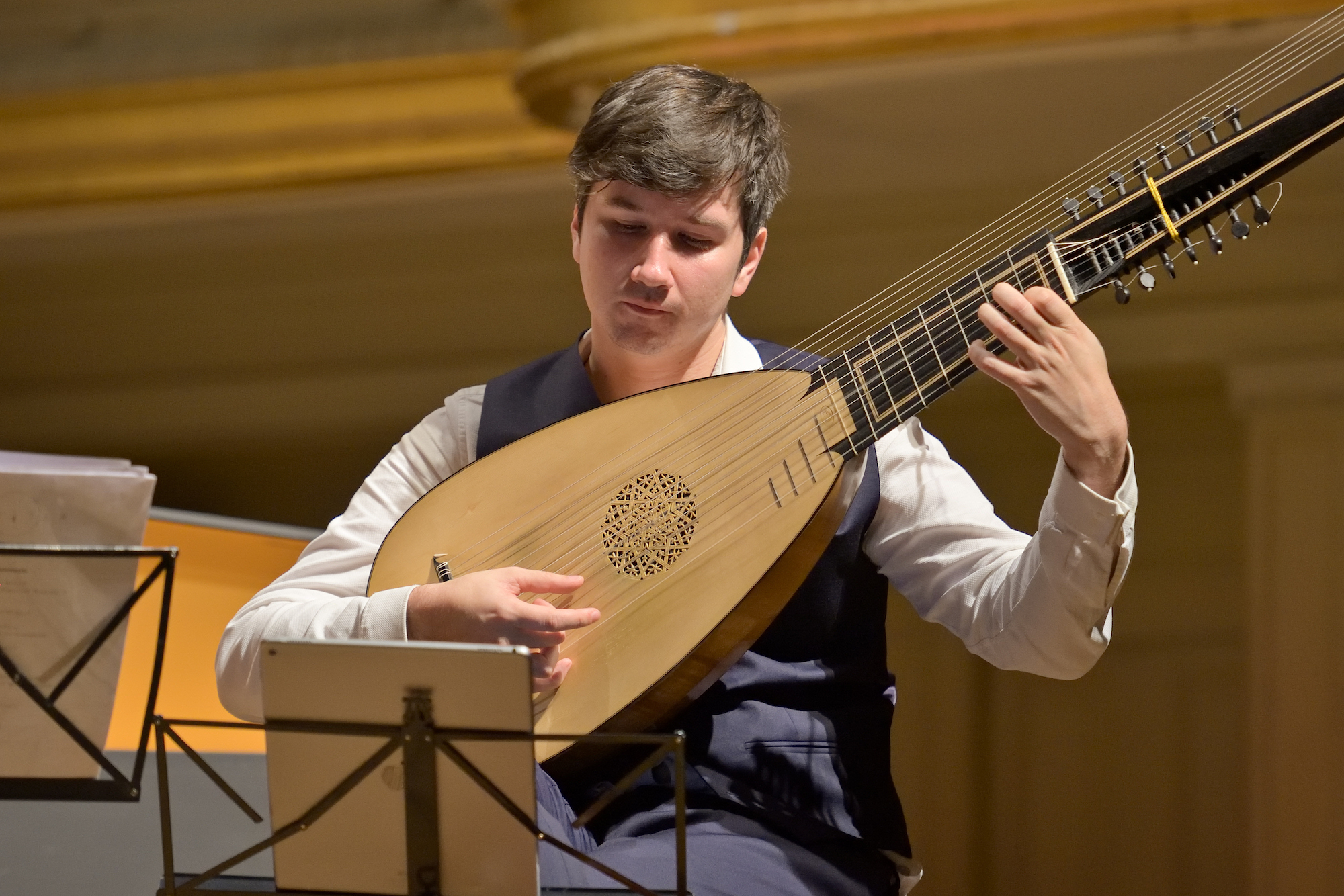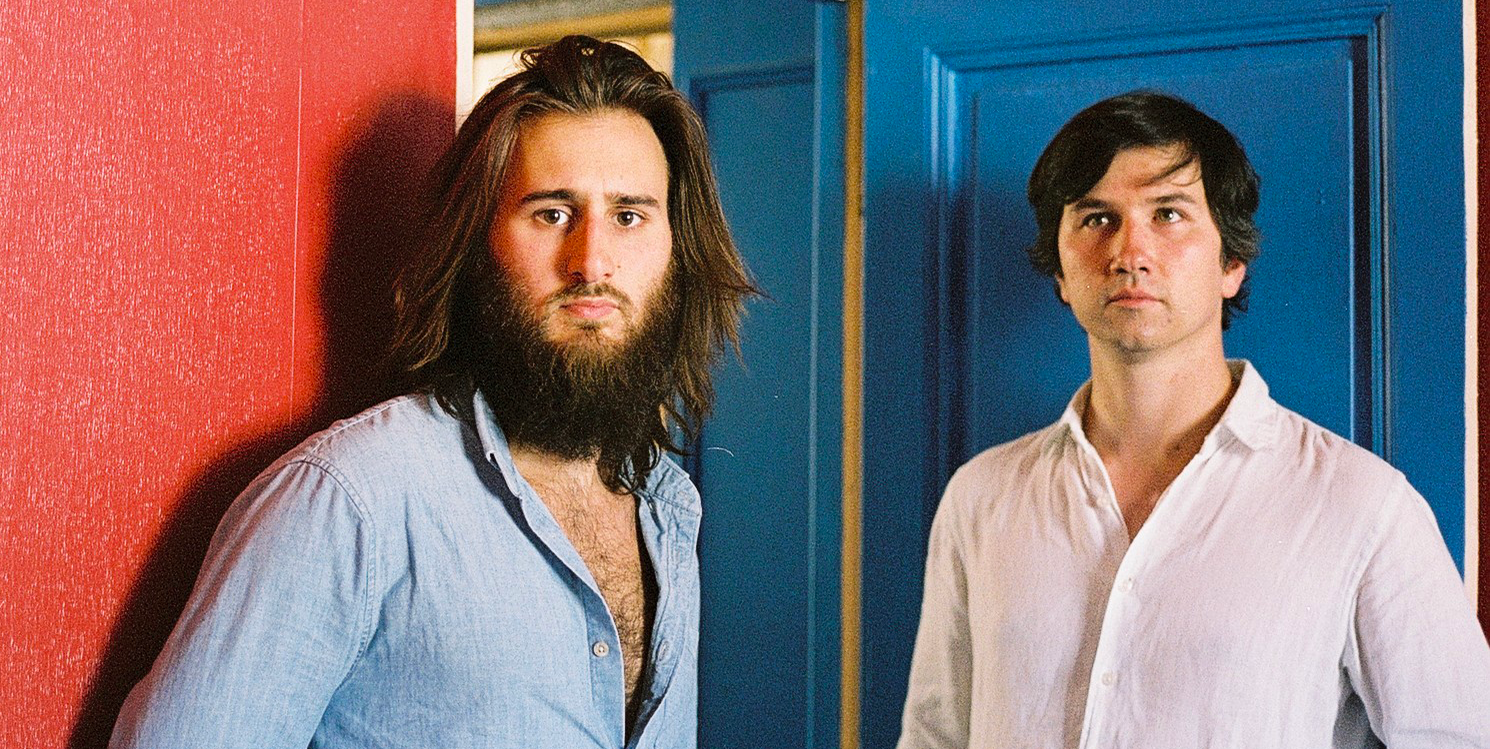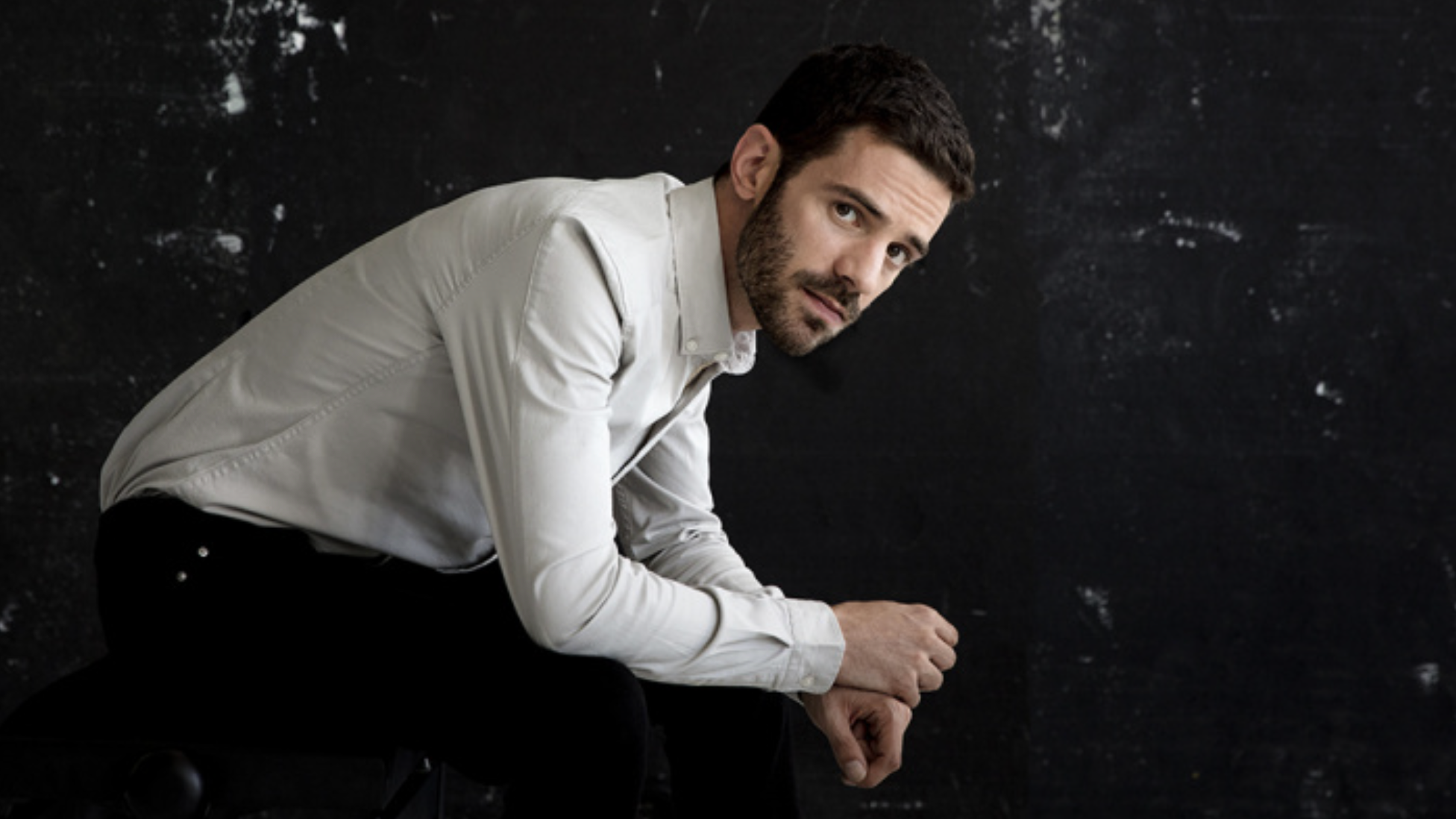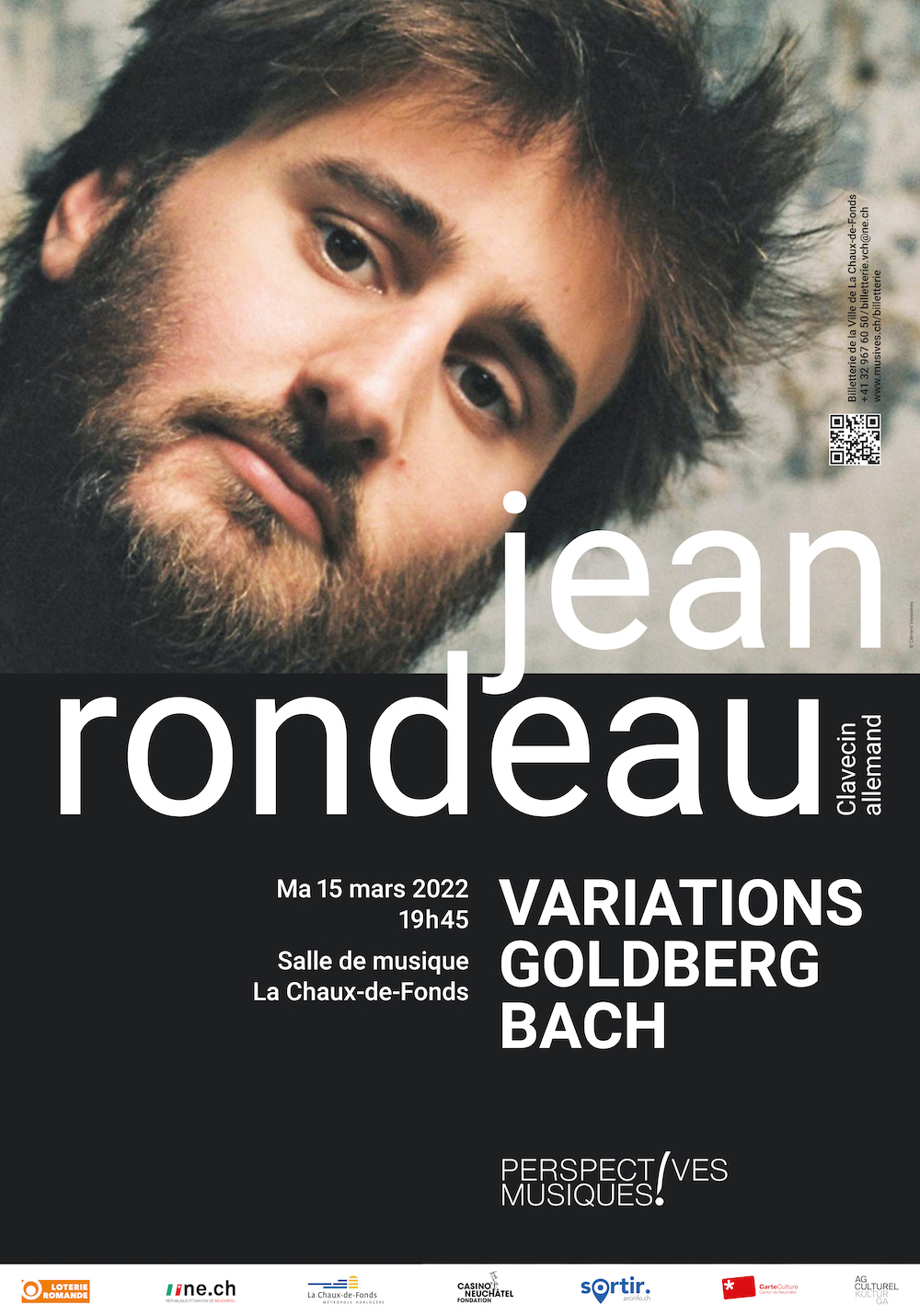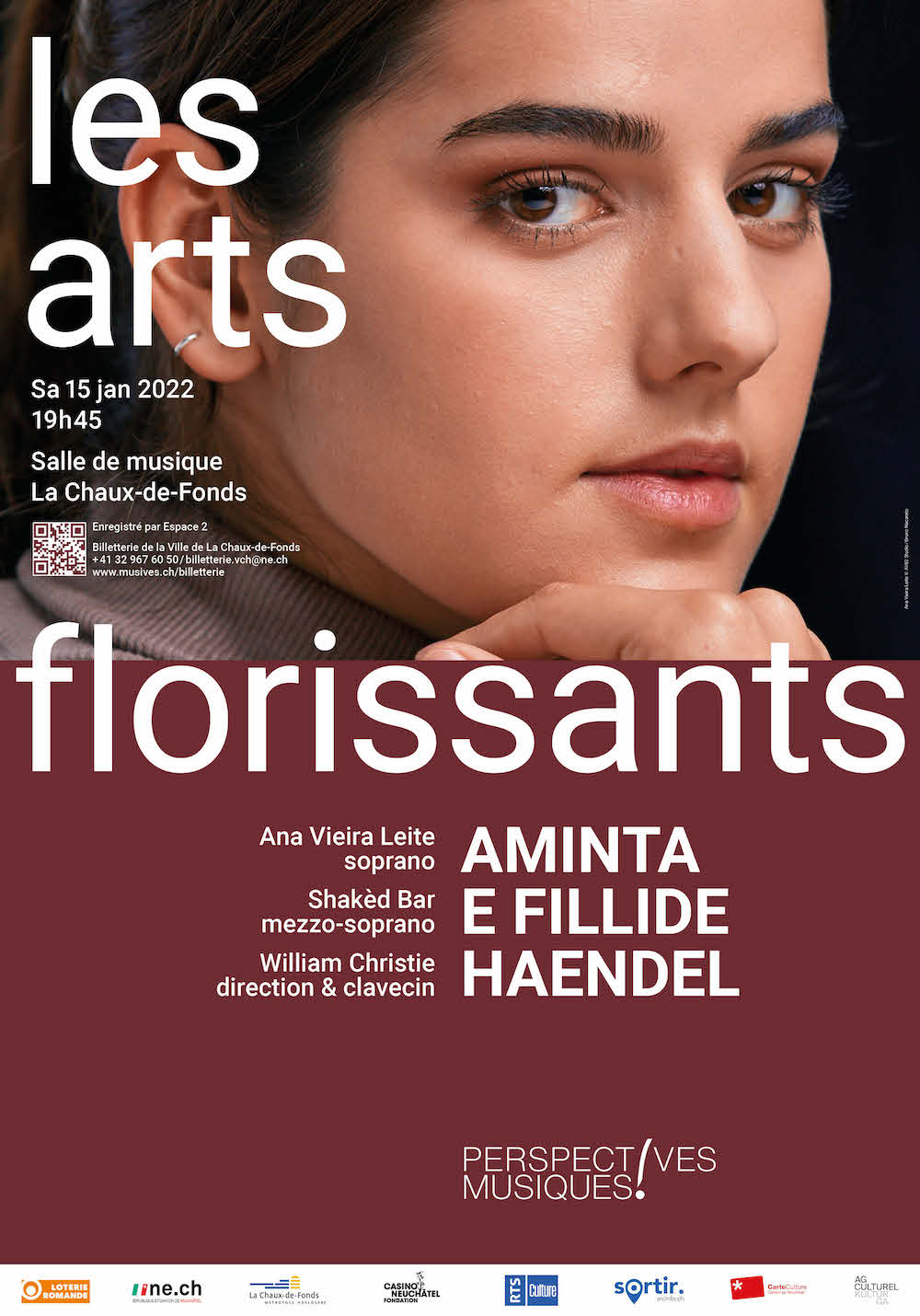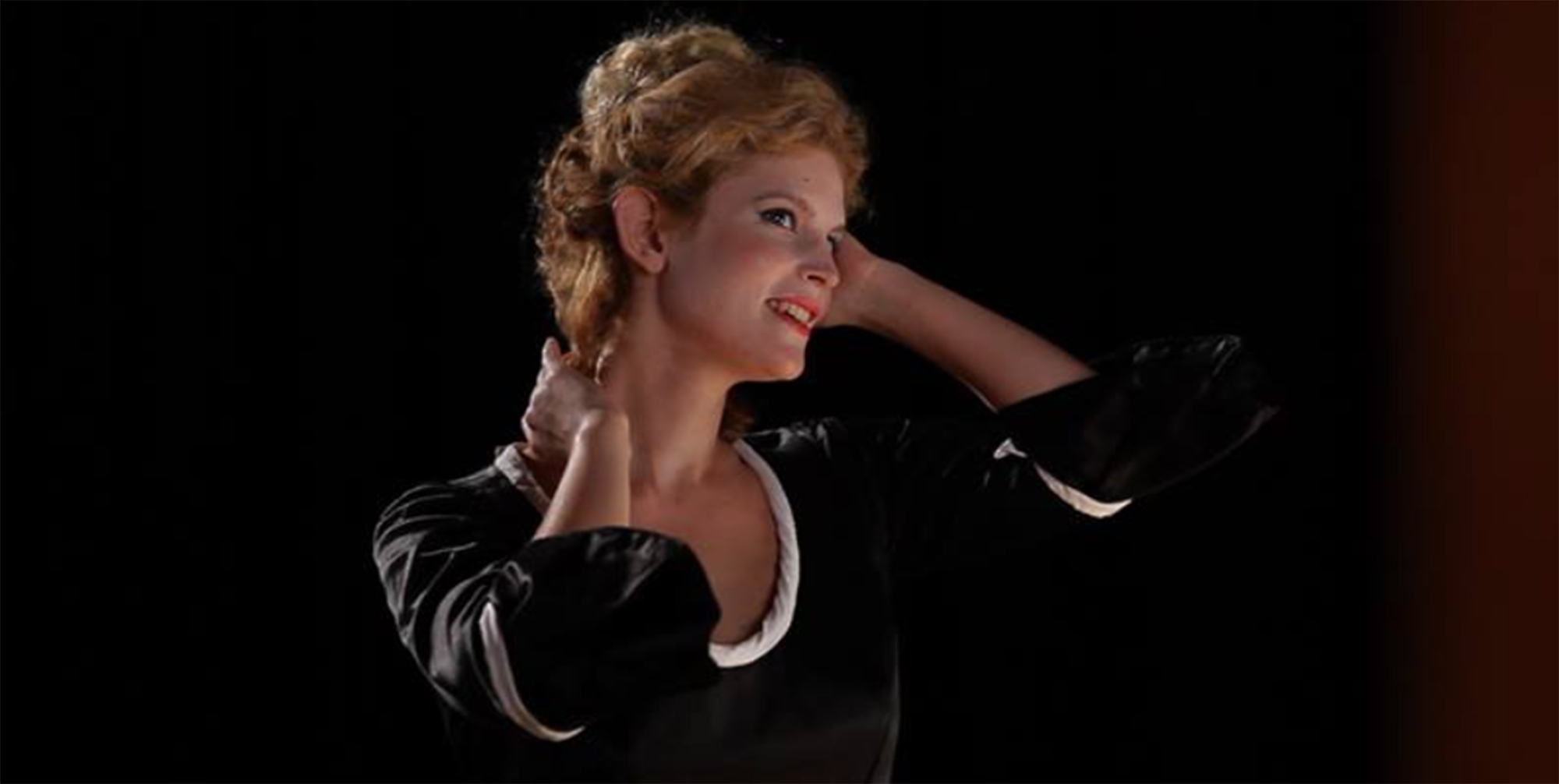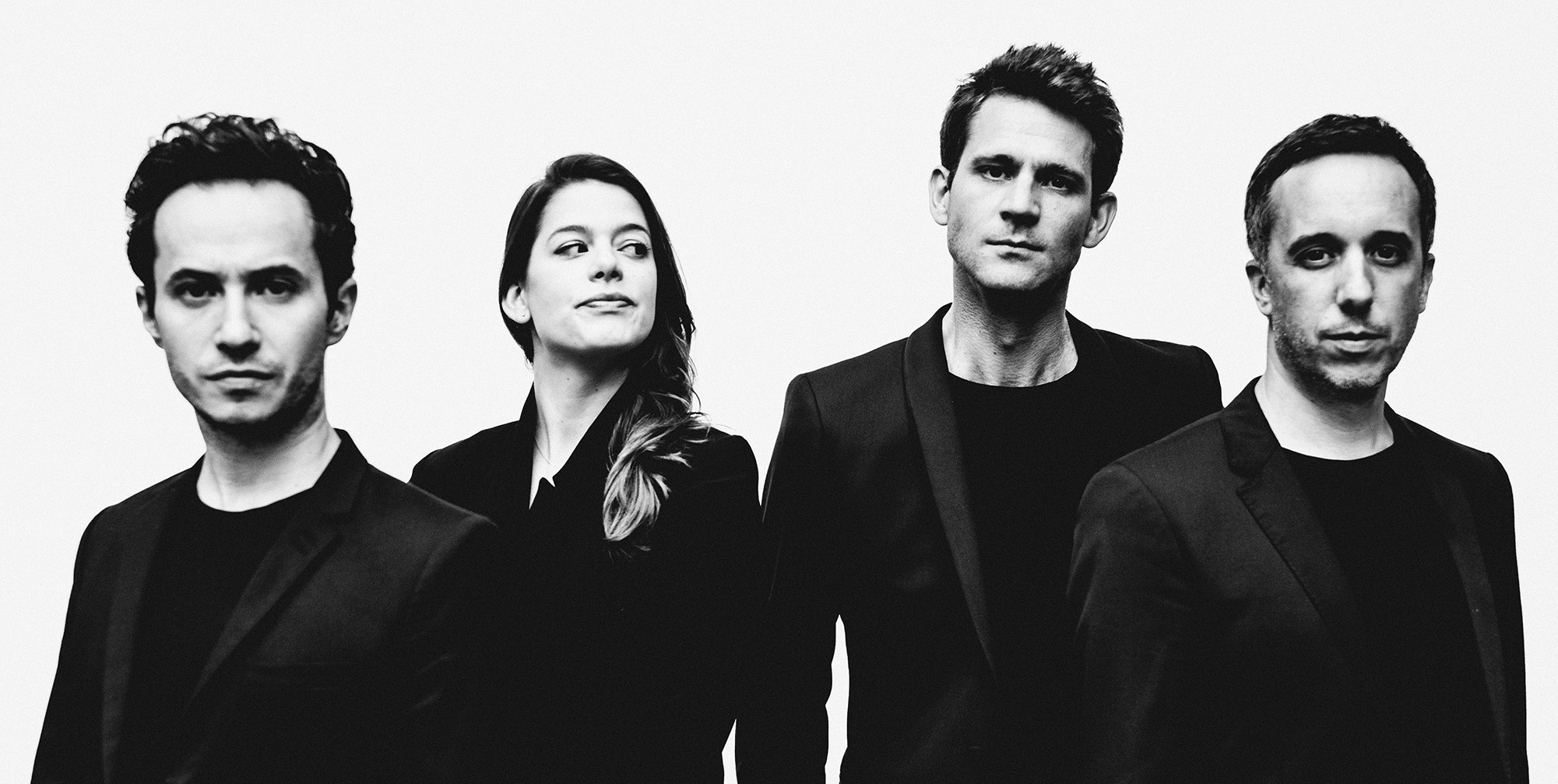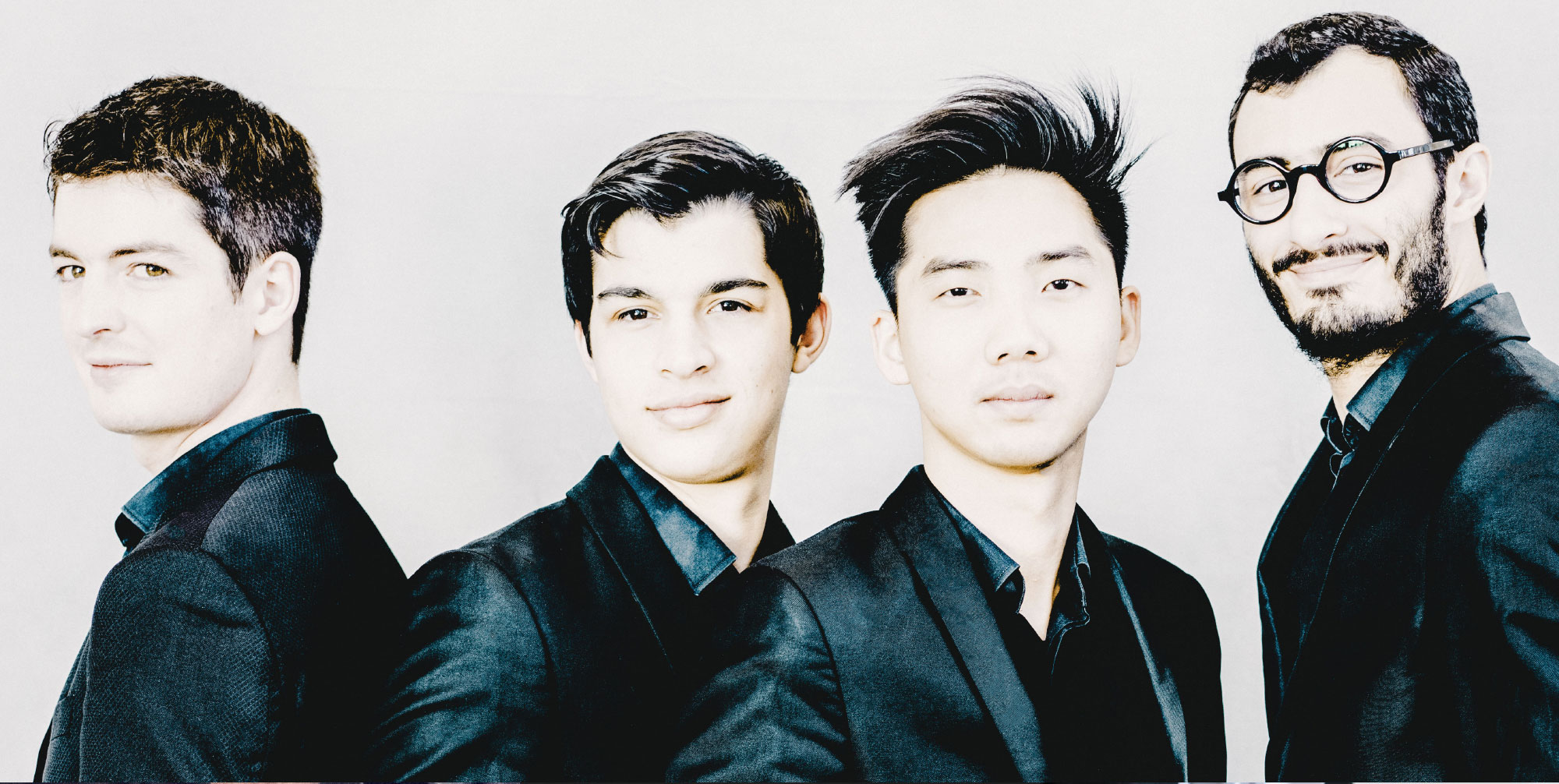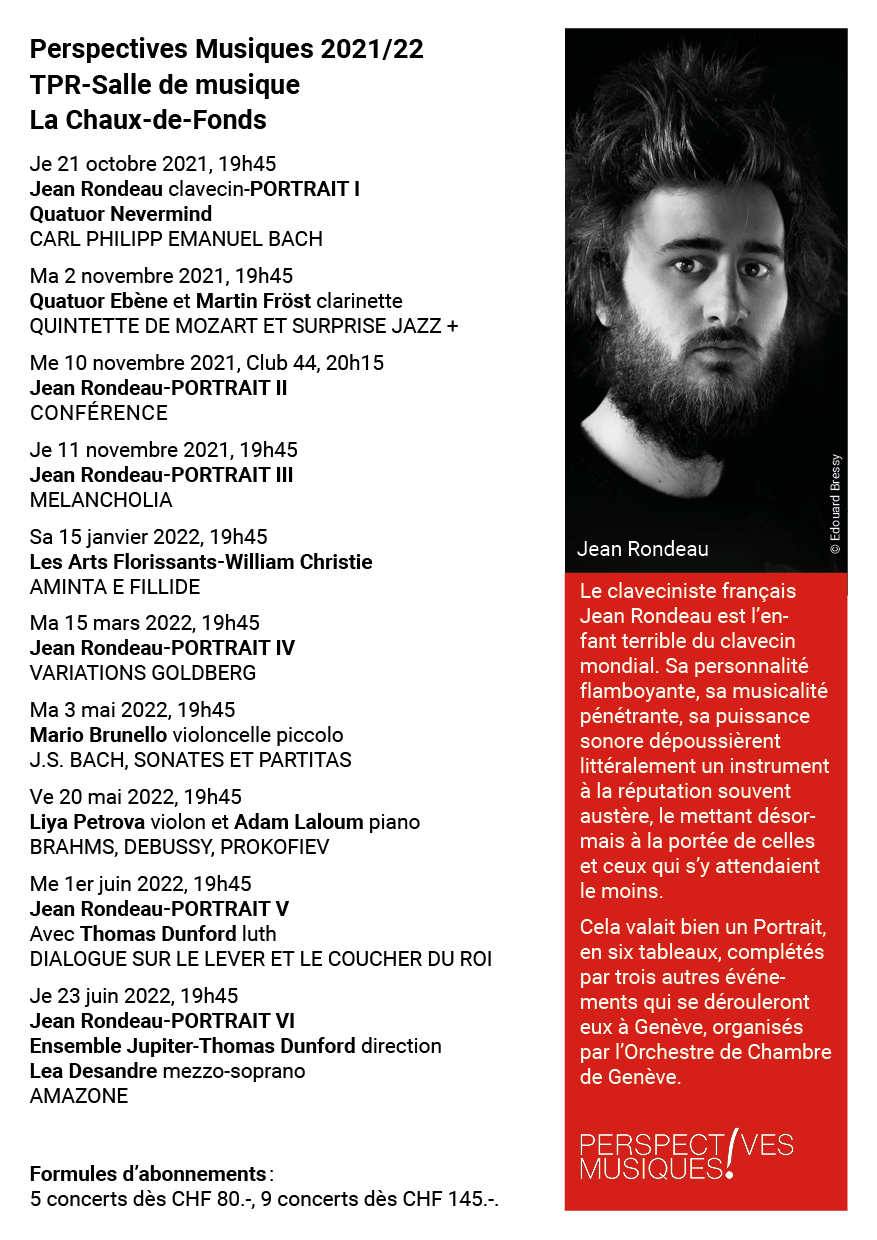
Billets et Abonnements
Détail sur les concerts des 3 mai, 1er et 23 juin 2022
Détail sur les autres concerts, à paraître prochainement.

Perspectives Musiques thanks his Partners 2022/23
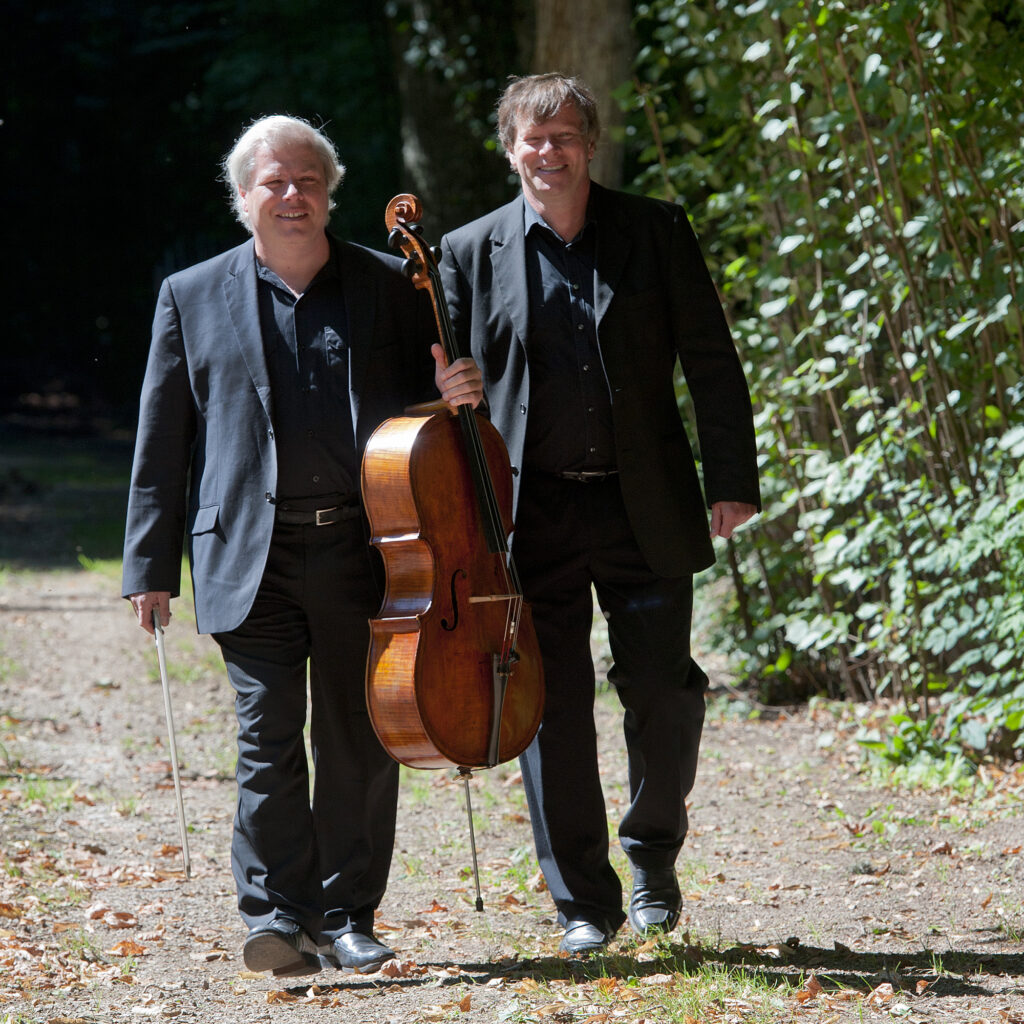
ENTRE
FRERES
FR 8 MAR 2024
7:45 pm
Salle Faller
La Chaux-de-Fonds
Marc Pantillon piano
Christophe Pantillon cello
Ludwig van Beethoven (1770-1827)
Twelve variations for cello and piano
on a theme by Handel, from the oratorio
« Judas Maccabée » (1796)
Ludwig van Beethoven
Sonata for cello and piano in A major, Op. 69
(1807-1809)
Richard Strauss (1864-1949)
Sonata for cello and piano in F major, Op. 6
(1883)
Concert without pause.
Scheduled to finish around 9pm.
When music touches the universal
To get in tune with spring, Perspectives Musiques invites you to a concert in a major key.
« See the conquering hero comes ». Handel’s oratorio Judas Maccabaeus celebrates a military victory, hence the triumphal character of the theme on which Beethoven composes his twelve variations. But above all extra-musical considerations, whether in his variations or in the great sonata that follows, Beethoven writes here pages carried by a humanism and universality that are more essential than ever.
Almost 25 years ago, in the year 2000, Christophe and Marc Pantillon played Beethoven’s first three sonatas for cello and piano, including the great Opus 69. This was at the Chapelle catholique chrétienne, rue de la Chapelle in La Chaux-de-Fonds, in a series then called “Les concerts de la Chapelle”. Shortly before, pianist Edith Fischer performed a memorable complete set of Beethoven’s Piano Sonatas at the Salle de Musique. She will be in concert at the Salle Faller on June 8. The planets seem to be aligned. Marc Pantillon and Edith Fischer share the same passion for the Master of Bonn, to whom they devote an unbounded love. They both unquestionably belong to the line of great Beethovenians.
Richard Strauss composed his sonata Op. 6 at the age of 19. There’s Schumann here, of course. Yet we can already sense an independent spirit, elegance, capriciousness, a more daring way of modulating, all traits that will place the composer among the greatest. Marc is particularly fond of the young Strauss, and in Op. 6, as in the Lieder, he rediscovers the passion of Don Juan, a symphonic poem written a few years later by the German composer.
On the first manuscript of the Sonata in F major, Richard Strauss added a line by the Austrian poet Franz Grillparzer, which reads in essence:
Music, the eloquent,
is at the same time silent.
Keeping quiet about the individual,
She gives us the whole universe.
This is the very first time that Christophe and Marc have played this masterpiece together. It’s highly likely that we’ll perceive, that we’ll receive this deep understanding between brothers, this shared breath, this moving communion at the time of their reunion.
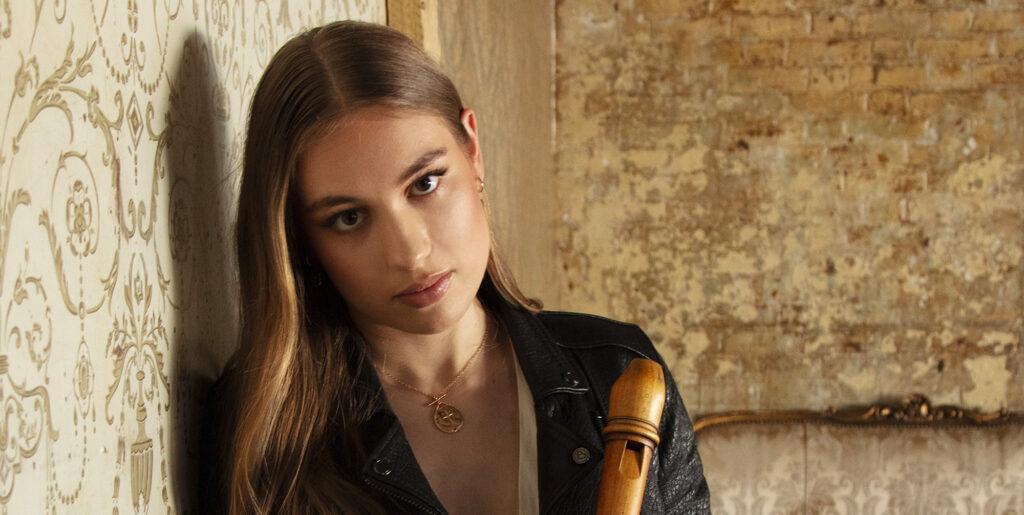
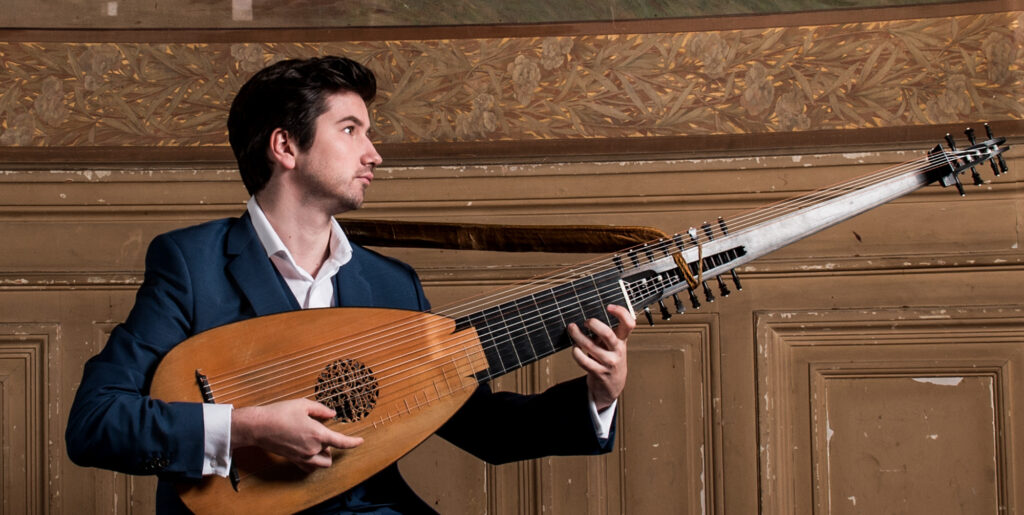
IMAGINE
SU 11 FEB 2024
5pm
Salle de musique
La Chaux-de-Fonds
Lucie Horsch recorder
Thomas Dunford theorbo
Lucie Horsch in Vivaldi’s concerto RV 443, a star video on social networks with over two million views. On February 11, the young musician will perform, with Thomas Dunford, an arrangement for flautino and lute of the last two movements (Siciliano-Allegro molto).
Générations France Musique, le live.
Thomas Dunford also recorded an all-digital album in 2023 at Abbey Road Studio, the Beatles’ studio (!), entitled THE OTHER SIDE, on which he delivers a crazy rendition of Blackbird.
Reunited for the first time on the Perspectives Musiques stage, Lucie Horsch and Thomas Dunford offer a program of unprecedented richness and diversity, featuring thirteen composers from four countries and spanning six centuries!
Dario Castello (1602 – 1631)
Sonata seconda
Georg Philipp Telemann (1681 -1767)
Sonata in C major TWV 4: C5
Jacob van Eyck (1590 – 1657)
“The English Nightingale
(The English Nightingale)
François Couperin (1668 – 1733)
The Nightingale in Love
Johann Sebastian Bach (1685 – 1750)
Prelude, from Cello Suite No. 1 in G major BWV 1007
Johann Sebastian Bach
Suite BWV 997
Joan Ambrosio Dalza (Died 1508)
From “Intabulatura de lauto:
“Calata ala Spagnola
Antonio Vivaldi (1678 – 1741)
Siciliano – Allegro molto: from Concerto for Flautino in C major RV 443
— Pause —
Barbara Strozzi (1619 – 1677)
L’Eraclito amoroso
Isabella Leonarda (1620 – 1704)
Sonata duodecima
Francesca Caccini (1587-1640)
Canzonetta “Chi desia di saper che cos’è amore” (Who wishes to know what love is)
Claude Debussy (1862 – 1918)
“Syrinx
Anne Danican Philidor (1681 – 1728)
Sonata in D minor
Marin Marais (1656 – 1728)
“Human voices
Marin Marais
“Couplets de Folies
As a conversation
Thomas and Lucie began their collaboration in 2017 and have since performed together in prestigious venues such as Hamburg’s Elbphilharmonie, Vienna’s Konzerthaus and Amsterdam’s Concertgebouw. They recently completed a concert tour in Japan. In La Chaux-de-Fonds, they present a repertoire they have been playing together for many years, as well as new discoveries made during their collaboration. For example, the Vivaldi concerto is a piece Lucie usually plays with orchestra, but as Thomas really likes the melody of the beautiful second movement, they decided to include it in their duo programs. The concerto becomes a very different piece in this more intimate setting; the duo formation offers a new freedom. When playing with an orchestra, the interpretation has to be agreed and fixed in advance, whereas with a duo, you can react very quickly to the slightest intention of the other.
The recorder and the lute are two instruments that combine very well. They have an intimate, delicate nature (the recorder’s Italian name, flauto dolce, illustrates this), creating moments of great serenity. But the two instruments also share a certain directness in their production of sound, giving them a responsiveness that creates many moments of virtuosity.
Thanks to this long-standing collaboration, concerts are like real conversations for both musicians. The program they offer in La Chaux-de-Fonds is an assemblage of Baroque music from many countries, including many pieces they have arranged especially for their duo. J.S. Bach’s majestic Suite BWV 997, for example, was originally composed for solo lute. By dividing the melody and bass line between two different instruments, the work’s polyphony and ingenious counterpoint become even more evident. In the final movement of the Suite, the Double, the arrangement demands extreme virtuosity from the recorder.
The second part of their program includes a few vocal surprises. For Lucie, the recorder and the human voice are closely linked, as she will demonstrate in the Canzonetta by Italian composer, poet, lutenist and singer Francesca Caccini. For the rest of the program, they’ll be staying in France, concluding the evening with Marin Marais’ Les Folies d’Espagne, one of the pieces Thomas and Lucie also recorded together. This work was originally written for viola da gamba, with 32 variations, but Lucie has made her own version, adapted to be played on the voice flute, a recorder that has a very warm timbre and is very close to the human voice, thus making a link with Marin Marais’s earlier piece, Les voix humaines, which Thomas will perform in his own version for solo lute.
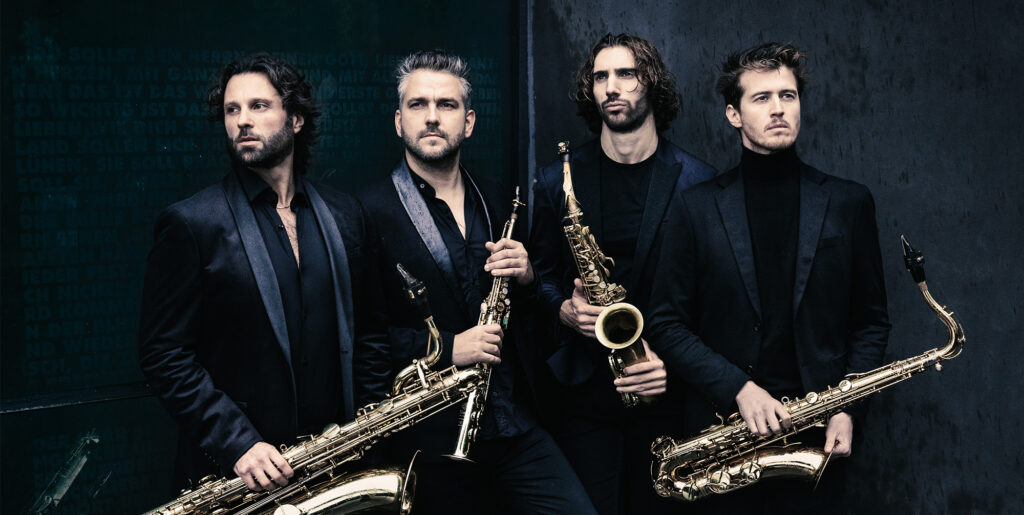
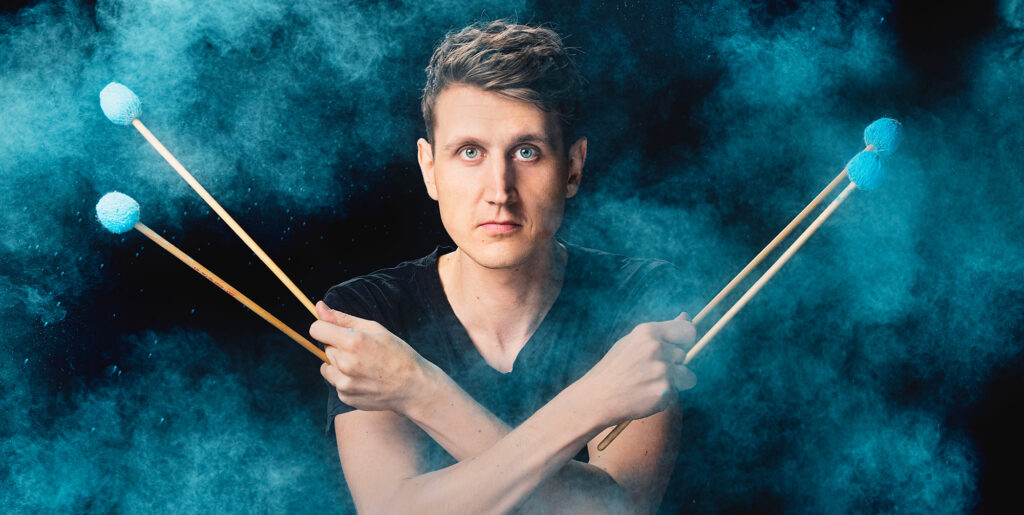
STARRY NIGHT
SU 21 JAN 2024
5pm
Salle de musique
La Chaux-de-Fonds
Pre-concert at 4pm by the saxophone ensemble of the Conservatoire de musique neuchâtelois (CMNE)
Masterclass by the SIGNUM saxophone quartet for CMNE students Monday January 22, 9am-12.30pm, Salle Faller, avenue Léopold-Robert 34, La Chaux-de-Fonds. Open to the public.
SIGNUM saxophone quartet
Alexej Gerassimez
percussion
Five young musicians create soundscapes that no one has explored before, embarking on a Star Trek-like journey.
Percussionist Alexej Gerassimez and saxophone quartet SIGNUM are all renowned performers and universalists on the young classical music scene. They are five virtuosos who like to break down the barriers between concert and performance, between styles and genres, and between composition and improvisation.
Crossing borders is also the focus of the program that the multi-percussionist and the four saxophonists have devised together. Well-known classics such as Holst’s “Planets” are followed by contemporary works by Alexej Gerassimez (“Rebirth”) and a specially commissioned new piece by New Zealand composer John Psathas (“Connectome”). John Williams’ cosmic soundtracks rub shoulders with the firecrackers of the rock world (AC/DC).
In putting together their set list, the musicians have sought inspiration from the major questions facing mankind. Who are we? Where do we come from? Where are we going? Their music takes the audience on a trip deep into space and right into the heart of our subconscious, where we confront our fears, dreams and yearnings.
Here, the concert becomes a spatial experience for all ages and audiences – exciting and soothing, surprising and familiar, romantic and rocking, grounded and otherworldly.
Rebirth by Alexej Gerassimez (1987)
for percussion and saxophone quartet
The Planets, op. 32: Jupiter by Gustav Holst (1874-1934)
For saxophone quartet and percussion
Arrangement Hugo Van Rechem
Connectome by John Psathas (1966)
– Pashupatastra
– Farewell to flesh
– Rom in Space
For saxophone quartet and percussion
Commissioned by Alexej Gerassimez and SIGNUM saxophone quartet (2020)
Wiegenlied (Lullaby), Op. 49 n°4
by Johannes Brahms (1833-1897)
For saxophone quartet and percussion
Arrangement Oran Eldor
— Pause —
Soul of Bottle by Alexej Gerassimez
For amplified bottle
The Planets: Venus by Gustav Holst
For saxophone quartet and percussion
Arrangement Hugo Van Rechem
Thunderstruck
de AC/DC, Angus Young (1955) et Malcolm Young (1953-2017)
For saxophone quartet.
Arrangement SIGNUM saxophone quartet
Asventuras by Alexej Gerassimez
for Snare Drum Solo
Cantina Band (Star Wars) by John Williams
For saxophone quartet and percussion
Arrangement Oran Eldo
Zoom on Connectome
Connectome is a neurological term describing the graphical representation of the neural networks in our brains. The three movements evoke three possible future scenarios into which the human mind could lead us.
The first movement is entitled “Pashupatastra”. This term is taken from the famous Indian epic, the Mahabharata, and means “the deadliest of all weapons”. Inspired by the famous funeral fanfares of New Orleans, this funeral march is music that carries mankind towards the grave it has dug for itself. Man still hasn’t understood that humanity is the deadliest weapon on the planet.
The second movement, “Farewell to the Flesh”, addresses the prospect that we might one day possess the technical capacity to load into a supercomputer a complete and detailed scan of our brain and thus of our consciousness. Could we one day shed our flesh and leave our bodies behind?
This science-fiction journey leads in the third movement to a vision of the future: “Rom in Space”. In this music, John dreams of a prosperous and exciting future, in which mankind will travel to space and settle there. It has effectively solved the great, seemingly insurmountable social problems of our time, and left them behind.
A new beginning for mankind in distant galaxies. “Connectome” tells the story of a sonic utopia.
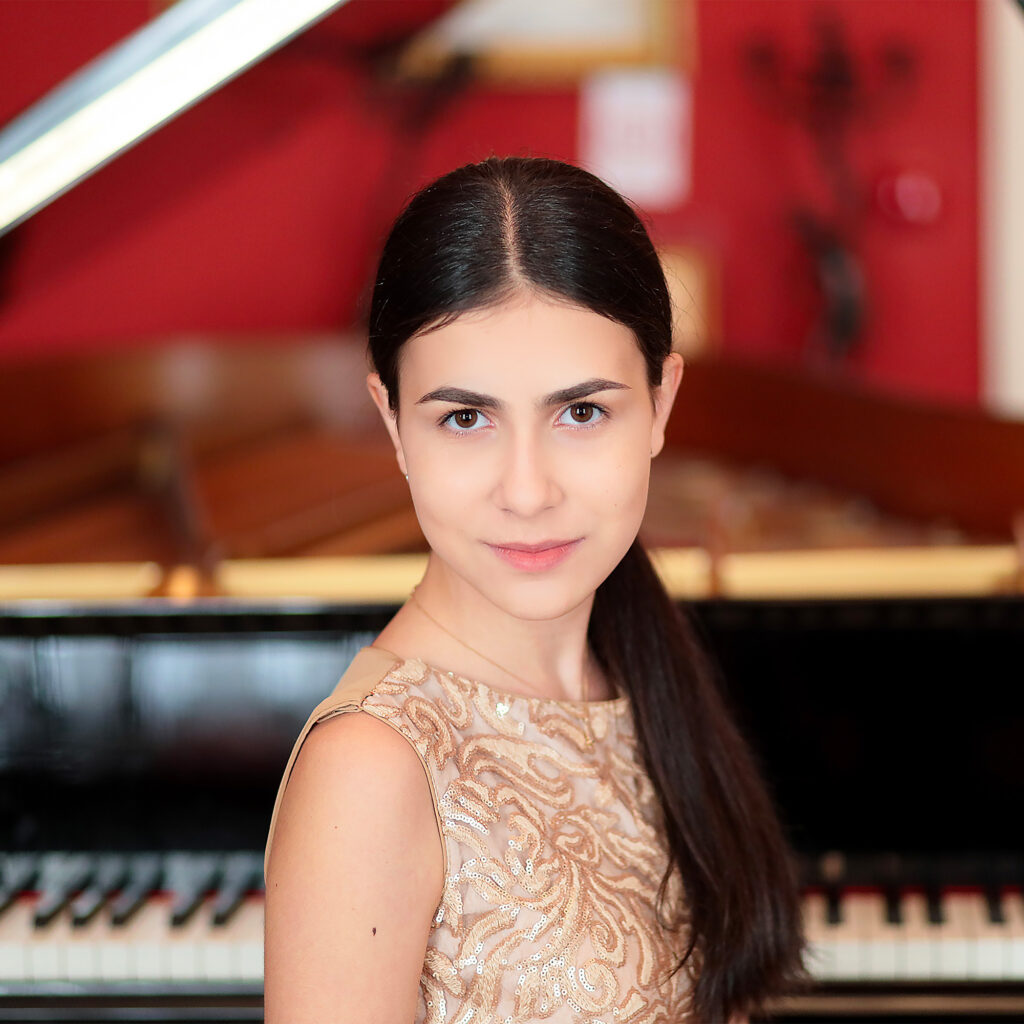
Alexandra Dovgan recently made her debut at the Verbier Festival.
“(…) She’s 16, but if you close your eyes, she could be twice or three times that. How many lives do you have to have lived to put that stained-glass light and nobility of tone into Johann Sebastian Bach’s Sixth Partita? To rocket through the Beethoven of Les Adieux Sonata with the cutting energy and steely touch reminiscent of the great Russian pianist Sviatoslav Richter? And to venture into Brahms’s Variations on a theme by Handel, a massive virtuoso work which she concludes with a Herculean fugue, with a power she draws from who knows where in her adolescent body? And finally, where do the otherworldly colors come from, with which she envelops Bach’s sublime Jesus que ma joie demeure as an encore, which only keyboard legends are allowed to play? Something extremely rare has been whispered here.”
Le Temps, Jean-Jacques Roth, July 18, 2023
TEMPO DI DOMANI
TU 5 DEC 2023
7:45 pm – 9:45 pm
Salle de musique / avenue Léopold-Robert 27, La Chaux-de-Fonds
Alexandra Dovgan piano
Alexandra Dovgan, Verbier church, July 15, 2023. Bach, Partita n°6; Beethoven, “Les Adieux” Sonata; Brahms, Variations on a theme by Haendel
After dazzling and moving audiences in June 2021, pianist Alexandra Dovgan returns to the Salle de musique de La Chaux-de-Fonds on Saturday November 4 at 7.45pm, invited by Perspectives Musiques.
After Bach’s 6th Partita and Beethoven’s Sonata Les Adieux in the first half, in La Chaux-de-Fonds she will deliver her very first public performance of Rachmaninov’s Variations on a theme by Corelli, Corelli Variations “which could well be great, because Dovgan’s intelligence of structure and naturally distinguished tone seem to prevent him from any fault of taste”. Bachtrack.com, Rémi Monti, August 8, 2023, after the young pianist’s debut on the main stage of the Festival de la Roque d’Anthéron.
Find out more by following the arrow.
TEMPO DI DOMANI
Almost six decades separate Alexandra Dovgan from the great pianist Grigory Sokolov, who closed the 2022/23 season, but an incredible talent and deep mutual admiration unite them.
Perspectives Musiques is honored to be able to follow the development of this young musician, whose playing is not that of a child prodigy but of an accomplished sixteen-year-old. Listening to it gives you a very special feeling.
“(…) After the confirmation (Yuja Wang the day before), the revelation. The following morning, 16-year-old Alexandra Dovgan took over the church for a recital that will not soon be forgotten. The density of the program speaks for itself. Partita n° 6, by Bach; “Les Adieux”, by Beethoven; Variations and fugue on a theme by Handel, by Brahms. An avalanche of notes lasting over an hour and a half, which the young Russian, a protégé of Grigory Sokolov, faced like a saint worthy of a Byzantine icon. With a maturity, grace and determination that call for devotion. A musician to her fingertips. Never letting the Handelian theme fade, but sacrificing nothing of the variety of Brahms’ landscapes. What clarity of exposition. What bite in the first variation. What commitment in the final fugue. What contrasts, finally, with Myra Hess’s luminous transcription of Bach’s “Jesu bleibet meine freude”, played as an encore after a Rachmaninov prelude! There’s no doubt about it: her horizons already stretch far beyond the peaks of the Swiss Alps.”
Le Figaro, Thierry Hillériteau, July 17, 2023
Johann Sebastian Bach
Partita No. 6 in E minor, BWV 830
Ludwig van Beethoven
Sonata in E flat major, Op 81a “Les adieux” (Farewell)
— Pause —
J.S. Bach – Sergei Rachmaninov
Prelude, Gavotte and Gigue,
from the Partita for violin in E major BWV 1006
Sergei Rachmaninov
Variations on a Theme by Corelli op. 42
THE PERFECT MATCH
SU 26 NOV 2023
5 pm – 7 pm
Salle de musique / avenue Léopold-Robert 27, La Chaux-de-Fonds
Lucienne Renaudin Vary trumpet
Félicien Brut accordion
Find out more by following the arrow.
THE PERFECT MATCH
Love, whether passionate, disappointed, crazy, filial, platonic, furtive or impossible; love of one, love of the other, love of oneself, love always…
It is an inexhaustible source of inspiration for artists, and is often the raison d’être and permanent quest of individuals.
Love today is often a question of matches! Fabien Waksman, a prodigious young composer, will tell us otherwise. For the trumpet and accordion duo, he imagined a creation full of humor, virtuosity, tenderness and questioning: The Perfect Match.
The work, composed in the style of a Suite de danses baroque, is the main theme of this new program. Each of these movements is interspersed with key works from the repertoire, transcribed for the duo and inspired by… love, of course!
A few pistons, a handful of pearly keys, a wind of dance, a wind of incessant travel, a classic wind, but a popular wind…
That’s what these two wonderful musicians, figureheads of their respective instruments, have to say.
Fabien Waksman’s music rubs shoulders with that of Georges Bizet, Leonard Bernstein, Rafael Mendes, Astor Piazzolla and Michel Legrand to tell the tale of the trumpet and accordion, and of Lucienne and Félicien’s love affair!
Trumpeter Lucienne Renaudin-Vary and accordionist Félicien Brut are happy to share the stage, and it shows! They recount the mixed paths of their instruments, the mixed paths of their respective young careers: from bal musette to opera, from jazz to romantic masterpieces, it’s sometimes just a short step… A dance step, of course!
Chau Paris
D’Astor Piazzolla
Slavonic fantasy
By Carl Höhne
Romance
By Rafael Méndez
Maria de Buenos Aires – excerpts
By Astor Piazzolla
Arrangement by Jérôme Ducros and Domi Emorine
Les Parapluies de Cherbourg
By Michel Legrand
Arrangement by Evgeni Derbenko
(accordion solo)
Tonight, from West Side Story
by Leornard Bernstein
Arrangement by Thibault Perrine
Perfect Match
Suite for trumpet and accordion
by Fabien Waksman
Creation 2023
L’Hymne en Rose
By Domi Emorine
Based on Marguerite Monnot and Louiguy
Tango pour Claude
By Richard Galliano
Concert without pause (duration approx. 70 min.)
Who knows, maybe an encore? In any case, let’s enjoy it!
Grigory Sokolov, live at the Berlin Philharmonic. Rameau, Les Cyclopes
Suite No. 7 in D minor and Chacone in G minor by Purcell. Two new jewels cut by the prodigious hands of Grigory Sokolov. Nothing to see, everything to hear.
Grigory Sokolov in Berlin: every note is a jewel
Recital in Berlin on May 4, 2023
By Christiane Peitz – TAGESSPIEGEL
05.05.2023
(…) If we humans treated each other with the same respect that Grigory Sokolov takes care of sounds, we would live in a better world (…).
The sold-out Philharmonic, some desperate listeners in search of last-minute tickets, the dimmed lights, the stocky figure, the quick and somewhat odd entrances and exits, even though people are cheering for him, the forgoing of any applause before the end of each part of the concert, the six obligatory encores (Rameau twice, the Prelude to the Drop of Water and a Chopin Mazurka, Rachmaninoff, a Bach transcription) : again this year, for the audience of the exceptional Russian pianist and anti-star, everything is as usual. It’s good that there are things that don’t change.
It is even more beautiful that the soul of Sokolov’s playing does not change either. His nuanced touch, his striking pedal technique, his amazing color modulations, he does not let up one iota. Before intermission, the 73-year-old assembled 17 keyboard works by Henry Purcell (actually intended for harpsichord or spinet) into a 35-minute piece. Short suites of movements, dances and folk tunes, which Sokolov embellishes with trills and ornaments as if his grand piano were buzzing with hummingbirds.
An airy baroque, with soft punctuations, discreet affects, finely chiseled dynamics: Sokolov prepares for Mozart with Purcell; the Adagio in B minor is preceded by the Sonata in B major, K. 333, which is just as harmonically audacious. In the Sonata, Sokolov expands the sound space to an imaginary orchestral game with a solo instrument, caressing and hesitating, and sometimes thundering, while the Adagio evokes string quartet associations. (…)
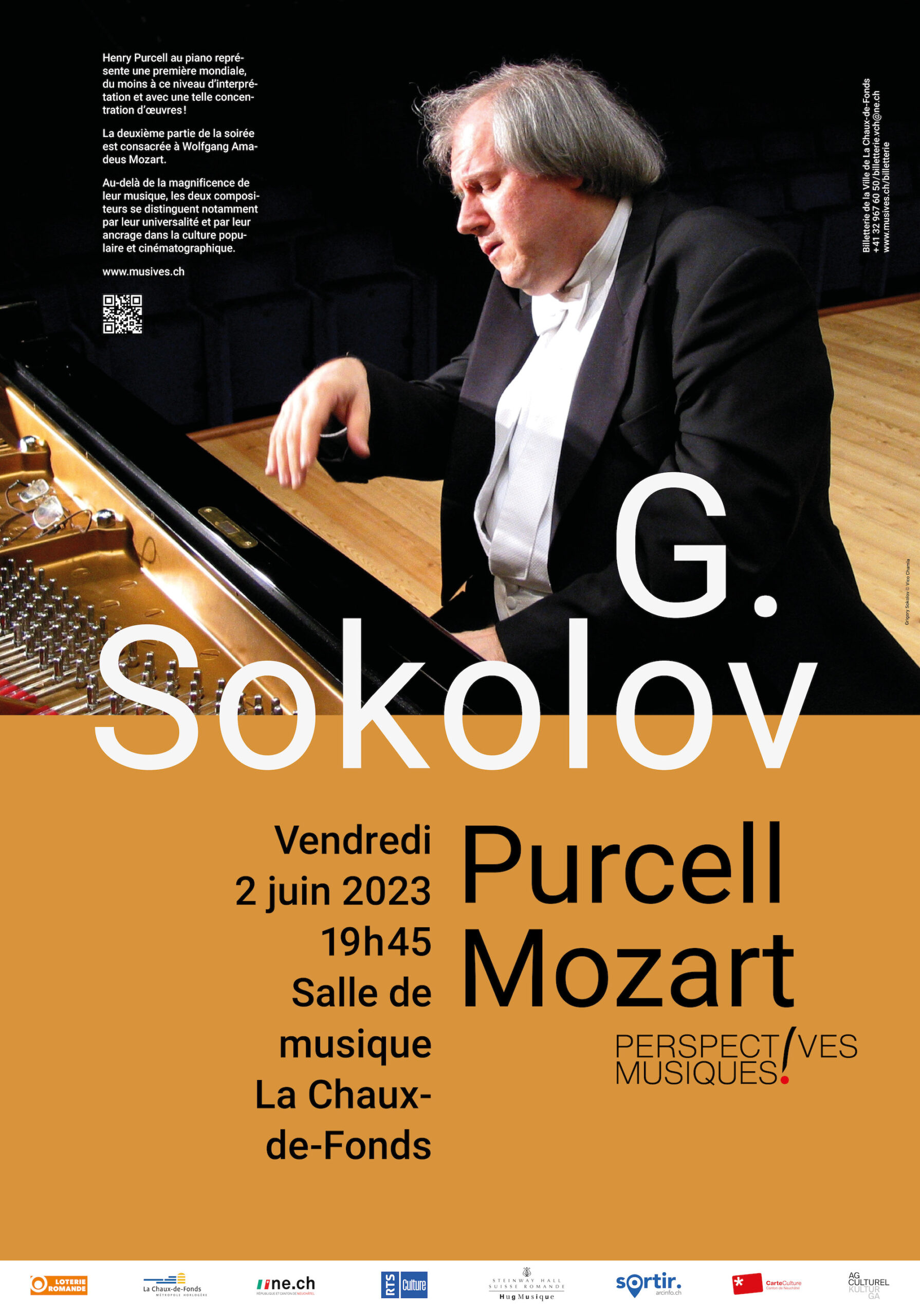
GRIGORY SOKOLOV
FR 2 JUN 2023
7:45 pm – 10 pm
Salle de musique / avenue Léopold-Robert 27, La Chaux-de-Fonds
Grigory Sokolov
piano
It arrives similar to the new vintage of a great vineyard, with its character, its color, its fruit reflections. The program that Maestro Grigory Sokolov has chosen to perform is of a rare originality.
Henry Purcell at the piano represents a world first, at least at this level of interpretation and with such a concentration of works!
It took at least the talent of Grigory Sokolov to face such a challenge. However, the English composer dedicates the works on the program to keyboard instruments, which obviously gives the approach all its coherence.
The second part of the evening is dedicated to Wolfgang Amadeus Mozart.
Beyond the magnificence of their music, the two composers are distinguished by their universality and their roots in popular and film culture. The great director Stanley Kubrick, to name but one, invited them in two of his films, “A Clockwork Orange” (Music for the Funeral of Queen Mary, by Purcell) and “Barry Lyndon” (The March of the Priests, from Idomeneo by Mozart).
Henry Purcell (1659-1695)
Ground in Gamut in G major Z. 645
Suite No. 2 in G minor Z. 661
Prelude
[Almand]
Corant
Saraband
A New Irish Tune [Lilliburlero] in G major Z. 646
A New Scotch Tune in G major Z. 655
[Trumpet Tune, called the Cibell] in C major Z.T. 678
Suite No. 4 in A minor Z. 663
Prelude
Almand
Corant
Saraband
Round O in D minor Z.T. 684
Suite No. 7 in D minor Z. 668
Almand, very slow “Bell-bar
Corant
Hornpipe
Chacone in G minor Z.T. 680
— Pause —
W.A. Mozart (1756-1791)
Sonata No. 13 in B flat major Kv 333 (315c) op. 7 n° 2
Allegro
Andante cantabile
Allegretto grazioso
Adagio in B minor Kv 540
The young pianist Alexandra Dovgan, 14 years old at the time of her Perspectives Musiques recital on June 15, 2021, and the immense Grigory Sokolov were initially scheduled to perform during the same 2020/21 season. Nearly six decades separate them, an incredible talent and a deep mutual admiration unite them.
Program to come.
“The entire personality of Aurele Nicolet and his art will remain an eternal source of inspiration and infinite admiration. He allowed me to become an adult.”
Emmanuel Pahud

In “Des mots sur une vie”, before the tribute concert to Aurele Nicolet, discover touching testimonies taken from the book “Empreintes” published in 2021, that the musicians and Carole Reuge, initiator of the book, will sign after the concert.
Born in Neuchâtel in 1926, Aurèle Nicolet was a major figure in 20th century music and a true legend of the transverse flute. He was principal flute of the Berlin Philharmonic Orchestra from 1950 to 1959 before embarking on a career as a soloist and teacher. Emmanuel Pahud, who has also been principal flute in Berlin for 30 years, was his student.
“This unique way of playing still persists today through his former students, among them Emmanuel Pahud – whose “Nicolet” imprint is recognizable – and the generations after him.
Carole Reuge, coordination and composition of the book “Empreintes”.
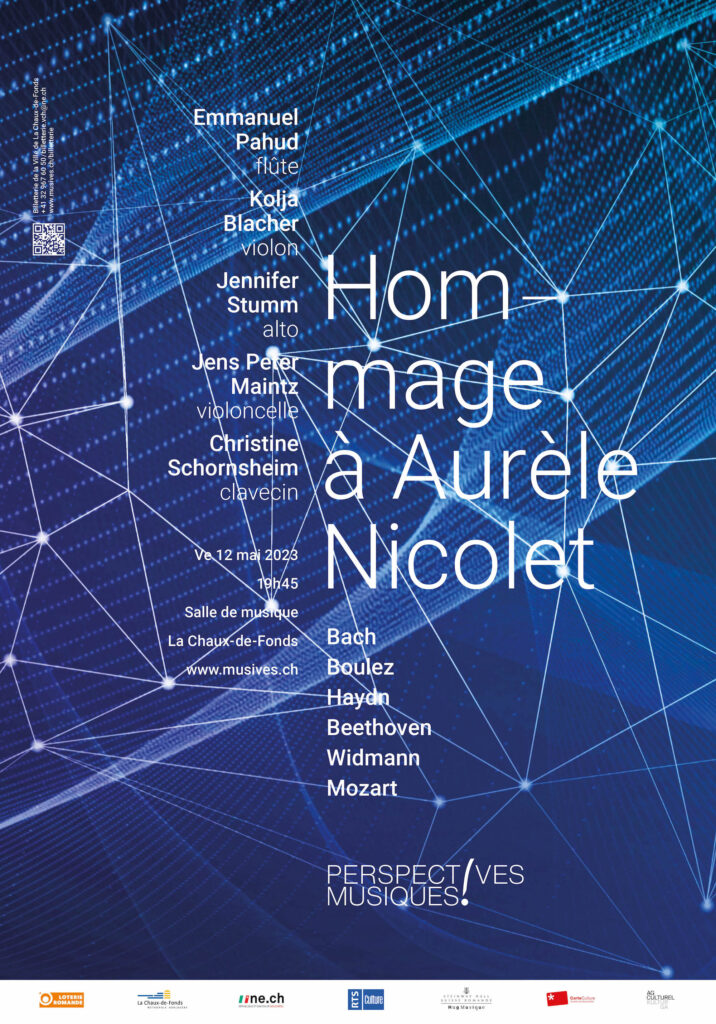
HOMAGE TO AURÈLE NICOLET
FR 12 MAY 2023
7:45 pm – 9:45 pm
Salle de musique / avenue Léopold-Robert 27, La Chaux-de-Fonds
Emmanuel Pahud flute
Kolja Blacher violin
Jennifer Stumm viola
Jens Peter Maintz cello
Christine Schornsheim harpsichord
To learn more, follow the arrow below.
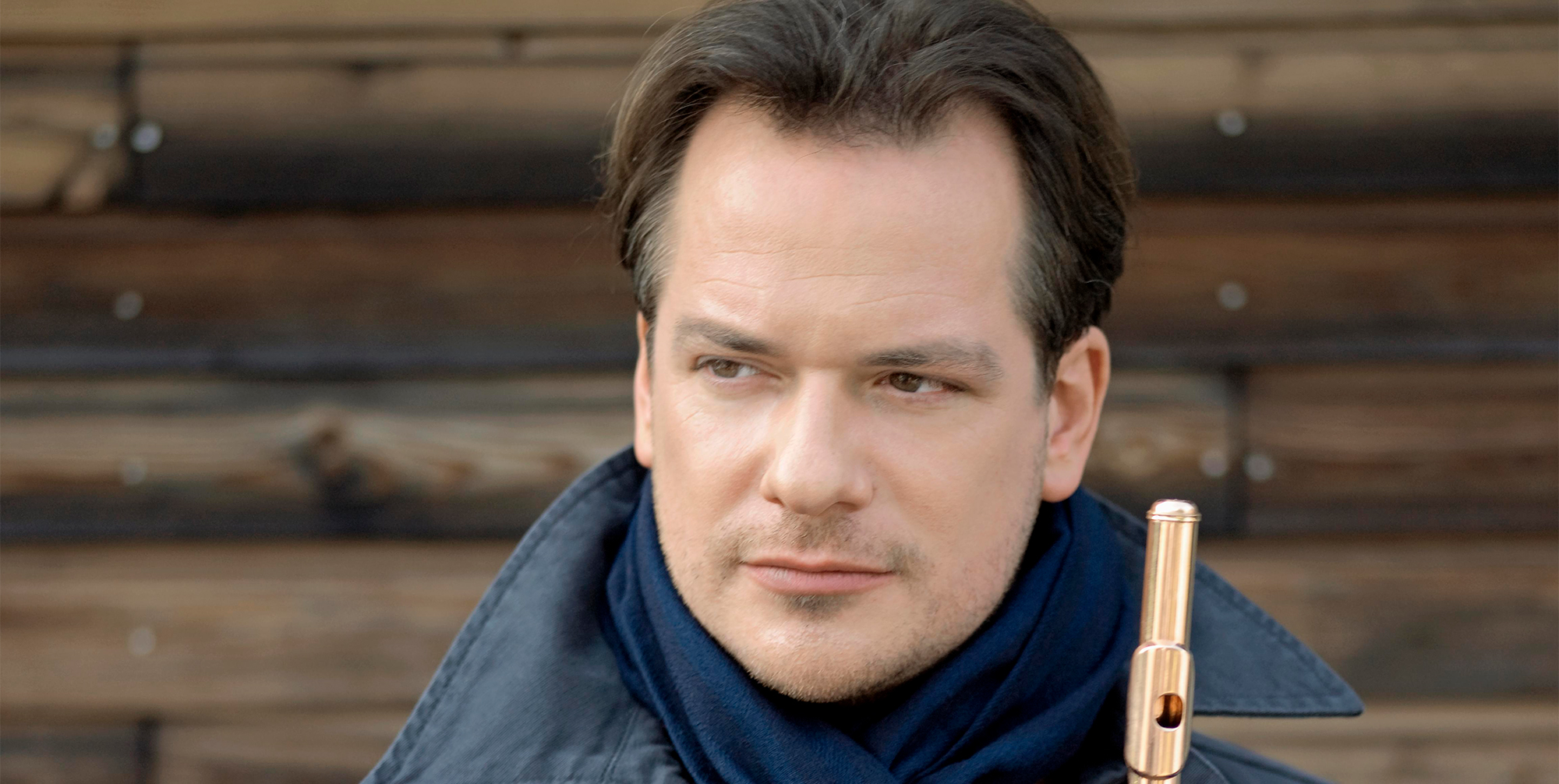
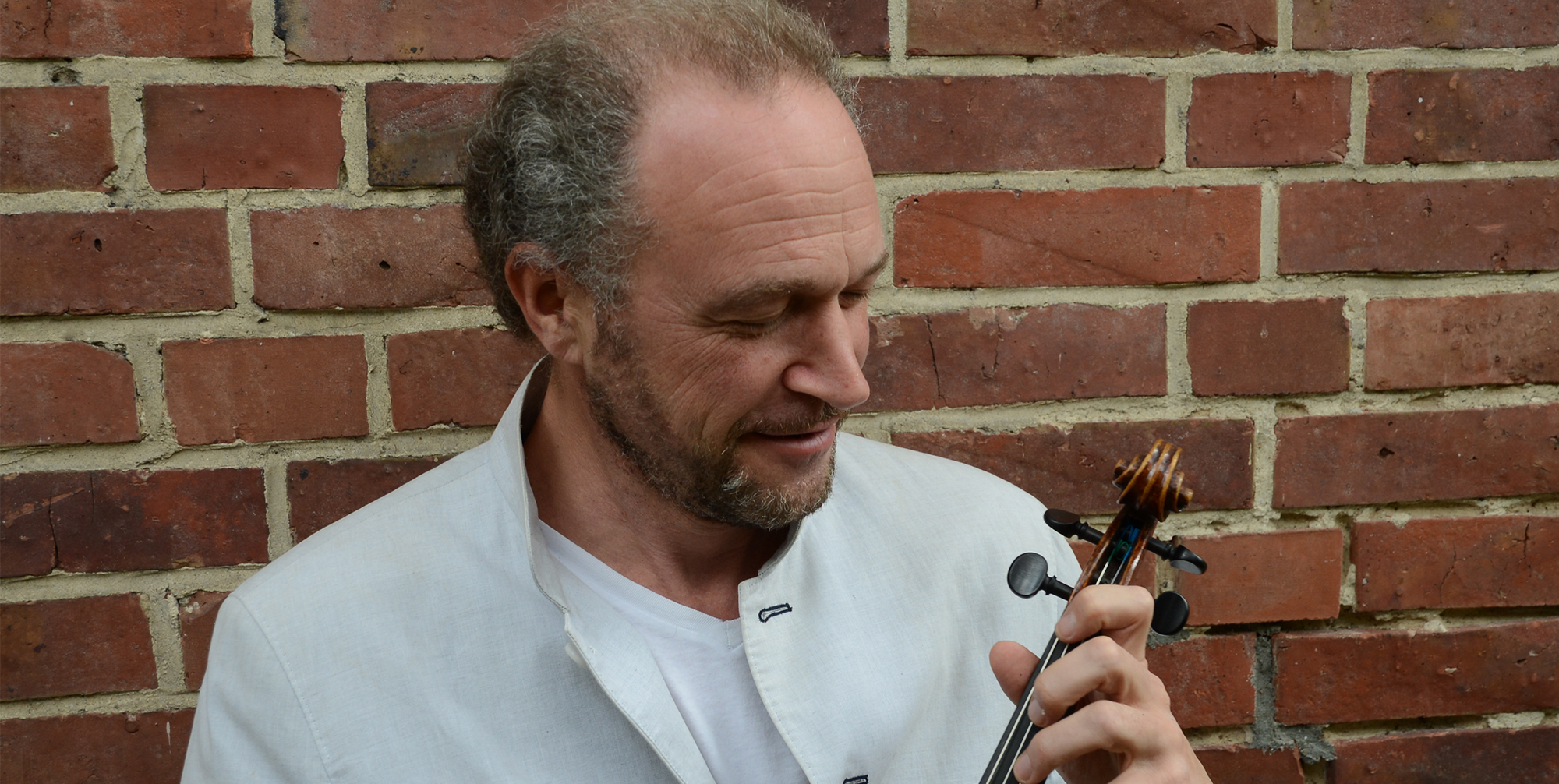
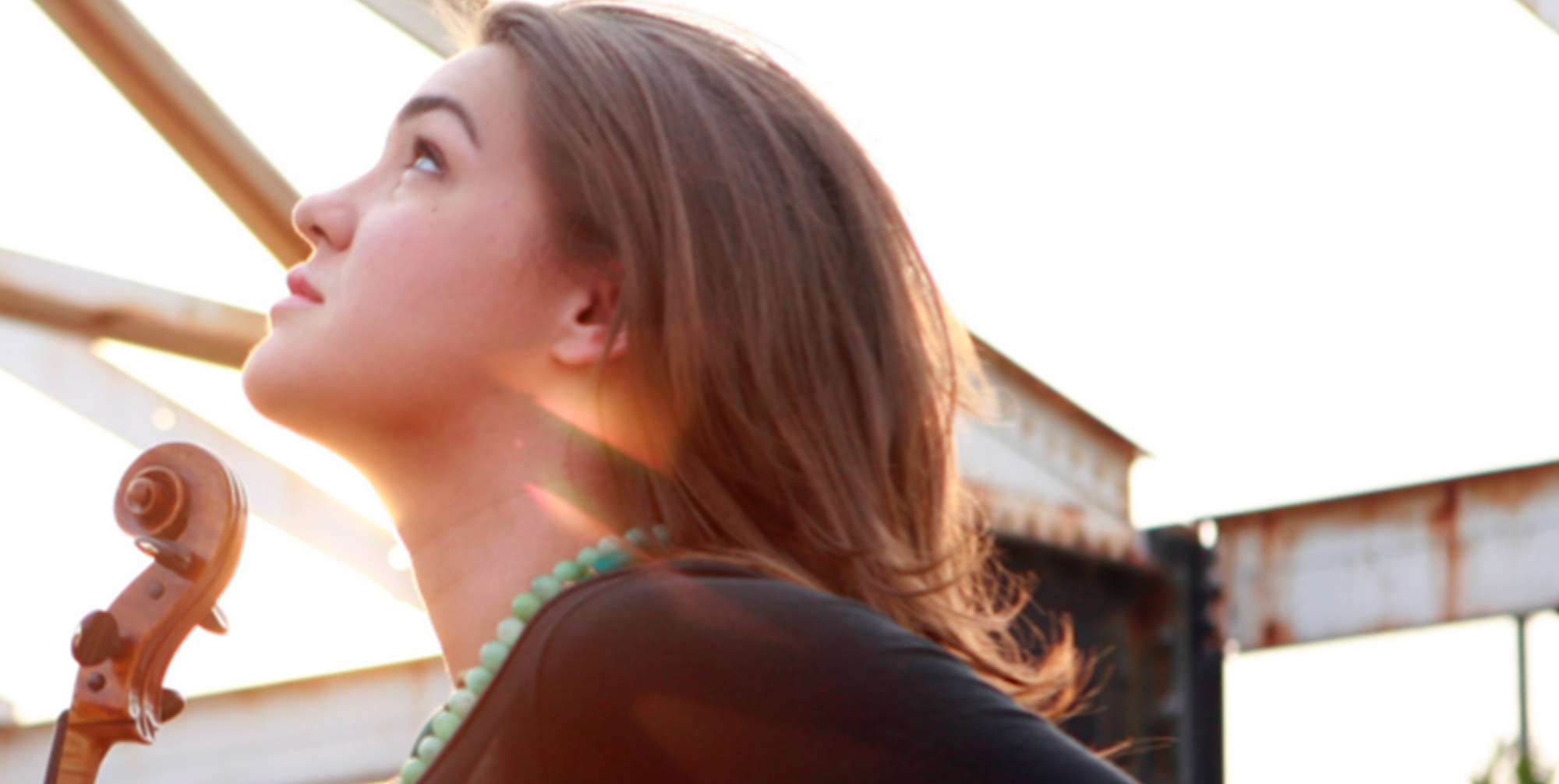
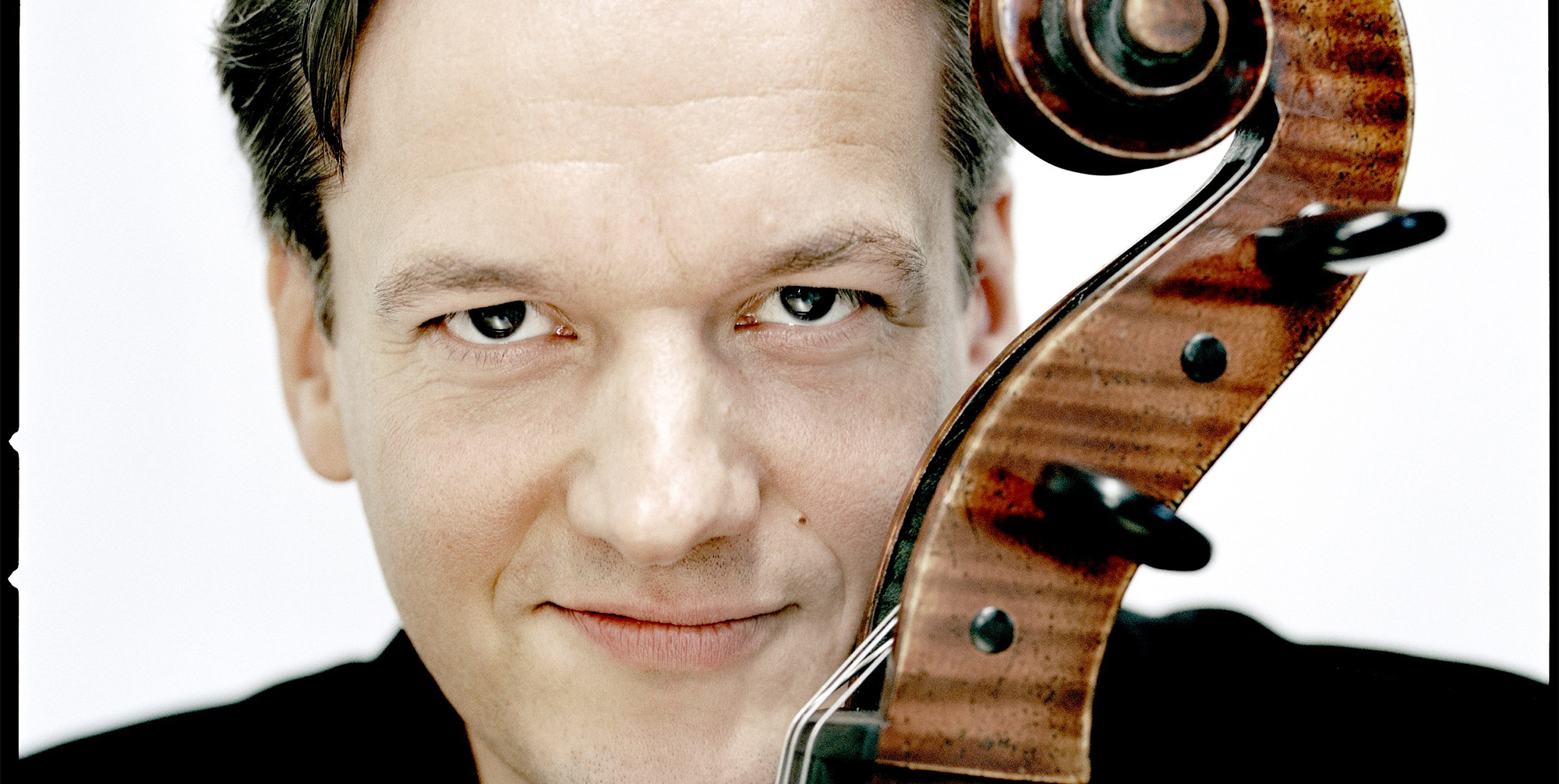
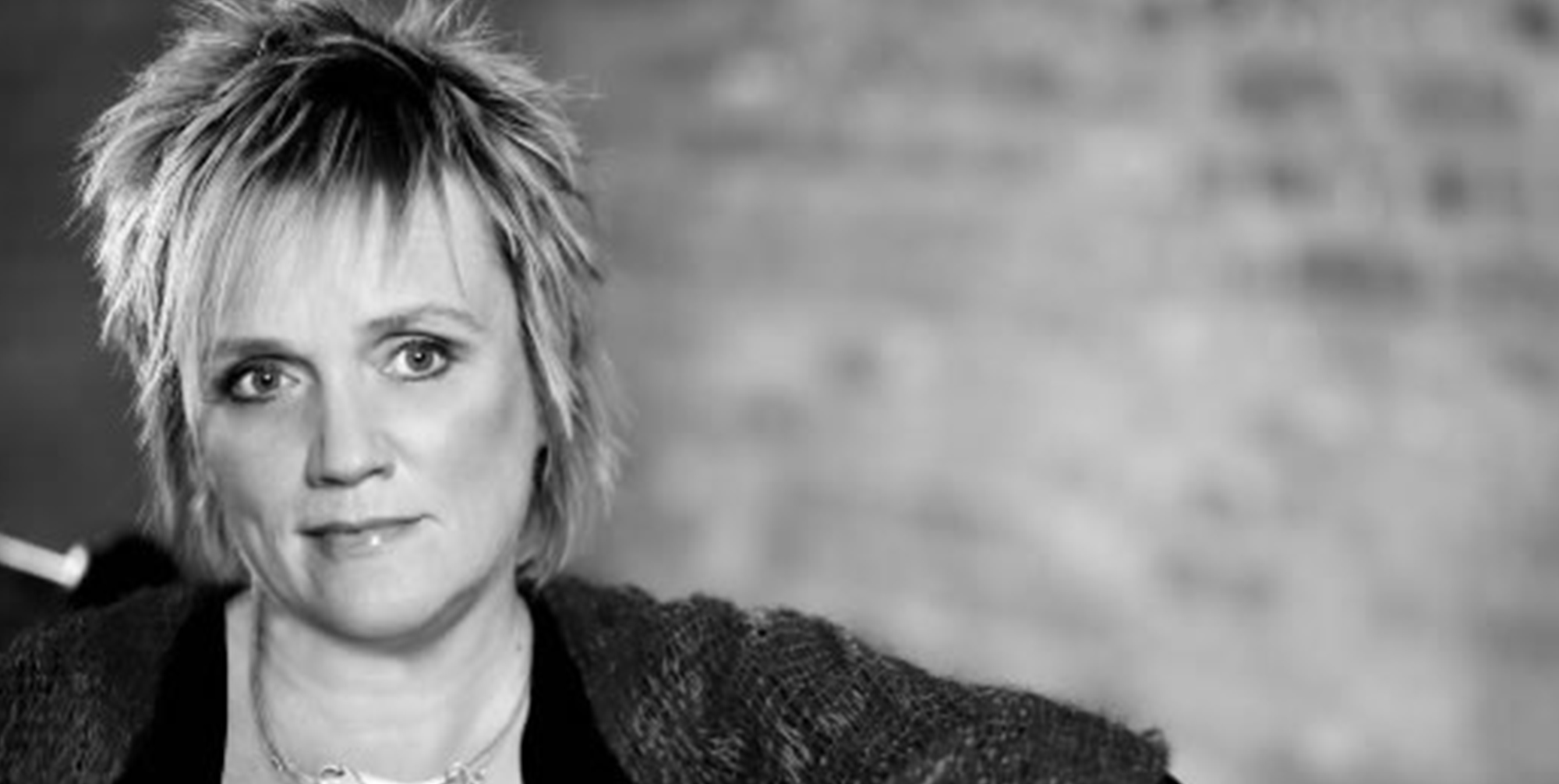
Emmanuel Pahud, flute
Kolja Blacher, violin
Jennifer Stumm, viola
Jens Peter Maintz, cello
Christine Schomsheim, harpsichord
HOMAGE TO AURÈLE NICOLET
Emmanuel Pahud has put together a program that perfectly reflects the endless curiosity of his illustrious predecessor, on the occasion of the 95th anniversary of his birth.
From Bach to Boulez, from Mozart to Widmann, surrounded by four of his colleagues and friends brought together by the highest artistic level, he thus pays a touching tribute to a man and an exceptional musician, to whom he was very close, and who always kept a deep attachment to his native region.
Johann Sebastian Bach
Trio Sonata from the Musical Offering in C minor for flute, violin and continuo BWV 1079, called Sonata sopr’il soggeto Reale a traversa, violino e continuo
Pierre Boulez
Memoriale for solo flute
Johann Sebastian Bach
English Suite No. 2 in A minor BWV 807
Joseph Haydn
Trio No. 1 for flute, violin and cello in C major Hob. IV : 1, called London Trio
Ludwig Van Beethoven
String Trio No. 3 in G major op. 9 n° 1
Jörg Widmann
Petite Suite for flute (option with cello and gong) (2016)
Wolfgang Amadeus Mozart
Quartet for flute and string trio in D major KV 285
Created by Emmanuel Pahud, La Petite Suite was written by Jörg Widmann in 2016, shortly after the death of Aurele Nicolet. “His music is at once extremely expressive, pure and intense, but also terribly playful and mischievous, an intensity and liveliness that reminds me of Nicolet’s person and look. Emmanuel Pahud, about Jörg Widmann.
Romances, with Emmanuel Pahud and pianist Eric Le Sage, Warner Classics, 5 May 2023
Aurele Nicolet was always interested in the music of today. However, it was very difficult in his time to perform recent scores in concert, so the maestro regularly reserved little surprises for his audience! Here “…explosante-fixe… by Pierre Boulez, version for solo flute.
The Rondeau. Allegretto from Mozart’s Quartet in D major KV 285, on the program for the May 12 concert.
Violist Jennifer Stumm talks about her instrument in a very touching way.
The Allegro from Mozart’s Quartet in D major KV 285, on the program for the May 12 concert.
THE SACRE DU PRINTEMPS
SA MARCH 11, 2023
7:45 pm – 9:45 pm
Salle de musique / avenue Léopold-Robert 27, La Chaux-de-Fonds
Lucas & Arthur Jussen pianos
A great Duo of “brothers” for a Sacre.
Welcome to spring!
A major work in the history of music, Stravinsky’s The Rite of Spring, in its version for two pianos, by “The Fab Two”, the piano duo Lucas & Arthur Jussen, in one of the most renowned acoustics.
What more could you ask for? La Valse by Ravel and Mozart’s Sonata in D major KV 448, also for two pianos, and Schubert’s Lebensstürme D 947, for piano four hands, an opportunity to discover this concentration of talent on a single keyboard.
Offering a rare complicity on stage, the two young Dutchmen are making the music world go wild. An evening of a very high artistic level is announced on Saturday, March 11 at 7:45 pm at the Salle de musique in La Chaux-de-Fonds!
Wolfgang Amadeus Mozart
Sonata for two pianos in D major KV 448
Allegro con spirito
Andante
Molto Allegro
Franz Schubert
Allegro in A minor for piano four hands “Lebensstürme” op. 144, D 947
Maurice Ravel
La Valse. Choreographic poem for two pianos
Igor Stravinsky
The Rite of Spring, version for two pianos
I. Adoration of the Earth
Introduction
Augurs of Spring
Ritual of abduction
Spring rounds
Ritual of rival tribes
Procession of the Sage : The sage
Dance of the Earth
II. The sacrifice
Introduction
Mystic circles of the young girls
Glorification of the chosen one
Evocation of the ancestors
Ritual action of the ancestors
Sacrifical dance
To learn more, follow the arrow below.
THE SACRE DU PRINTEMPS
A great Duo of “brothers” for a Sacre.
Welcome to spring!
A major work in the history of music, Stravinsky’s The Rite of Spring, in its version for two pianos, by “The Fab Two”, the piano duo Lucas & Arthur Jussen, in one of the most renowned acoustics.
What more could you ask for? La Valse by Ravel and Mozart’s Sonata in D major KV 448, also for two pianos, and Schubert’s Lebensstürme D 947, for piano four hands, an opportunity to discover this concentration of talent on a single keyboard.
Offering a rare complicity on stage, the two young Dutchmen are making the music world go wild. An evening of a very high artistic level is announced on Saturday, March 11 at 7:45 pm at the Salle de musique in La Chaux-de-Fonds!
Wolfgang Amadeus Mozart
Sonata for two pianos in D major KV 448
Allegro con spirito
Andante
Molto Allegro
Franz Schubert
Allegro in A minor for piano four hands “Lebensstürme” op. 144, D 947
Maurice Ravel
La Valse. Choreographic poem for two pianos
Igor Stravinsky
The Rite of Spring, version for two pianos
I. Adoration of the Earth
Introduction
Augurs of Spring
Ritual of abduction
Spring rounds
Ritual of rival tribes
Procession of the Sage : The sage
Dance of the Earth
II. The sacrifice
Introduction
Mystic circles of the young girls
Glorification of the chosen one
Evocation of the ancestors
Ritual action of the ancestors
Sacrifical dance
EROS, THANATOS AND THE SUN
Concert-show in creation
TUE 14 FEB 2023
7:45 pm – 9:45 pm
Salle de musique / avenue Léopold-Robert 27, La Chaux-de-Fonds
Pascal Auberson
Ariane Haering
Gaspard Glaus
pianos, keyboard, sampler, hand percussion, guitars and voice
On Tuesday February 14th, the day of love and chance, Perspectives Musiques invites you to immerse yourself in the delirious acoustics of the Salle de musique de La Chaux-de-Fonds…
Pascal Auberson, Ariane Haering and Gaspard Glaus, three inspired sensibilities, three pianos, 264 shades of black and white notes will join together to celebrate through music, songs, words and rhythms, the Eros, the Thanatos and the Sun of our lives.
Nos pères
Nous manquent cruellement
Sans leur bienveillance
Leur discrétion
Leur amour inconditionnel
Leur douceur
Nous nageons
Seuls
Orphelins
D’Éros à Thanatos
Du soleil jusqu’à l’os
Nous nous efforçons
De garder l’instant
D’une vie si précieuse
Que la mort ne peut effacer
Excerpt from Lumière et Inspiration
Text Ariane Haering/Pascal Auberson
En remontant le fleuve de notre histoire d’amour
En remontant le cours de notre histoire fleuve
Je nous vois tous les deux à la source profonde
Dans le bleu de tes yeux où les eaux se confondent (…)
Excerpt from Histoire fleuve
Text by Pascal Auberson
FR 10 FEB 2023
8:15 pm – 9:45 pm
Club 44 / rue de la Serre 64, La Chaux-de-Fonds
Music and fusion of styles, myth or reality?
An evocation of some attempts.
Gaspard Glaus by Pascal Auberson
In order to do this, I had to surround myself with musicians who had the same desire to work on the written word, but also to take the time to research together, while decompartmentalizing our universes, which had been locked up for so long in fashions, genres, and well-established postures, without losing the identity of each one. It is with Gaspard Glaus, a lifelong friend, that I started my career. We were twenty years old and had a common passion for the stage. Read more
Ariane Haering by Pascal Auberson
I am very happy that such a personality, such a great pianist recognized far and wide, accepts my proposal with such joy and simplicity. It is quite rare in this world of fierce competition that artists of this notoriety accept with such ease to question themselves.
It is thanks to Gaspard Glaus that I met musically Ariane Haering during a streaming in these times of Covid 19 behind a flat screen. Read more
Ariane Haering on Eros, Thanatos & the Sun:
Reunion, musical thrills and friendships
As I unwind the thread of my recital, an imperceptible link is woven. Alone in front of my piano, Gaspard at a reasonable distance, Pascal behind his screen, the common desire to try to bring together our passions and our musical forces imposed itself.
Waiting for the event that would change the quiet course of my piano adventures, ready to look beyond a defined horizon, it is the spark of the Auberson / Glaus duo illuminating their intense complicity that will convince me to dare to say Yes, without hesitation.
From my Mozartian, Beethovenian, Brahmsian and Stravinskian background, from these ancestral rhythms and pulsations, our escapes, our chords, our harmonic digressions will be born.
A common language, a form of concert/show allowing to explore a new space of creation. Each one for himself and infinitely united between a breath, a voice, words, arpeggios, a stream of sostenuto and an inspired flight.
We leave to find the Essential in three without chewing our wounds.
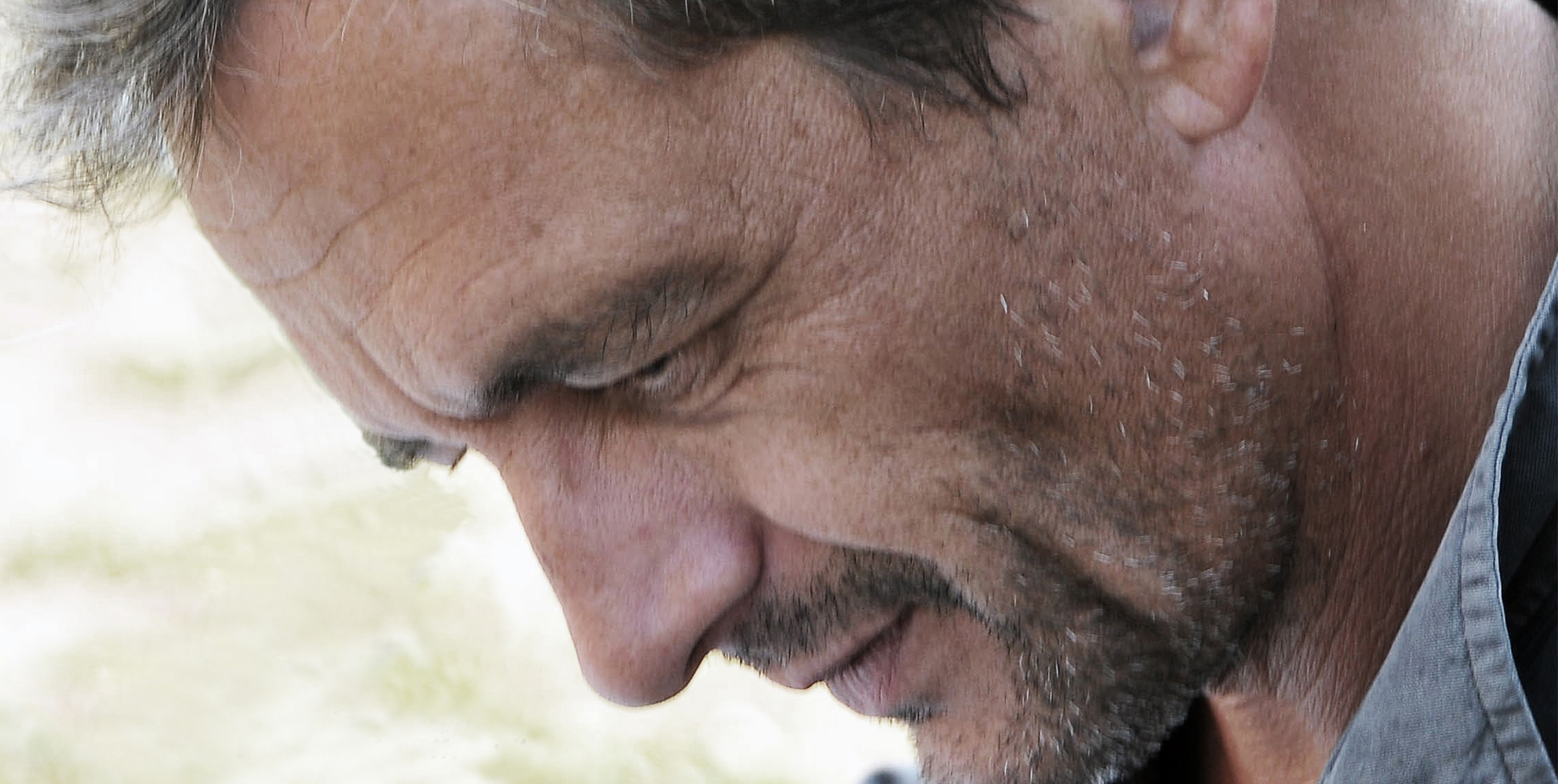
Gaspard Glaus on Eros, Thanatos & the Sun
June 29, 2021, 7pm
First performance of our trio live for the RTS. From the very first notes, I feel a musical communication of an extremely strong level and intensity.
Ariane, the musicality and the sound, Pascal, the vocal warmth and the rhythmic intensity, move me at every measure. We form a triangle that moves through music, in music, in all music. Our experiences bring Stravinsky, Ravel, Bill Evans, Mozart, Purcell, improvisation and writing to our ears.
A dream, for an arranger, of almost intimidating beauty and size and wildly challenging.
We play like it’s the most important thing in the world… and it is.
I am delighted.
LUDWIG VAN B.
SU 4 DEC 2022
5 pm – 7:30 pm
Salle de musique / avenue Léopold-Robert 27, La Chaux-de-Fonds
Nicolas Altstaedt cello
Alexander Lonquich piano
“Since we played the cycle with Alexander, it has been a part of our lives, and I don’t want to spend my life without Beethoven. It makes us discover so many spaces and dimensions in ourselves, in our spirit, in the human being, that we could not discover without it.
It’s heading to places we haven’t been before, abysses, strange and far away places, where no one could take you.”
Nicolas Altstaedt
“The young Beethoven had a very strong personality. There may be an influence coming from Haydn, from Mozart, but this is really Beethoven at his best from the very first moments.”
Alexander Lonquich
LUDWIG VAN B.
Nicolas Altstaedt, cello
Alexander Lonquich, piano
Ludwig van Beethoven (1770-1827)
Complete Sonatas for Cello and Piano
Sonata No. 1 in F major op. 5 No. 1
Sonata No. 2 in G major op. 5 No. 2
Sonata No. 3 in A major op. 69
Interval
Sonata No. 4 in C major op. 102 No. 1
Sonata No. 5 in D major op. 102 No. 2
The double CD “Beethoven complete works for fortepiano and violoncello”, which includes in addition to the five sonatas on the concert program the variation cycles, was released in 2020 by Alpha Classics. Nicolas Altstaedt insisted on recording on a gut-stringed instrument, a Guadagnini from Piacenza dated 1749, and with a classical bow. Alexander Lonquich plays a fortepiano, not a modern piano as in the “Ludwig van B.” concert.
“When I first heard the recording of Beethoven’s Sonatas for Cello and Piano by Nicolas Altstaedt and Alexander Lonquich, I was captured, unable to guess exactly why, just captured. I then realized that one of the reasons, among a hundred others, for the powerful emotion that emanates from their interpretation is a pulse of extraordinary regularity, which only exceptional technique and virtuosity can achieve at this point.
The integral entered my life very early. I still remember the walls that surrounded me then, the light that penetrated the space of the room. It was a box set of vynil records from the “Cliub français du disque”. When I took it out of my library, I had to look for the names of the two performers, the pianist Pierre Sancan and the cellist André Navarra, both of whom were very important at the time. Only a reproduction of the Bonn Master’s signature is visible on the box – and there was no lack of space with the vinyls – another time!
Simultaneously with the composer’s Piano Concertos Nos. 2 and 4 with Wilhelm Kempff, I began by adoring the third sonata, Op. 69, in A major, as a child might adore, the first theme of the first movement, with a sweetness that reassured me. Since that moment, Beethoven has never left me. If the whirlwind of life has sometimes made me forget it, somewhere inside me, its music has always whispered its song of courage and bravery. He is a giant, of course, a huge giant but, paradoxically, I have always felt very close to him, like a friend.
When he takes us into his regions of silence and novelty, to which the Adagio con molto sentimento d’affetto of Op 102 No. 2 belongs, it is always by taking us by the hand, with remnants of the known, as if to reassure us, to help us follow him. We are already somewhere else but we haven’t realized it yet.
Beethoven gives us confidence. His music speaks, perhaps more than any other, to our hearts, to the heart of humanity. The happy perspective of sharing it in the marvelous acoustics of the Salle de musique in La Chaux-de-Fonds leaves me with a feeling of impatience and excitement.
Frédéric Eggimann
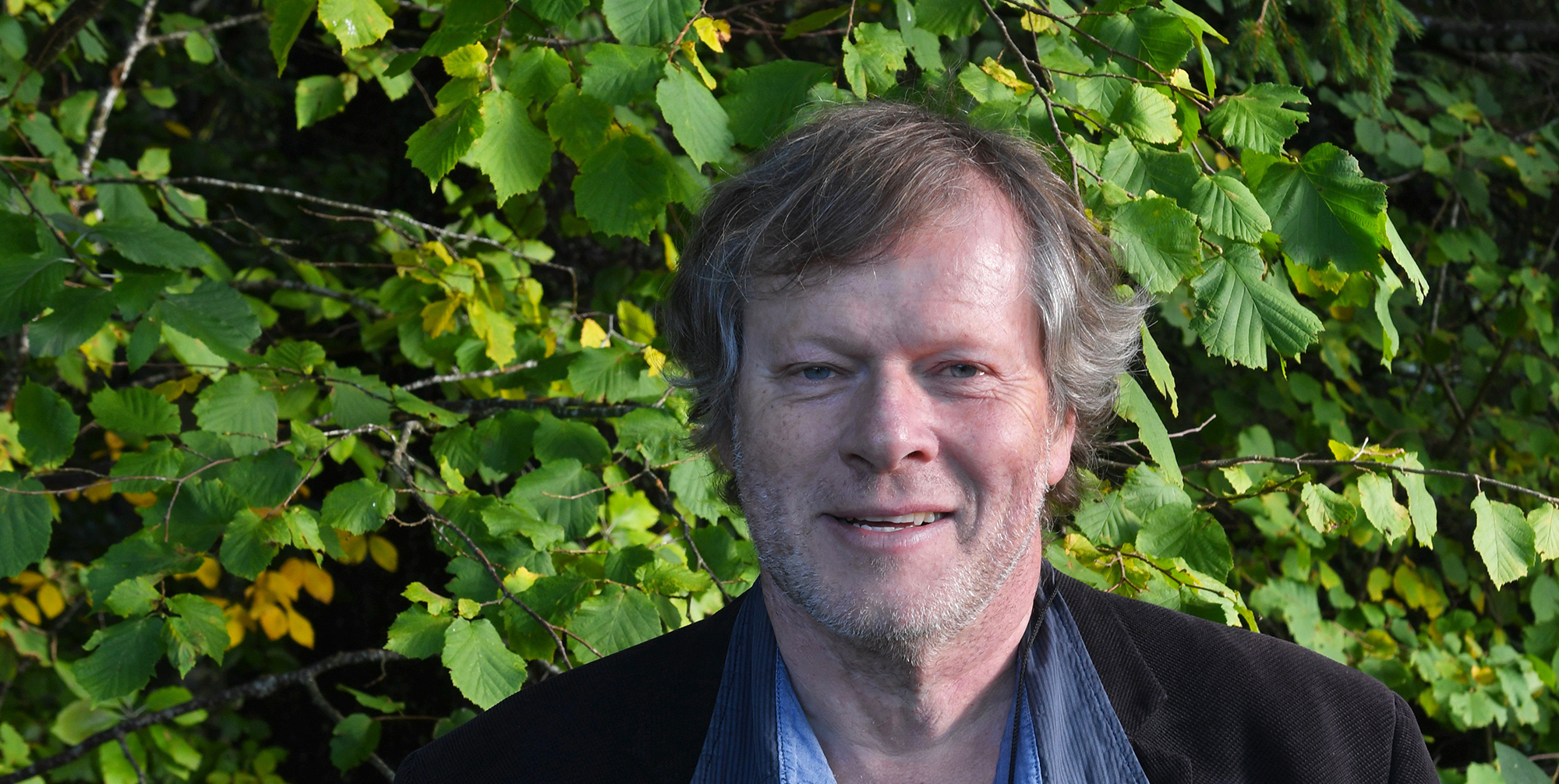
AROUND BRAHMS
DI 13 NOV 2022
5 pm – 6:30 pm
Salle Faller du Conservatoire de musique neuchâtelois
Avenue Léopold-Robert 34, La Chaux-de-Fonds
Marc Pantillon piano
Marc Pantillon will dedicate his Brahms album at the end of the concert, an album with an almost romantic trajectory!
Released in 2005 by Claves and recently reissued in an expanded version by the same label, the Brahms disc recorded by neuchâtelois pianist Marc Pantillon is a bit like a rock star. Pirated in Italy, praised by the BBC – see recent Facebook post on our social networks – and in Belgium, the interpretation attracts covetousness, as do the works “from op. 10 to op. 119, it is almost the entire creative life of Brahms that is summarized.” (Excerpt from the disc booklet).
Recital program:
Wolfgang Amadeus Mozart
Fantasy in C minor KV 475
Johannes Brahms
Ballades and Intermezzi
Ludwig van Beethoven
Sonata No. 30 in E major op. 109
ENDOR
FR 28 OCT 2022
7:45 pm – 9:45 pm
Salle de musique / avenue Léopold-Robert 27, La Chaux-de-Fonds
Anna Prohaska soprano
Nicolas Altstaedt cello
Francesco Corti keyboards
Recorded by Espace 2
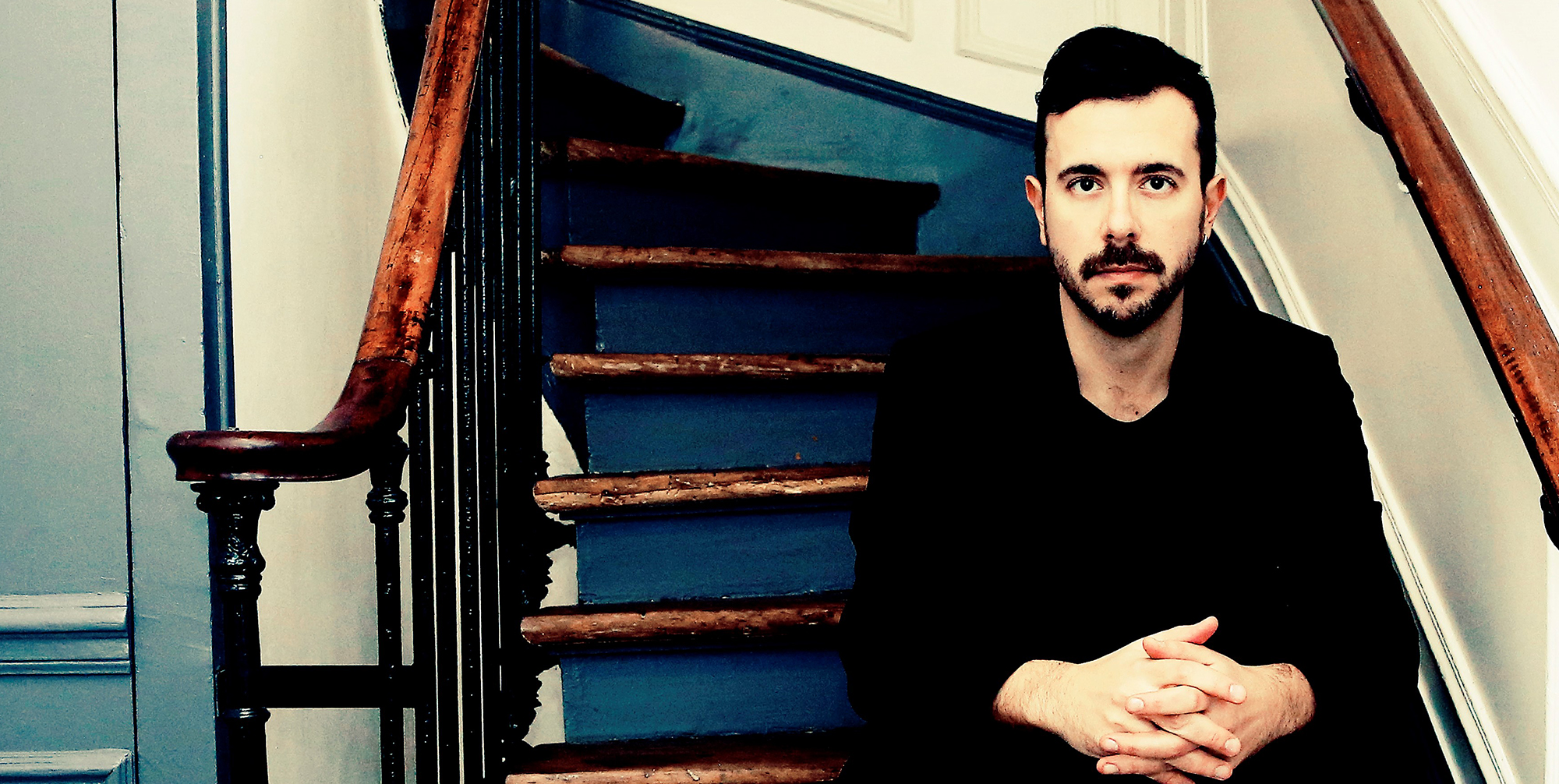
Anna Prohaska, soprano
Nicolas Altstaedt, cello
Francesco Corti, keyboards
In addition to their favorite instruments, the three performers play various percussion instruments, lotus flute, as well as their own voices. Lights, makeup and costume in the last work (Sister Death), Endor proves to be a real spectacle.
ENDOR
Soprano Anna Prohaska, cellist Nicolas Altstaedt and harpsichordist Francesco Corti are equally at home with music from the Baroque period and contemporary music.
Interview with Anna Prohaska and Nicolas Altstaedt, extract:
ENDOR – that’s what you called your program. Where do you want to take the listeners*? What is the imaginary cosmos of ENDOR for you?
Anna Prohaska: The Witch of Endor is a character from the biblical story of Saul, the first king of the Israelites, his wars against the Philistines and the jealousy-ridden conflict with the young David, who becomes a threat to him after his victory against Goliath. Saul consults a fortune teller – the witch of Endor – to find out the outcome of the Israelites’ impending battle with the Philistines. The witch of Endor invokes the spirit of the dead prophet Samuel, who predicts to Saul not only his defeat and death, but also the taking of the kingship by David. In Saul’s encounter with the witch of Endor, the old pagan world meets the new monotheistic world. This is why we have chosen a mixture of sacred and secular music literature.
The witch figures are one of the pivots of the program. With the aria “Credete al Mio Dolore”, we also have on the program the witch Morgana from Handel’s opera Alcina. Morgana is Alcina’s sister. From Handel’s opera Saul we have taken the great witch scene with the aria “Infernal Spirits” and again Saul’s aria “Author of Peace”.
Another important impulse for this program came from Wolfgang Rihm. A few years ago, he had a project to compose an opera for the Berlin Staatsoper, based on the play Saul by Botho Strauß, which was eventually not written. In this opera, I had to play the old witch of Endor. Nicolas and I then asked Wolfgang Rihm to write a new work for our program. So it made perfect sense to use this material, which had probably already been concocted in his head, for the Witch of Endor’s prayer. The composition was completed very quickly and for us it was fantastic that these two initial program ideas came together.
For those less attached to the Bible, ENDOR may be more reminiscent of contemporary sagas such as Star Wars or The Lord of the Rings.
Anna Prohaska: It’s funny you say that, because I’m a big Star Wars fan! I always think of Endor, of course, that planet, that forest moon in fact, in the sixth episode, Return of the Jedi Knight, where the final battle against the Empire was won, and where the Ewoks live, those cozy little beings who then fight with sticks and stones against the great Imperial machinery. This was certainly taken from the Bible by George Lucas, most of the words he invented came from mythology.
John Tavener (1944 – 2013)
Dante, from Akhmatova Songs (1993)
for soprano and cello
Franz Tunder (1614 – 1667)
An Wasserflüssen Babylon (1645)
for soprano, cello and organ
Vincenzo Bonizzi (died 1630)
“Pis ne me peux venir” (1626)
Passeggiata for cello and harpsichord
Georg Friedrich Händel (1685 – 1759)
Vo’ far guerra, from: Rinaldo, 2nd act HWV 57 (1711)
for soprano, cello and harpsichord
Georg Friedrich Händel (1685 – 1759)
Author of Peace, from Saul, 2nd act HWV 53 (1738)
for soprano, cello and harpsichord
Joseph-Nicolas Scythes-Pancrace Royer (1703 – 1755)
March of the Scythians, from the First Book of Harpsichord Pieces (1746)
for harpsichord
Alexander Cherepnin (1899 – 1977)
Tartar Dance, from Songs and Dances (1953)
for cello and piano
Luciano Berio (1925 – 2003)
Abbagnata, Ninna Nanna, Ladata, de Naturale (1985)
for cello, celesta and tape
Wolfgang Rihm (*1952)
Gebet der Hexe von Endor
from the piece Saul by Botho Strauß
Cantata for soprano and cello
(Composition commissioned by the Berliner Festspiele / Musikfest Berlin)
John Tavener
Smert (Tod), from Akhmatova Songs (1993)
for soprano and cello
Georg Friedrich Händel
Infernal Spirits, from Saul, 3rd act, 2nd scene HWV 53 (1738)
for soprano, cello and organ
Marin Marais (1656 – 1728)
The Whirlwind Suite of A Foreign Taste (1717)
for cello and harpsichord
Georg Friedrich Händel
Credete al Mio Dolore, from Alcina, 3rd act, 1st scene HWV 34 (1735)
for soprano, cello and harpsichord
Heinrich Scheidemann (1596 – 1663)
Pavana Lachrymae in D minor WV 106
for harpsichord
Jörg Widmann (*1973)
Sister Death 15 minutes
underworld scene from Babylon
(adapted for soprano, cello and keyboard instruments)
Text by Peter Sloterdij
Lucie Horsch performs Charlie Parker’s Ornithology during a recording session for her latest album “Origins”, released in September 2022 by Decca Classics.
Lucie Horsch in the 2nd and 3rd movements of Antonio Vivaldi’s Concerto for flautino and strings RV 443, which will conclude the October 21 concert.
FULGURANCES
FR 21 OCT 2022
7:45 pm – 9:45 pm
Salle de musique / avenue Léopold-Robert 27, La Chaux-de-Fonds
Lucie Horsch recorder
Concerto de’ Cavalieri
Marcello Di Lisa direction
The Dutch recorder player Lucie Horsch has become our deluxe replacement, Fatma Said unfortunately having to cancel her upcoming concerts. Instead of the Orient, we are now going to Italy and the music of Vivaldi, Corelli and Sammartini, in a fiery program that will recharge your batteries for several weeks!

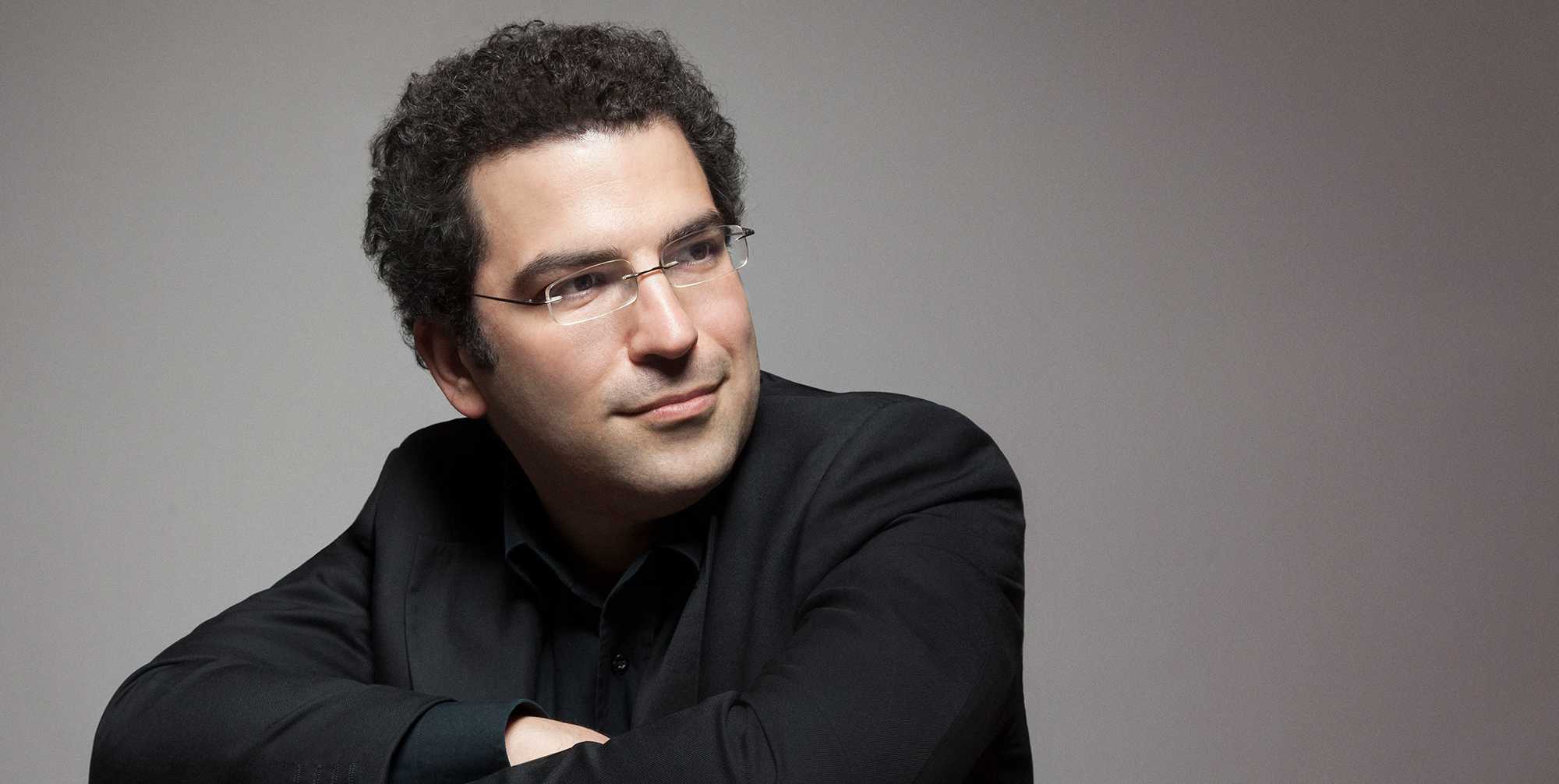
Lucie Horsch, recorder
Concerto de’ Cavalieri
Marcello Di Lisa, conductor
VIOLONS
Paolo Perrone
Antonio De Secondi
Gabriele Pro
Katarzyna Solecka
Gabriele Politi
Giancarlo Ceccacci
VIOLA
Ettore Belli
CELLO
Luca Peverin
BASSOON
Maria De Martini
COUNTERBASS
Luca Cola
HARPSICHORD
Marco Silvi
FULGURANCES
A selection of pyrotechnic masterworks from the Italian Baroque!
Featuring the outstanding young virtuoso Lucie Horsch, Concerto de’ Cavalieri invites the audience to a journey into the recorder repertoire – one of the main solo instruments in the 17th and 18th century music – within the Italian Baroque and its leading masters: Antonio Vivaldi (1678-1741), who alone represents the style and the aesthetics of the Venetian Baroque; Arcangelo Corelli (1653-1713), one of the most celebrated authors of the Roman school; and the Milanese composer Giuseppe Sammartini (1695-1750), an authentic innovator of the concerto-form in his age and for many years an ambassador of Italian music in England at the “court” of Georg Friedrich Händel.
Tempestuous virtuosity and absolute modernity are actually undisputed characteristics of a programme focused on Vivaldi’s works and featuring in particular the vigorous Sinfonia in G major from the opera La Verità in cimento RV 739, the vibrant String Concerto in D major RV 121 and all the more the well-known Concertos No. 8 in A minor and No. 5 in A major both taken from L’Estro armonico Op. 3, that is one of the most significant collections of violin concertos in the entire Baroque era. The expert use of the solo concertante violin, the shaking rhythmic tension and the transparent linearity typical of Vivaldi’s style are indelible features of these pieces, which are also splendid examples of the blend between expressive singing and virtuosity.
On a different ground, the Concerto for flautino and strings RV 443 shows how much Vivaldi has been an active experimenter of the conceptual relationship between Music and Nature, and how thoroughly he explored the inmost possibilities of musical instruments in reconstructing the multiple natural atmospheres and nuances – in this case the birdsong, even though from an indirect point of view – through a sometimes bizarre use of effects or of technical devices. In this concerto, in fact, the virtuoso potential of the recorder is entirely aimed at an ideal representation and at a descriptive effort that is at the same time wonderfully “natural” and “artificial”.
In every note, anyway, all these pieces reveal, as the title of L’estro armonico collection also says, a daring spirit of experimentation and the most modern instrumental virtuosity, enduring features that propelled the Venetian school and the whole Baroque music into the mature 18th century, through a scintillating new style which was then considered revolutionary.
DOn the other hand, two renowned concertos by Sammartini and Corelli are included: a programme showing the musical power of the recorder should in fact not be regardless of Sammartini’s lively spirited Recorder Concerto in F major that clearly shows – so differently from the Vivaldi concertos – the fundamental evolution of baroque taste toward the galant style. This exquisitely written work is of great interest because of the simultaneous presence of clearly baroque forms and of others that are more rarefied, especially in terms of harmony. The result is a hybrid composition of noble charm, representative of the transitional phase that would soon overcome the old aesthetics.
On the contrary, Corelli’s Concerto Grosso in D major Op. 6 No. 4 is a masterwork entirely belonging to the Italian Baroque; with it, the Concerto Grosso reached the highest level of formal perfection and Corelli’s collection became indeed the undisputed model for that age and a reference for later composers. Characterized by a formal simplicity, this score represents an effective and extremely elegant example of the Roman style, including all its features and salient themes: magnificent atmospheres, pastoral calm, elegiac lyricism, alluring melodies.
Comment above: Marcello Di Lisa
Antonio Vivaldi
Sinfonia in G major from “La Verità in cimento” RV 739
Allegro – Andante – Allegro
Giuseppe Sammartini
Concerto in F major for recorder and strings
Allegro – Siciliano – Allegro assai
Antonio Vivaldi
Concerto for strings in D major RV 121
Allegro molto – Adagio – Presto
Antonio Vivaldi
Concerto in A minor from “L’estro armónico” op. 3 n. 8
Allegro – Larghetto e spiritoso – Allegro
Lucie Horsch, recorder, Paolo Perrone, violin
Arcangelo Corelli
Concerto grosso in D major Op. 6 n° 4
Adagio, Allegro – Adagio, Vivace – Allegro
Lucie Horsch, recorder, Antonio De Secondi, violin
Antonio Vivaldi
Concerto in A major for 2 violins and strings from “L’estro armónico”, op. 3 n. 5
Allegro – Largo – Allegro
Paolo Perrone, Antonio De Secondi, violins
Antonio Vivaldi
Concerto in G major for flautino and strings RV 443
Allegro – Largo – Allegro molto
AMAZONE
TH 23 JUIN 2022
19 h 45 – 21 h 15
Salle de musique / avenue Léopold-Robert 27, La Chaux-de-Fonds
Jupiter Ensemble
Thomas Dunford
lute & artistic direction
Lea Desandre
mezzo-soprano
Jean Rondeau Portrait VI
Enregistré par RTS-Espace 2
To the newsletter “concert AMAZONE 23 June”
Relive the concert on Espace 2, program L’été des festivals
Lea Desandre, the Jupiter Ensemble and Thomas Dunford during the recording of Amazone, Erato/Warner Classics, September 2021.
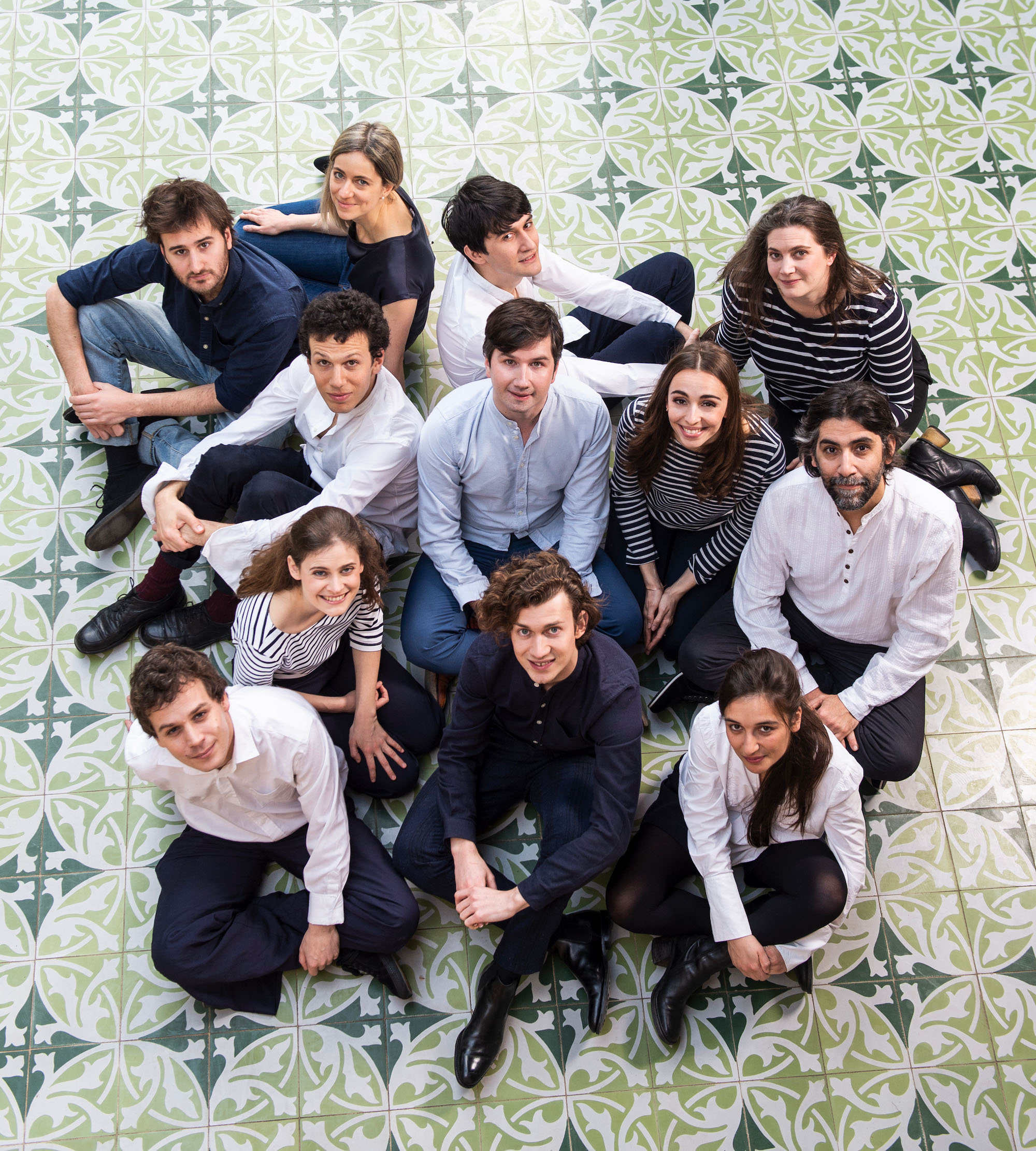
Thomas Dunford, lute and artistic direction
Lea Desandre, mezzo-soprano
Théotime Langlois de Swarte, violin
Louise Ayrton, violin
Jasper Snow, alto
Cyril Poulet, cello
Salomé Gasselin, viola da gamba
Elodie Peudepièce, doublebass
Jean Rondeau, harpsichord
Keyvan Chemirani, percussion
AMAZONE
For her first solo recital on disc, rising star Lea Desandre faithfully surrounds herself with the musicians of Jupiter, with whom she has collaborated since the Ensemble’s inception. The Amazons will be featured in a Franco-Italian program, the artist’s nationalities, crossing the baroque repertoire with numerous world rediscoveries.
The figures of the Amazons were a great source of inspiration for 18th century composers. We then find in their works recurring female characters: queens (Antiope, Mitilene, Hippolyte, Talestri, Marthésie) or androgynous figures, both feminine and warlike. From the victorious laurels of war to the passions and amorous complaints, this programme is a dedication to these feminine and emblematic figures, and a journey into the state of mind and the state of being of these women warriors. This diversity of characters makes it possible to alternate very contrasting arias: lamenti, great lyrical scenes, war plays, tales of fury, recitatives, tender tunes, instrumental pieces.
Francesco PROVENZALE Lo schiavo di sua moglie “Non posso far”
Francesco CAVALLI Ercole Amante : Sinfonia Acte 1
Francesco PROVENZALE Lo schiavo di sua moglie “Lascatemi morire”
Giovanni Buonaventura VIVIANI Mitilene “Muove il pie fuorie d’averno”
Georg Caspar SCHÜRMANN Die Getreue Alceste : Sinfonia pour la tempête
Carlo PALLAVICINO L’Antiope “Vieni, corri”
Carlo PALLAVICINO L’Antiope “Sdegni furori barbari”
François-André Danican PHILIDOR Les Amazones : Marche – Thalestris – Marche
Marin MARAIS “L’américaine”
André-Cardinal DESTOUCHES Marthésie “Ô Mort ! Ô triste mort”
François COUPERIN Second livre des pièces de clavecin “L’Amazone”
André-Cardinal DESTOUCHES Marthésie “Quels coups me réservait la colère céleste”
Antonio VIVALDI Ercole sul Termodonte : 1er mouvement, Ouverture
Georg Caspar SCHÜRMANN Die Getreue Alceste (1719) “Non ha fortuna il pianto mio”
Antonio VIVALDI Ercole sul Termodonte (1723) : 2ème mouvement, Ouverture
Giuseppe DE BOTTIS Mitilene Regina delle Amazzoni (1707) “Lieti fiori”
Antonio VIVALDI Ercole sul Termodonte (1723) : 3ème mouvement, Ouverture
Antonio VIVALDI Ercole sul Termodonte (1723) : “Onde chiare che sussurate”
Antonio VIVALDI Ercole sul Termodonte (1723) : “Scendero, volero, gridero”
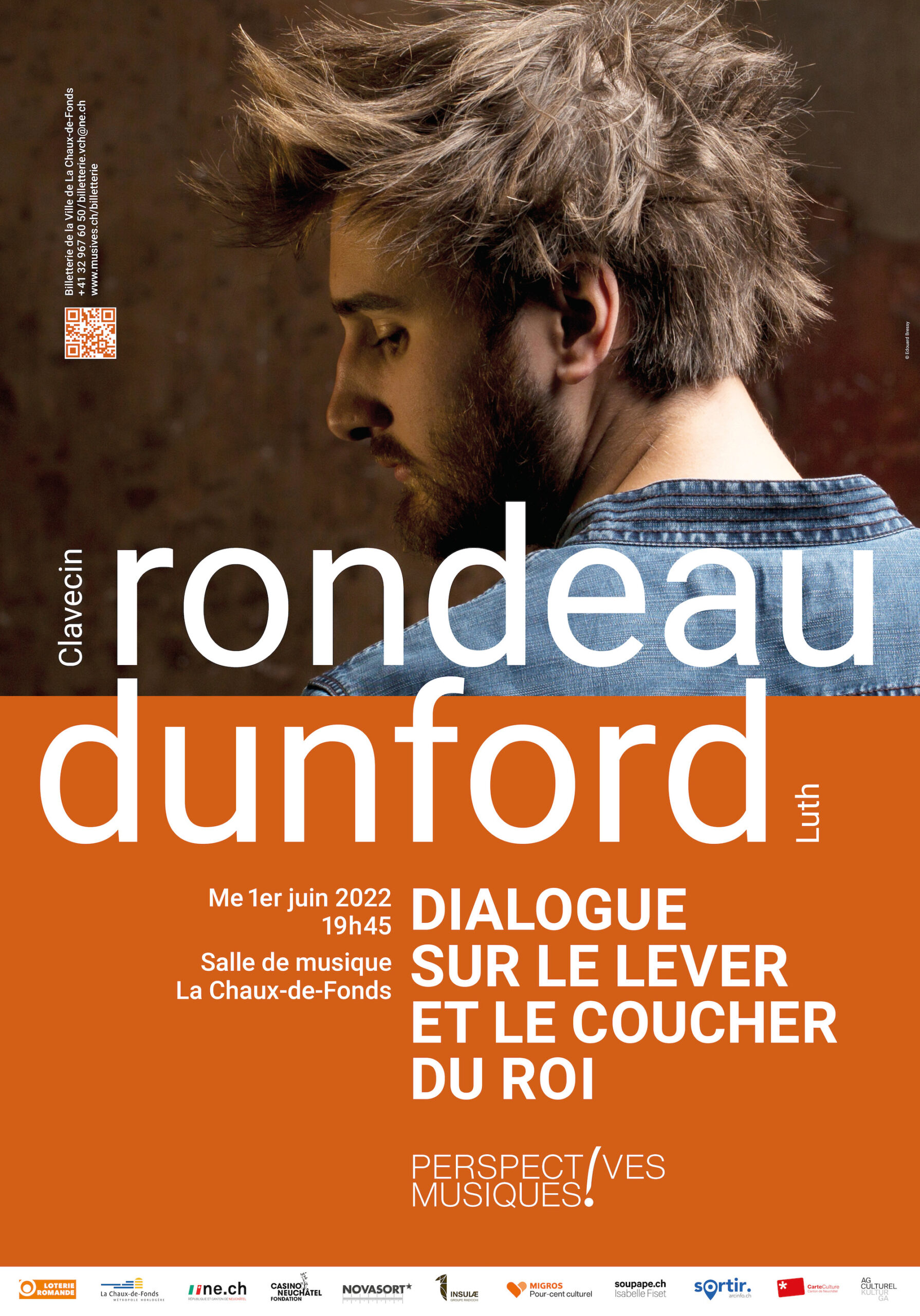
DIALOGUE ON THE RISING AND KING’S BEDTIME
WE 1 JUN 2022
19 h 45 – 21 h 15
Salle de musique / avenue Léopold-Robert 27, La Chaux-de-Fonds
Jean Rondeau harpsichord
Thomas Dunford luth
Jean Rondeau Portrait V
Ticketing
Thomas Dunford and Jean Rondeau during the recording of “Barricades”. Erato/Warner Classics.
DIALOGUE ON THE RISING AND KING’S BEDTIME
The reign of Louis XIV (from 1661 to 1715) was particularly rich artistically. A great lover of art in general, and music in particular, the king sang, played the guitar and had a strong taste for dancing. Music was omnipresent at court and accompanied both exceptional moments and daily rituals. From the Great Rising to Supper and Bedtime, the rigorous ceremonial that punctuated the monarch’s life gave rise to pieces by major players in the musical life of Louis XIV’s long reign.
Robert De Visée (v. 1650-1665 – après 1732)
Suite in D minor (lute and harpsichord)
Marin Marais (1656-1728)
Les Voix humaines, Lentement (from the Suite No. 3, Second book of viola da gamba and luth)
François Couperin (1668-1733)
Premier Prélude en do majeur (from L’Art de toucher le clavecin)
La Ménetou, Le Dodo ou l’amour au berceau, La Ténébreuse, La Favorite (lute and harpsichord)
Jean-Henry D’Anglebert (1629-1691)
Prélude (from the Suite in D minor, harpsichord)
Sarabande Grave (lute and harpsichord)
Antoine Forqueray (father, 1672-1745)
Jean-Baptiste Antoine Forqueray (fils, 1699-1745)
La Portugaise
La Sylva
Jupiter
(Lute and harpsichord)
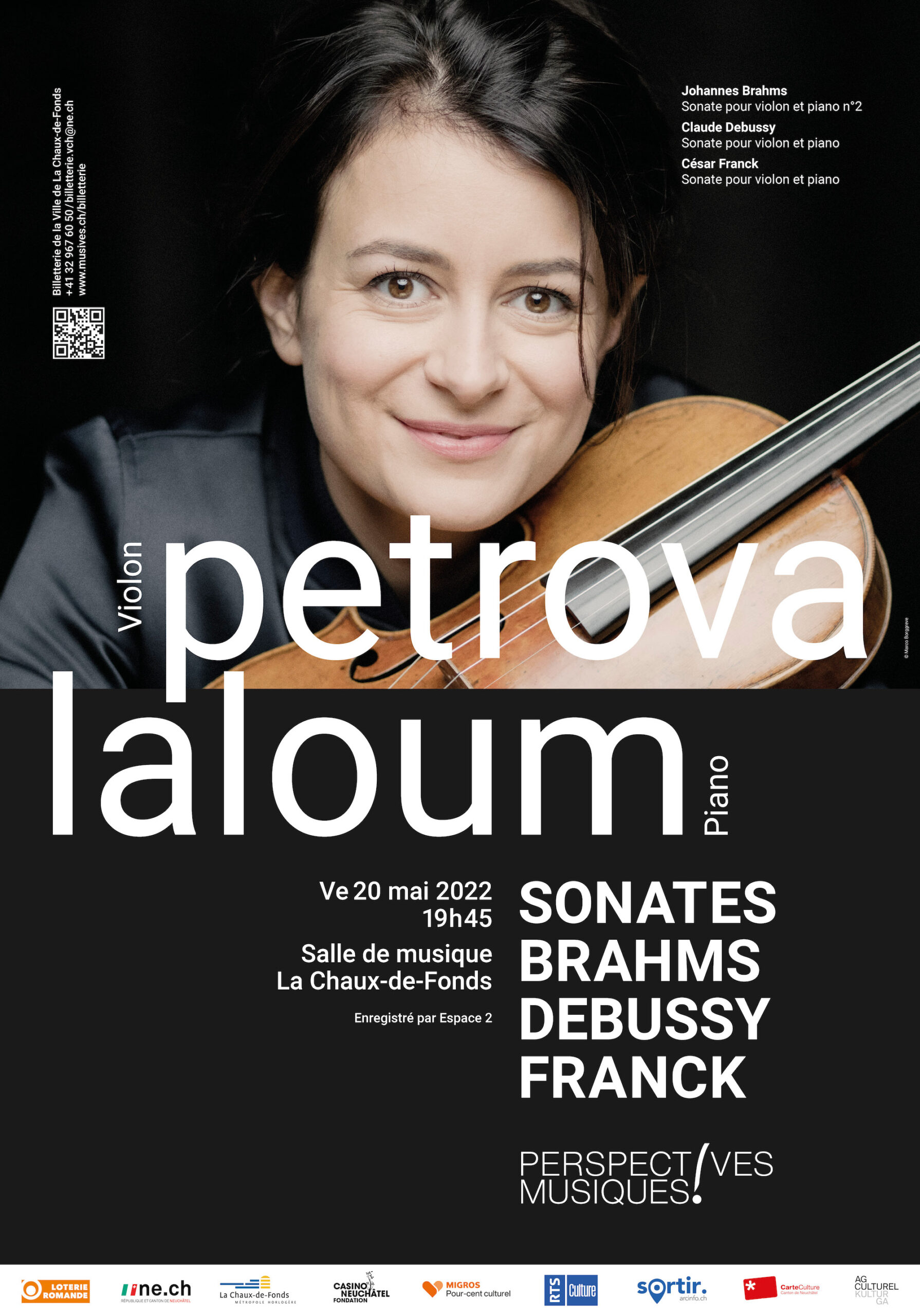
SONATES
FR 20 MAY 2022
7:45 pm – 9:45 pm
Salle de musique / avenue Léopold-Robert 27, La Chaux-de-Fonds
Liya Petrova violin
Adam Laloum piano
Enregistré par RTS-Espace 2
Ticketing
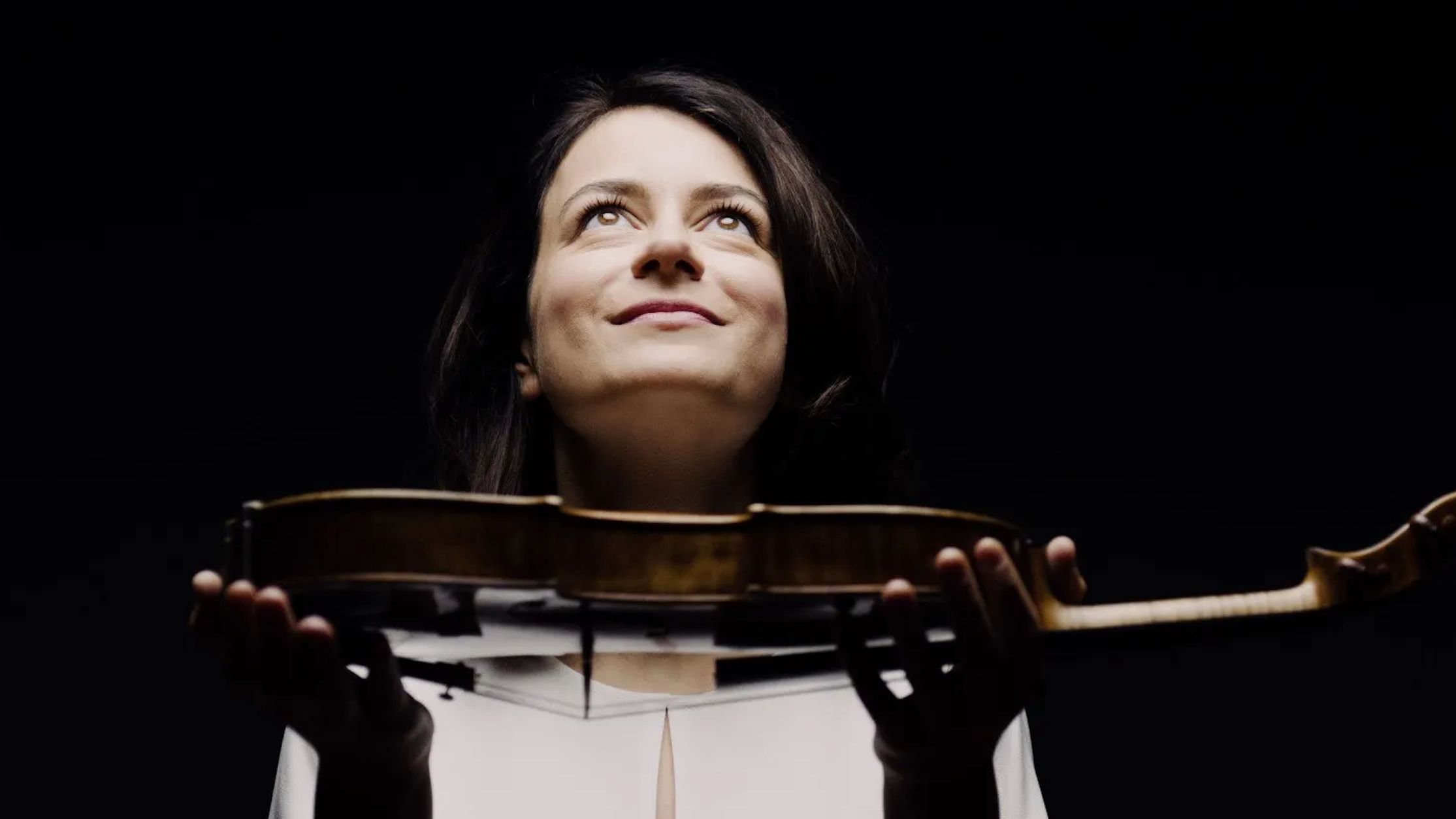
Perspectives Musiques welcomes the new pearl of the violin, Liya Petrova, 1st Prize of the Carl Nielsen Competition in 2016 and pianist Adam Laloum, 1st Prize of the Clara Haskil Competition in 2009 and winner in 2017 of the Victoires de la Musique in the category “Instrumentalist of the Year”. Together, they perform three masterpieces of the violin and piano repertoire: Johannes Brahms’ 2nd Sonata as well as Sonatas by Claude Debussy and César Franck.
SONATES
Johannes Brahms
Sonata for violin and piano no 2
Claude Debussy
Sonata for violin and piano
César Franck
Sonata for violin and piano
BACH PICCOLO
TU 3 MAY 2022
7:45 pm – 9:45 pm
Salle de musique / avenue Léopold-Robert 27, La Chaux-de-Fonds
Mario Brunello
Cello piccolo
Enregistré par RTS-Espace 2
Ticketing
BACH PICCOLO
A “piccolo” reading of Johann Sebastian Bach’s Sonatas and Partitas, to be lived as a new sound experience, as a journey to the borders of the imagination.
Mario Brunello, 1st Prize at the Tchaikovsky Competition in 1986, makes us rediscover the cello piccolo. Brunello plays a precious Maggini cello made in the early 1600s. In recent years, however, he has become increasingly fond of the “piccolo cello”. The piccolo cello – as the name suggests – is a smaller version of the cello. It shares the tuning of a violin, while retaining much of the resonance and depth of the cello. Brunello has exploited the full potential of this instrument in revealing performances of the baroque violin repertoire, focusing on the masterpieces of Bach, Vivaldi and Tartini.
Johann Sebastian Bach
Sonata No. 1 in G minor for violin BWV 1001
Partita No. 1 in B minor for violin BWV 1002
Partita No. 2 in D minor for violin BWV 1004
VARIATIONS GOLDBERG
MA 15 MARS 2022
19 h 45 – 21 h 15 (sans pause)
Salle de musique / avenue Léopold-Robert 27, La Chaux-de-Fonds
Jean Rondeau harpsichord
J.S. Bach, Variations Goldberg
Jean Rondeau Portrait IV
Ticketing
J.S. BACH
VARIATIONS GOLDBERG BWV 988
Aria
Variations 1 à 30
Aria da capo
« Bach tient tout entier dans les Variations Goldberg… toute sa musique y est présente… et c’est une œuvre que je vais, sans nul doute, explorer jusqu’à la fin de mes jours »
Jean Rondeau
Impatience est le mot qui convient le mieux pour qualifier le sentiment actuel du public adepte de grands événements, dans l’attente de l’interprétation prochaine par Jean Rondeau de l’un des sommets incontestés dans l’immense production de Bach : les Variations Goldberg, publiée, en 1742, au soir de la vie du compositeur. Non moins attendue, la version discographique de l’œuvre vient de sortir chez le label Erato / Warner Classics. Jean Rondeau signera son nouveau disque à l’issue du concert.
On a longtemps soutenu que les Variations Goldberg avaient été composées à l’intention du comte von Keyserling, ancien ambassadeur de Russie auprès de la cour de Saxe. « Souffrant d’insomnies et ne trouvant de véritable apaisement que dans la musique, c’est pour combler le vide de ses nuits sans sommeil » qu’il aurait adressé cette commande à Bach, mission étant donnée à son protégé, un jeune claveciniste du nom de Goldberg, lui-même formé à l’école des Bach, de lui administrer quotidiennement cette œuvre à titre de cure neuro-musicale. S’il s’agit en fait plutôt d’une légende, l’histoire est jolie et une petite part de vérité y subsiste tout de même, puisqu’on rapporte que Bach offrit au comte un exemplaire des Variations, que celui-ci fut enthousiasmé par cette musique et qu’il en récompensa le compositeur par une coupe en or.
« Une ode au silence » : c’est ainsi que le claveciniste Jean Rondeau définit les Variations Goldberg de Bach. « Je considère qu’elles furent écrites pour le silence, en ce sens qu’elles se substituent au silence ». Dans la phase préparatoire de cet enregistrement, Jean Rondeau a consulté une édition conservée à la Bibliothèque Nationale comportant des annotations qui sont de la main même de Bach. « Me plonger dans ce document précieux m’a aidé à faire les choix que j’ai ressentis comme les plus authentiques ». Jean Rondeau exécute ce corpus de variations dans sa forme la plus complète, en effectuant toutes les reprises et en distillant des silences mûrement pensés.
Source paragraphe 3 : musicologie.org
AMINTA E FILLIDE
SA 15 JAN 2022
19 h 45 – 21 h 15 (sans pause)
Salle de musique / avenue Léopold-Robert 27, La Chaux-de-Fonds
Ticketing
Enregistré par RTS-Espace 2
Concert unique en Suisse
Les Arts Florissants
William Christie direction et clavecin
Ana Vieira Leite soprano (Aminte)
Shakèd Bar mezzo-soprano (Fillide)
Emmanuel Resche violon
Théotime Langlois de Swarte violin
Sophie de Bardonnèche alto
Félix Knecht violoncelle
Joseph Carver contrebasse
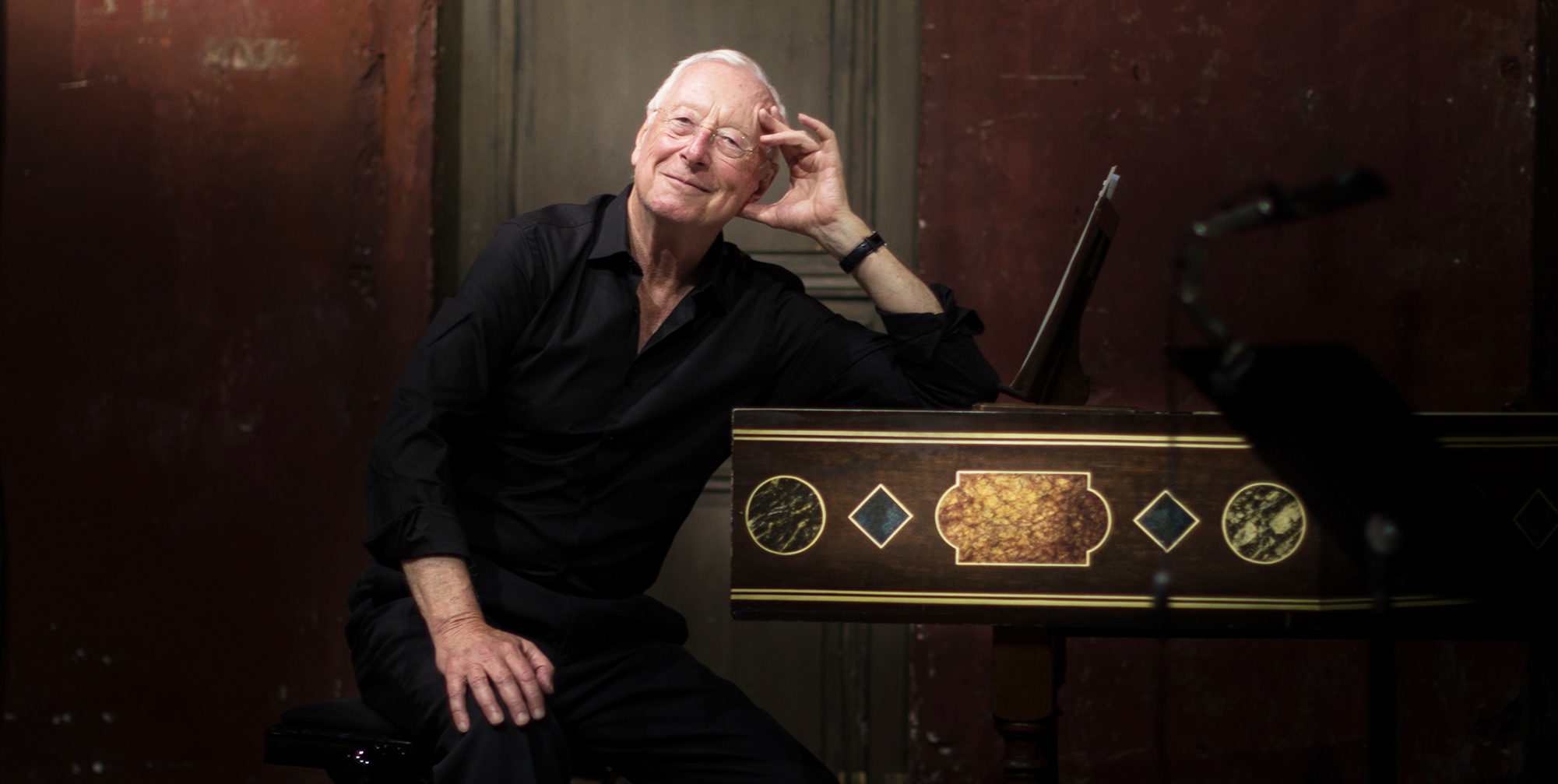
AMINTA E FILLIDE
Georg Friedrich Haendel
Sonate en trio en ut mineur HWV 386a (11′)
Duetto da Camera “No, di voi non vo’ fidarmi” HWV 189 (6′)
Sonate en trio en si bémol majeur HWV 388 (12′)
Aminta e Fillide, HWV 83 (50′)
Aminta e Fillide a été composé à Rome au début du 18e siècle par un jeune Georg Friedrich Haendel. Près d’une heure durant, ce petit bijou décrit les assauts amoureux du jeune berger Aminta (Ana Vieira Leite), auxquels résiste la nymphe Fillide (Shakèd Bar) jusqu’à ce que Cupidon, dieu de l’amour dans la mythologie romaine, ne s’en mêle. Certains airs de Aminta e Fillide ont été réutilisés par Haendel dans des opéras ultérieurs, notamment Agrippina (1709) et Rinaldo (1711), ce qui confère à l’oeuvre un air familier malgré ses rares apparitions sur la scène musicale.
Une histoire pour rêver un peu.
Nous en avons tant besoin.
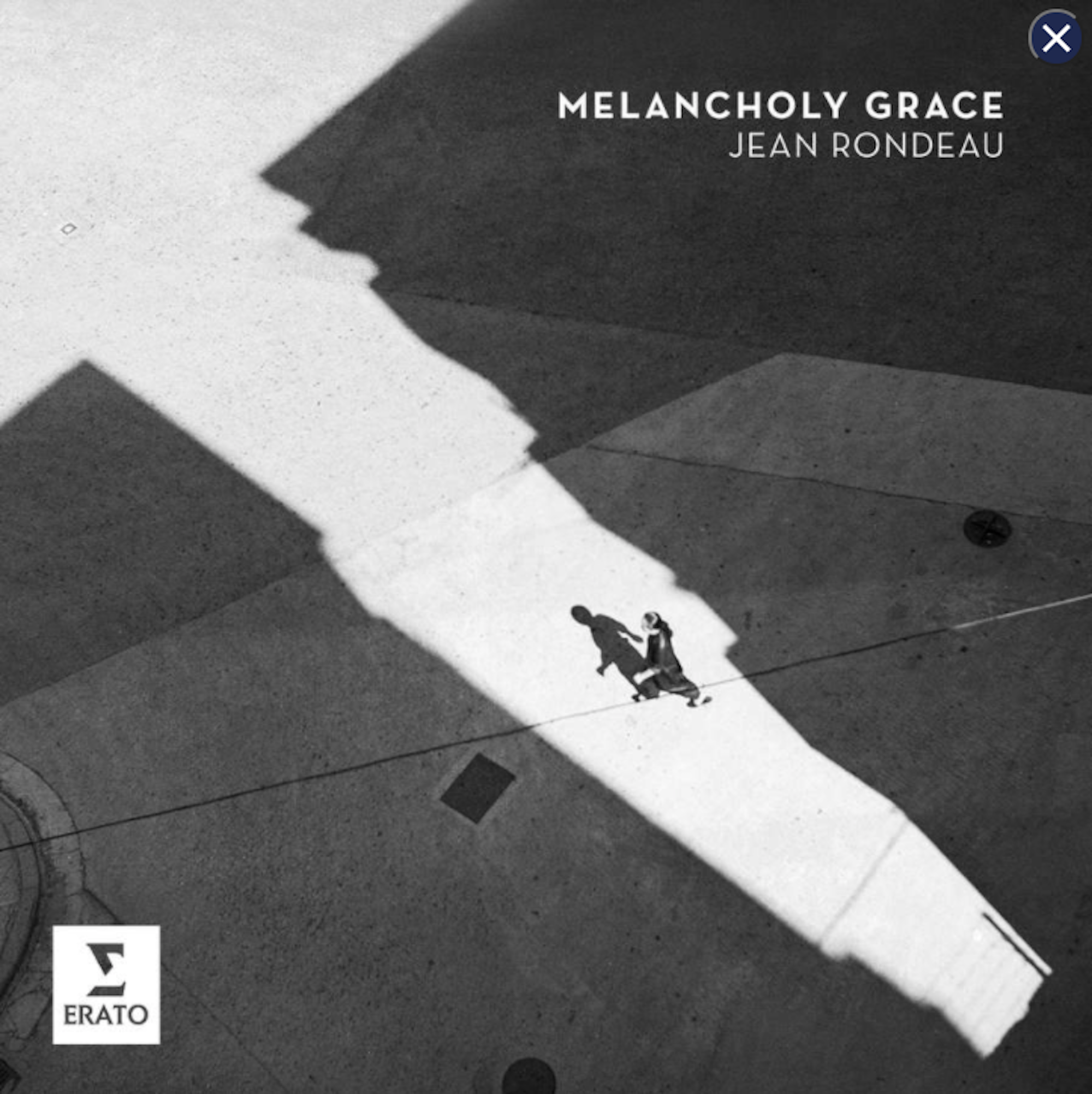
MELANCHOLY GRACE
JE 11 NOV 2021
19 h 45 – 21 h 15
Salle de musique / avenue Léopold-Robert 27, La Chaux-de-Fonds
Jean Rondeauclavecin italien
Jean Rondeau Portrait III
Recorded by Espace 2
En collaboration avec le Club 44, le Nouvel Ensemble Contemporain et le Centre de culture ABC
MELANCHOLY GRACE
Titre également de l’album sorti chez Erato Warner Classics en mai 2021.
“Ces sons équivoques se réfléchissant, se faisant écho, font tinter les clochettes de l’affect, dans le cosmos musical. Serait-ce le rêve qui m’a amené à cet album ? Entendre par-dessus les siècles d’histoire et d’habitude la musique des compositeurs de la Renaissance tintinnabuler au coeur de la nuit, comme l’écho délicat d’étoiles depuis longtemps passées qui nous éclairent encore.”
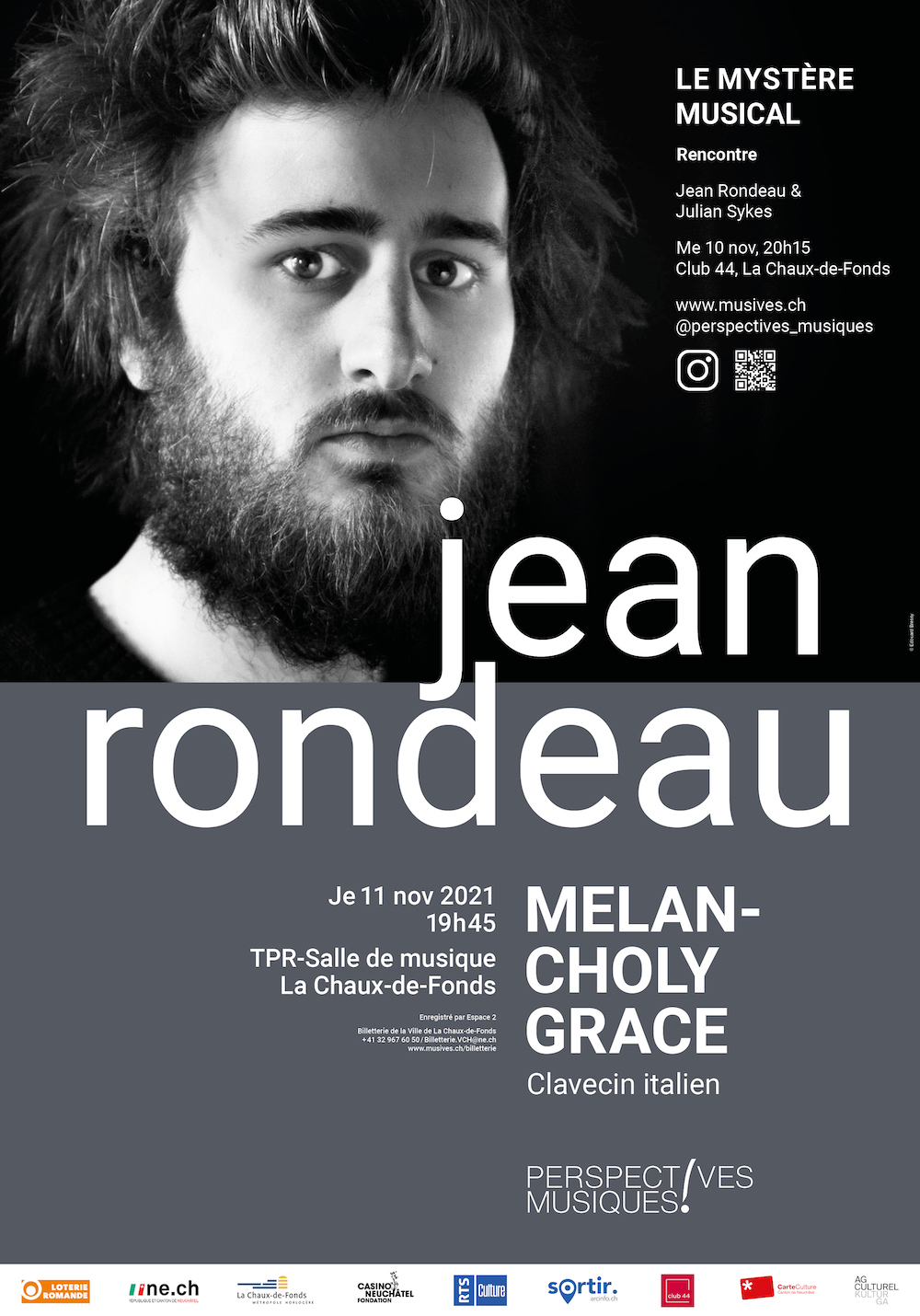
Girolamo Frescobaldi (1583 – 1643)
Toccata Settima
The second book of Toccatas, Canzoni etc. 1637
Laurencinius di Roma ? (v. 1567 – v. 1625)
Fantaisie de Mr. de Lorency
Manuscrit Bauyn, c. 1660
Luigi Rossi ? (v. 1597 – 1653)
Passacaille Del Seigr. Louigi
Manuscrit Bauyn, c. 1660
Orlando Gibbons (1583 – 1625)
Pavana (CCXCII.) in A minor based on Lachrymae
Giovanni Picchi (v. 1571 – 1643)
Ballo alla Polacha con il suo Saltarello – I
Intavolatura di Balli d’Arpicordo (Venise 1618)
John Bull (v.1562 – 1628)
Melancholy Pavan
Melancholy Galliard
Anonyme, attribué à Heinrich Scheidemann (1595 – 1663)
Pavana Lachrymae d’après Dowland WV 106
Giovanni Picchi (v. 1571 – 1643)
Ballo alla Polacha con il suo Saltarello – II
Intavolatura di Balli d’Arpicordo (Venise 1618)
Luzzasco Luzzaschi (1545 – 1607)
Toccata del 4° Tono
Bernardo Storace (v. 1637 – v. 1707)
Recercar di Legature
Selva di varie compositioni d’intavolatura per cimbalo ed organo (Venezia, 1664)
Girolamo Frescobaldi (1583 – 1643)
Toccata Quarta
The first book of Toccatas, Partitas etc. 1637
Giovanni Picchi (v. 1571 – 1643)
Ballo alla Polacha con il suo Saltarello – III
Intavolatura di Balli d’Arpicordo (Venezia 1618)
Antonio Valente (1520? – après 1580)
Sortemeplus, con alcuni fioretti (Sortez mes pleurs) d’après Philippe de Monte
Intavolaturo De Cimbalo (Napoli, 1578)
Gregorio Strozzi (1615 – 1687)
Toccata quarta per l’elevatione
Capricci da sonare cembali et organi (Napoli 1687)
Jan Pieterszoon Sweelinck (1562 – 1621)
Fantasia Chromatica
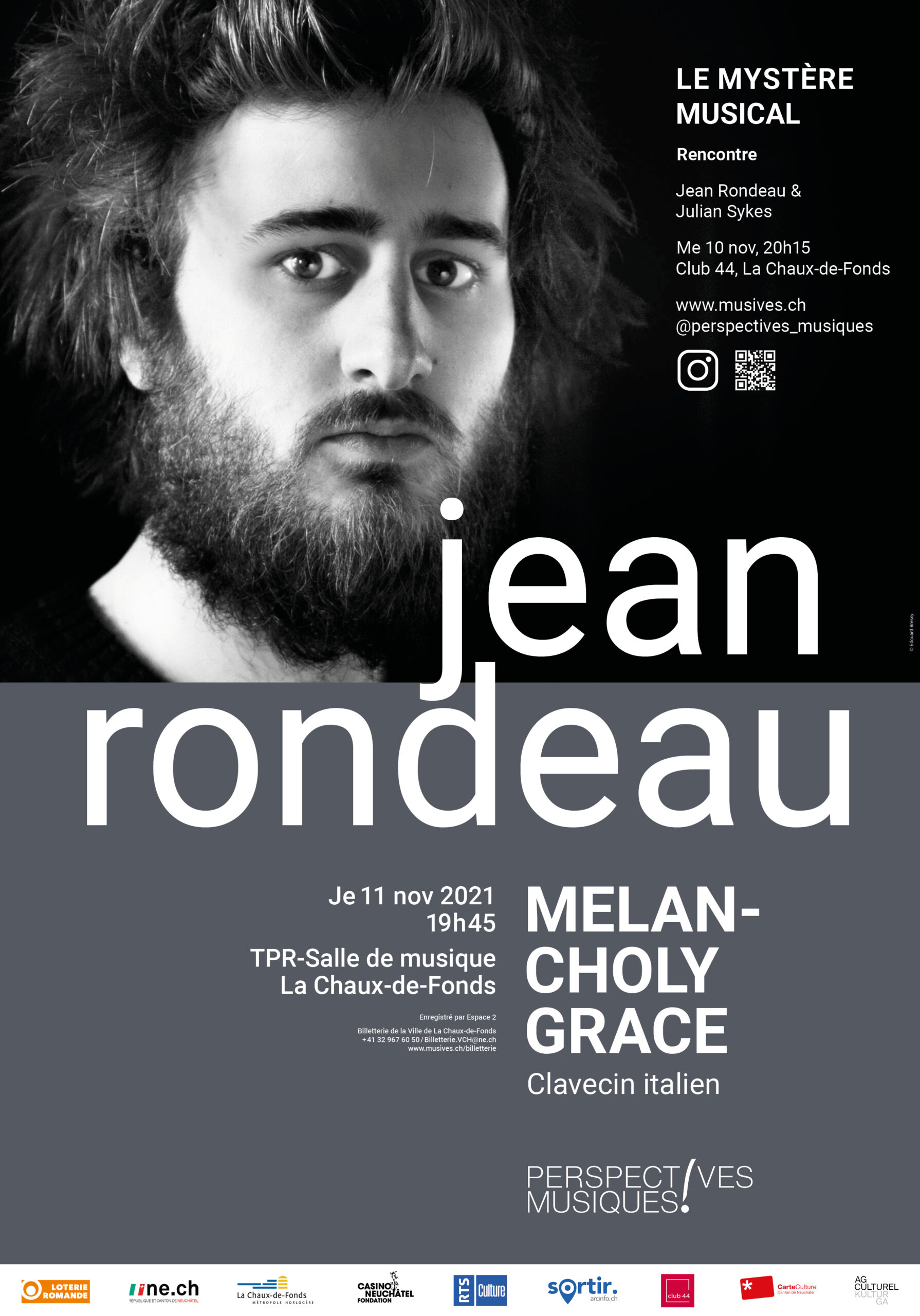
LE MYSTERE MUSICAL
ME 10 NOV 2021
8:15 pm – 9:45 pm
Club 44 / rue de la Serre 64, La Chaux-de-Fonds
Jean Rondeau & Julian Sykes
Rencontre
Jean Rondeau Portrait II
LE MYSTERE MUSICAL
Un doute vivant comme ligne de crête
« Sachez ne pas me savoir » écrit Jean Rondeau dans le livret de son dernier album Melancholy Grace, donnant la parole à la Musique qui, pourtant, comme il le décrit, ne se lie peut-être à notre vocable que par le biais du silence.
Il s’agira ici de tourner autour de différents thèmes tels que l’interprétation, le rapport au texte musical, le mystère musical, le concert et ses codes, les différents gestes musicaux, le mouvement, la pédagogie et, si le temps nous le permet, bien d’autres sujets encore, le tout sous la forme d’un échange improvisé.
Jean Rondeau nous dit que la musique n’est pas son moyen d’expression, mais bien l’expression de la musique elle-même. Il reste très attaché au verbe et à l’échange avec son public. Cette conversation permettra un autre contact, qu’il affectionne, et qui complétera le portrait de cette saison musicale qui s’annonce, on l’espère, joyeuse !

WOLFGANG &
THE JAZZ
MA 2 NOV 2021
7:45 pm – 9:45 pm
Salle de musique / avenue Léopold-Robert 27, La Chaux-de-Fonds
Quatuor Ebène
Martin Fröst clarinette
Concert recorded by RTS-Espace 2
CARL PHILIPP EMANUEL BACH
JE 21 OCT 2021
7:45 pm – 9:45 pm
Salle de musique / avenue Léopold-Robert 27, La Chaux-de-Fonds
Nevermind Quartet
Jean Rondeau Portrait I
Concert recorded by RTS-Espace 2
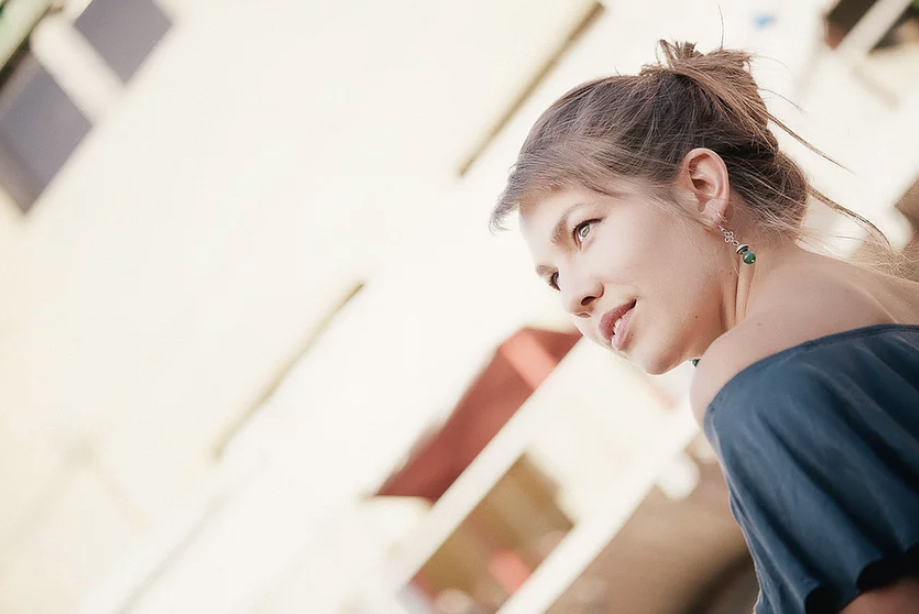
Mardi
11 MAI 2021
7:45 pm – 9:45 pm
Salle de musique / avenue Léopold-Robert 27, La Chaux-de-Fonds
Debussy in Resonance
Joanna Goodale
piano-gongs-bols
Concert YouTube-crowdfunding du 13 mars
Concert live (30min) de la pianiste franco-suisse Joanna Goodale sur Youtube. Elle y présente son 2e album en hommage à Debussy, financé en partie grâce à un crowdfunding WeMakeIt
L’enregistrement aura lieu à la Salle de musique de La Chaux-de-Fonds, en collaboration avec la RTS et My Big Geneva, avec le soutien de la Fondation Tempo et de nos fidèles partenaires.
« La musique est un art libre, un art jaillissant, un art de plein air, un art à la mesure des éléments, du vent, du ciel et de la mer! »
Claude Debussy, 1901
Debussy a réinventé le langage et le temps musical en s’inspirant librement de la Nature et des musiques d’Extrême-Orient. C’est dans la continuité de cette démarche que Joanna Goodale propose des créations mêlant le piano aux gongs et bols chantants, selon une trajectoire narrative au fil de l’eau.
Debussy in Resonance est une invitation à ressentir la Nature à travers l’univers de Debussy et les sonorités d’Asie, plongeant l’auditeur dans un éveil des sens, où la musique, l’imaginaire et les éléments ne font qu’un.
Programme du concert du 11 mai
Goodale
Opening bols & gongs
Debussy
Clair de Lune – Suite bergamasque
Goodale
In the Ocean piano & gongs
Debussy
La Cathédrale Engloutie – Préludes
Reflets dans l’eau – Images I
The snow is dancing – Children’s Corner
Goodale
After the Snow piano & bols & e-bows
Debussy
Jardins sous la Pluie – Estampes
Et la lune descend sur le temple qui fut – Images II
Goodale
In the Temple piano & gongs & bols
Debussy
Pagodes – Estampes
Goodale
In Resonance piano & gongs & bols & e-bows
Les créations de Joanna Goodale sont inspirées du langage musical de Debussy et des musiques sacrées d’Extrême-Orient avec l’utilisation de bols tibétains, de gongs chinois et d’effets mécaniques sur les cordes du piano (e-bow, patafix, percussion). L’idée de réunir le piano et les percussions d’Asie a été inspirée dans un premier temps par les musiques d’Alain Kremski, pianiste et compositeur.
Ces créations se trouvent à la croisée des cultures et des courants musicaux, entre tradition et recherche contemporaine. Ceux sont plus exactement des “comprovisations” où Joanna Goodale improvise à l’intérieur d’une structure plus ou moins définie et selon une narration qui s’insère dans le fil du programme:
Opening le silence s’habille de sons – écho d’un rituel
In the Ocean chants des baleines – profondeurs – mouvements de surface – écosystèmes fragilisés
After the Snow blanc sans fin – pas dans la neige – réveil des oiseaux – rayons de soleil – l’eau solide devient liquide – orage avant la pluie
In the Temple souvenir ressuscité – temple vivant – rituel – contemplation
In Resonance empreintes – mémoire cellulaire – eaux intérieure
Mardi
7 JUL 2020,
7:45 pm
Concert initialement prévu le 9 mai 2020.
19 h 45 – 21 h 45
Salle de musique / avenue Léopold-Robert 27, La Chaux-de-Fonds
Arod Quartet
Jordan Victoria, violin
Alexandre Vu, violin
Tanguy Parisot, viola
Samy Rachid, cello
« Va-t’en – Ah va-t’en loin de moi squelette cruel je suis encore jeune, laisse-moi ne me touches pas, chère mort. Donne-moi ta main, toi belle et tendre je viens en ami non pour te punir. Sois courageuse, je ne suis pas cruelle. Tu dormiras apaisée dans mes bras. »
Schubert
Quatuor n°4 en do majeur
Schubert
Quatuor n°12 en do mineur D 703
Schubert
La Jeune Fille et la Mort
Quatuor n°14 en ré mineur D 810
Vouloir comprendre Schubert, son lyrisme si particulier, mélange de candeur et de visions sombres, c’est commencer par s’immerger dans son univers matriciel : le lied romantique. Schubert donnera ce conseil : « A écouter en hiver, mais dans mes lieder, le printemps avec toutes ses fleurs est déjà présent ».
Cette dualité entre cendres et braises imprègne le monde poétique dans lequel Schubert vivait sa vraie vie. Au travers des textes populaires, mais surtout de poèmes de petits poètes (car à part Heine, et si peu Goethe, les grands poètes ont toujours rendu impuissants les musiciens), Schubert vit par procuration des vies et des amours à la dérive : lune blafarde, neige et hiver, ruisseau-tombeau, forêts blêmes, jeunes filles qui trahissent, sommeil et mort.
L’inspiration de Schubert est une errance dans ces mots qui le touchaient plus profond que les larmes, aussi le thème de la mort consolatrice était constant chez lui. Il pleuvait de la mort partout dans sa vie, et entre les deuils et ses œuvres mort-nées, Schubert s’était fait une philosophie douce et résignée sur le monde. D’autant plus que l’époque elle-même mélodramatique et morbide, était très portée sur la présence de la mort et son apprivoisement par la consolation. Le Quatuor à cordes en ré mineur a été achevé en mars 1824, en même temps que le Quatuor n° 13 en la mineur Rosamunde et que l’Octuor. Ces quatuors ont été portés ensemble après une grande période de doute et de stérilité.
Pianiste, mais aussi altiste Schubert aimait faire de la musique ensemble. La musique de chambre sera sa demeure. Schubert très tôt fit des quatuors, au moins cinq en 1813. Puis deux autres en 1814 et dans les années 1815-1816. Mais pendant plus de huit ans, de 1816 à 1824, il ne composera aucun quatuor. Il était ailleurs, immergé dans le foisonnement des lieder qui jaillissaient de lui sans retenue. Des projets avortés d’opéra lui prenaient aussi du temps.
Le retour à cette forme noble et austère qu’est le quatuor à cordes advint par le rappel à la fragilité de l’existence qui le frappa en 1824. À peine remis d’une très grave maladie vénérienne, comme par une promesse intérieure il se remit à la forme du quatuor, mais aussi à l’écriture de danses et de variations. Comme si la vie revenait.
Il voulait aussi aller vers des formes « supérieures », la symphonie : « J’ai composé deux quatuors… et je veux encore écrire car c’est seulement de cette façon que je pourrai me frayer un chemin vers la grande symphonie ». Mais ces quatuors presque jumeaux, Rosamunde et La Jeune fille et la Mort, sont encore du chant, du dépassement du chant. Ce quatuor n°14 ne sera exécuté en privé que deux ans plus tard, en 1826, et ne pourra jamais être publié du vivant de Schubert. La tonalité d’ensemble de ce quatuor est bâtie sur celle du lied « der Tod und das Mädchen » composé en février 1817, dont voici le texte de Matthias Claudius :
Va-t’en – Ah va-t’en loin de moi squelette cruel je suis encore jeune, laisse-moi ne me touches pas, chère mort. Donne-moi ta main, toi belle et tendre Je viens en ami non pour te punir Sois courageuse, je ne suis pas cruelle Tu dormiras apaisée dans mes bras.
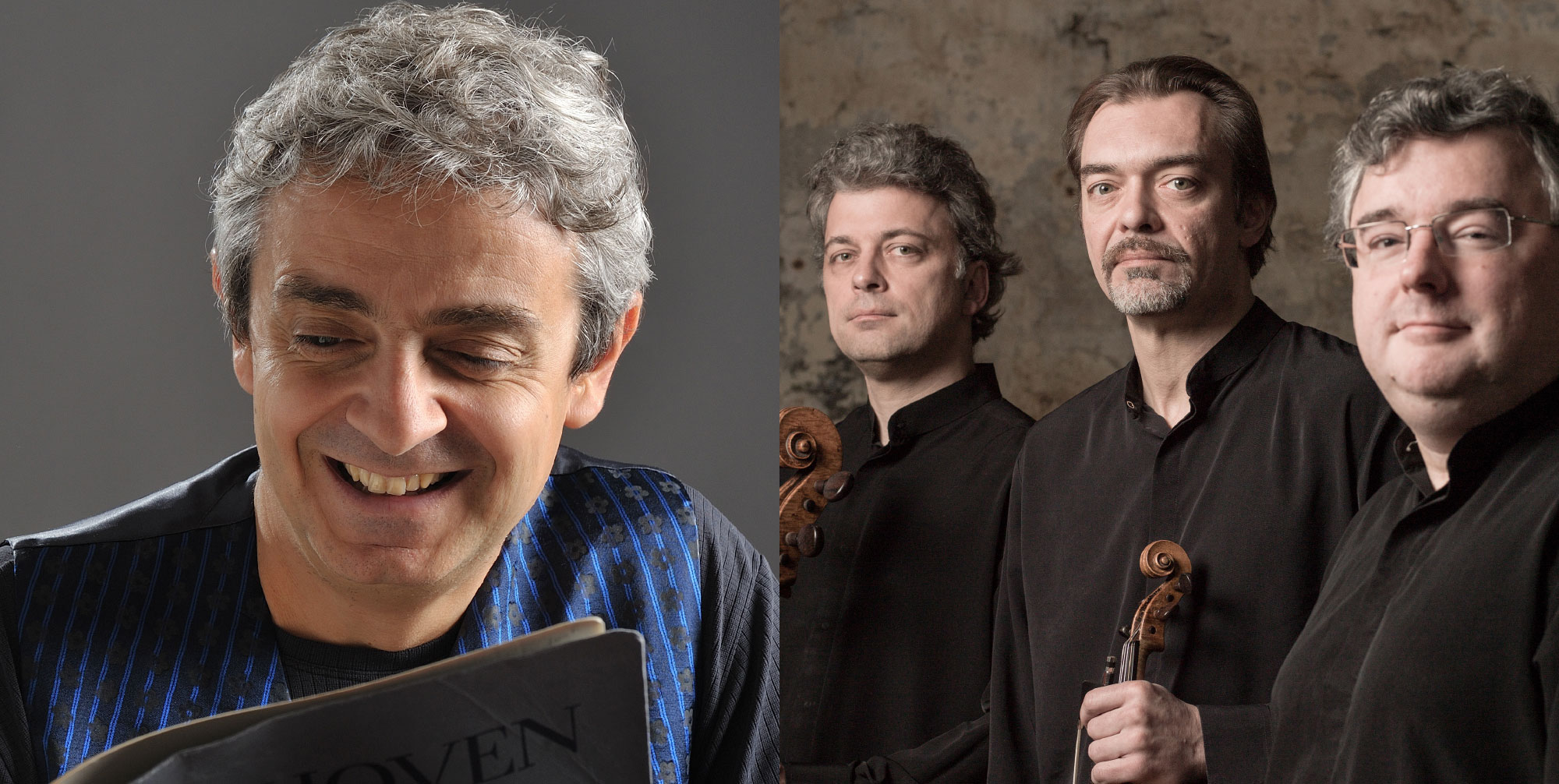
Dimanche
16 FÉV 2020
17 h 00 – 19 h 00
Salle de musique / avenue Léopold-Robert 27, La Chaux-de-Fond
Trio Wanderer
& Pascal Moraguès, clarinette
Vincent Coq, piano
Jean-Marc Phillips-Varjabédian, violon
Raphaël Pidoux, violoncelle
Pascal Moraguès, clarinette
Beethoven
Trio op. 11 pour clarinette, violoncelle et piano
Beethoven
« Trio des Esprits » pour violon, violoncelle et piano
Bartok
Contrastes, pour clarinette, violon et piano
Hindemith
Quatuor pour clarinette, violon, violoncelle et piano
Il y a 250 ans, en décembre 1770, naissait Ludwig van Beethoven. Sa musique allait toucher le coeur des humains. La postérité lui a donné une dimension universelle.
La première partie du concert rend hommage à la grandeur du musicien, de l’homme, non pas au sens égocentrique du terme, mais dans ce qu’il peut contenir d’universalité, d’humanité, de cœur, d’esprit et de paix.
Samedi
15 FÉV 2020
14h30 à 20h (accueil à 14h20)
Salle de musique / avenue Léopold-Robert 27, La Chaux-de-Fonds
Cours public d’interprétation par Pascal Moraguès aux élèves de clarinettes du Conservatoire de musique neuchâtelois-CMNE
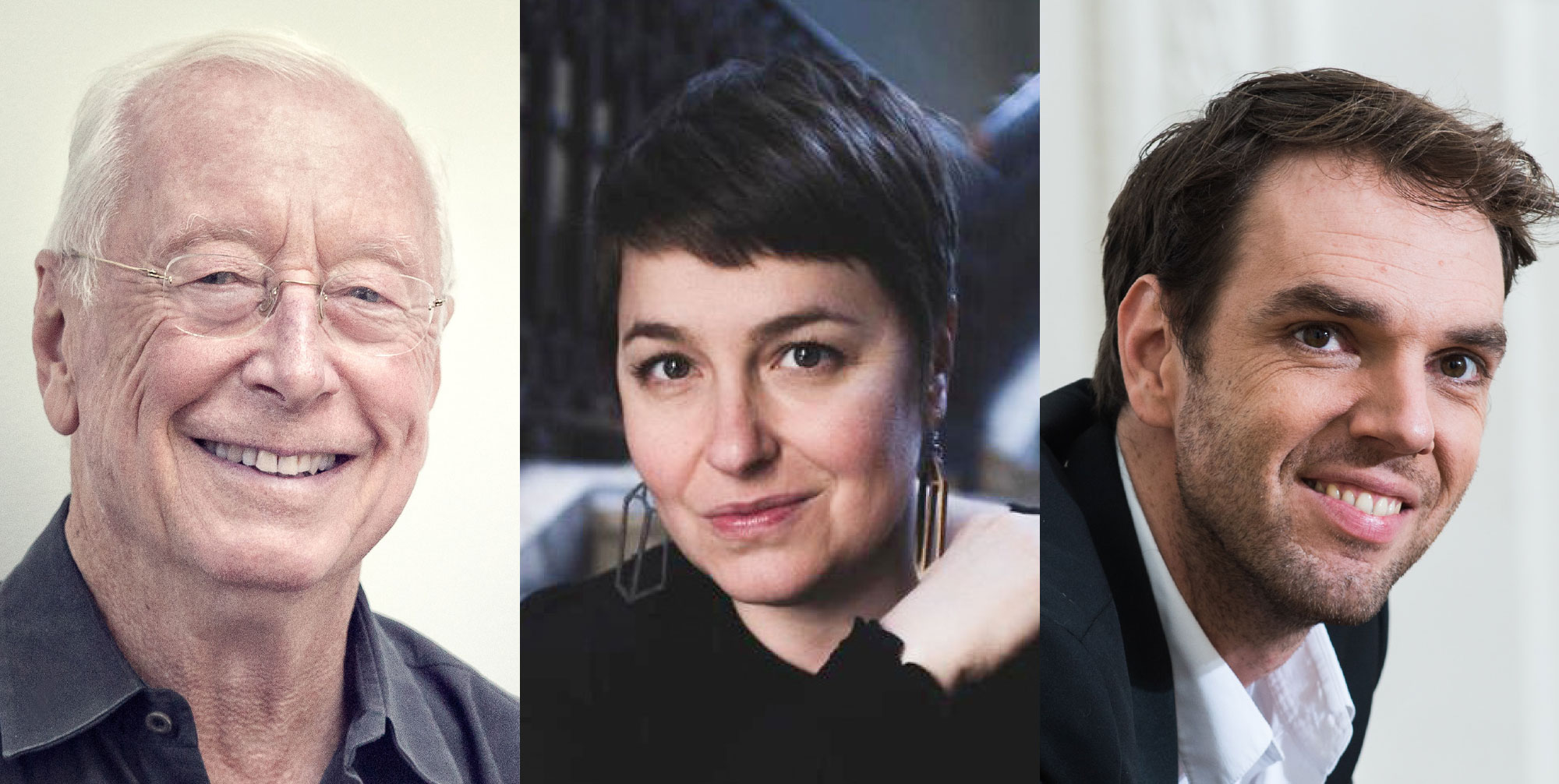
jeudi
30 JAN 2020
19 h 30 – 21 h 30
Salle de musique / avenue Léopold-Robert 27, La Chaux-de-Fonds
Les Arts Florissants
William Christie, direction musicale et clavecin
Emmanuelle de Negri, soprano
Thomas Dolié, baryton
Instrumentistes des Arts Florissants :
Violons : Emmanuel Resche, Théotime Langlois de Swarte
Viole de gambe: Juliette Guignard
Flûte traversière : Serge Saitta
Théorbe : Clément Latour
Emmanuel Resche-Caserta joue sur un violon de Francesco Ruggeri prêté par la Fondation Jumpstart Jr (Amsterdam)
Les Arts Florissants redonnent vie à l’une des plus brillants salons du Grand Siècle, un Salon constitué d’artistes et d’intellectuels rassemblés par l’une des femmes les plus puissante de son temps, la Duchesse du Maine dans son Château de Sceaux. Voltaire, D’Alembert, Montesquieu or Marivaux were all regular visitors, as well as well-known composers of the time, such as Clérambault, Bernier and Mouret; all of them wrote numerous works dedicated to her or inspired by her. And as the Duchess was insomniac, the evenings were long…
« Le Salon de la Duchesse »
sélection de Cantates séculaires
Nicolas Bernier (1664-1734)
Duo extrait de la Cantate « Europe et Jupiter »
(Cantates, Livre IV, 1739)
Jean-Joseph Mouret (1682-1738)
Premier concert, extraits :
Ouverture – Venissienne – Air – Rondeau – Sarabande – Tambourins I et II
(Concert de chambre pour les violons, flûtes, et hautbois (…), s.d.)
Louis-Nicolas Clérambault (1676-1749)
L’Amour piqué par une abeille
(Cantates, Livre I, 1710)
Jean-Joseph Mouret
Prens la pinte Claudeine
Du Dieu du vin quand tu chantes la gloire Buvons Enyvrons nous tous deux
(III° Livre d’airs sérieux et à boire, 1727)
Nicolas Bernier
L’Amour vainqueur
(Cantates, Livre VI, s.d.)
Jean-Joseph Mouret
Premier concert, extraits :
Chaconne (coupure de mesure 89 à mesure. 124)
(Concert de chambre pour les violons, flûtes, et hautbois (…), s.d.)
Nicolas Bernier
Diane et Endimion
( Cantates, Livre II, s.d.)
18 h 15 – 18 h 45 : avant-concert
Conservatoire de musique neuchâtelois, Salle Faller, La Chaux-de-Fonds
Elèves du Collège musical de la Ville de La Chaux-de-Fonds
Entrée libre
Jana Willi et Malika Naula, flûtes à bec, classe de Danièle Golan.
Avec la collaboration de Miriam Lubin clavecin et Marion Bélisle violoncelle
Marin Marais (1656-1728) de la Suite en mi mineur pour pour deux dessus et continuo : Prélude lentement – Fantaisie – Gavotte – Rondeau – Sarabande en rondeau – Menuet – Caprice lentement – Passacaille
Jacques Martin Hotteterre le Romain (1674-1763) Sonate en trio pour flûtes à bec et basse continue op 3 n°4 en sol mineur : Gravement – Fugue gay – Grave – Gigue
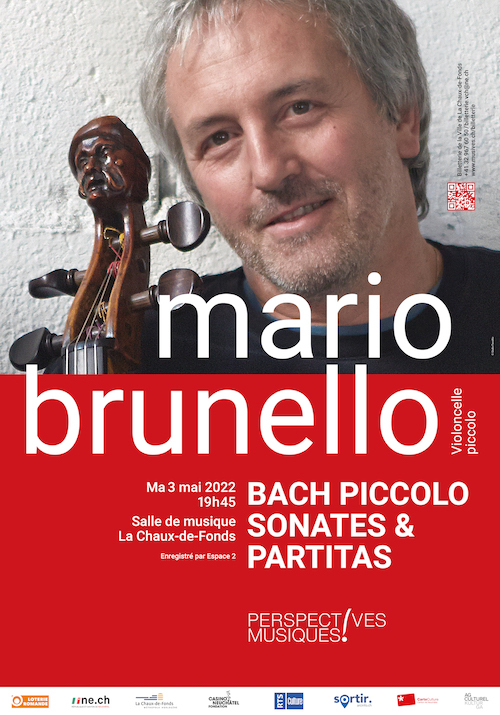
BACH PICCOLO
TU 3 MAY 2022
7:45 pm – 9:45 pm
Salle de musique / avenue Léopold-Robert 27, La Chaux-de-Fonds
Mario Brunello
Cello piccolo
Enregistré par RTS-Espace 2
Ticketing
BACH PICCOLO
A “piccolo” reading of Johann Sebastian Bach’s Sonatas and Partitas, to be lived as a new sound experience, as a journey to the borders of the imagination.
Mario Brunello, 1st Prize at the Tchaikovsky Competition in 1986, makes us rediscover the cello piccolo. Brunello plays a precious Maggini cello made in the early 1600s. In recent years, however, he has become increasingly fond of the “piccolo cello”. The piccolo cello – as the name suggests – is a smaller version of the cello. It shares the tuning of a violin, while retaining much of the resonance and depth of the cello. Brunello has exploited the full potential of this instrument in revealing performances of the baroque violin repertoire, focusing on the masterpieces of Bach, Vivaldi and Tartini.
Johann Sebastian Bach
Sonata No. 1 in G minor for violin BWV 1001
Partita No. 1 in B minor for violin BWV 1002
Partita No. 2 in D minor for violin BWV 1004
